Seiko Epson WN6501C 802.11a/b/g Module User Manual Epson 2
Seiko Epson Corporation 802.11a/b/g Module Epson 2
Contents
Epson User Manual 2
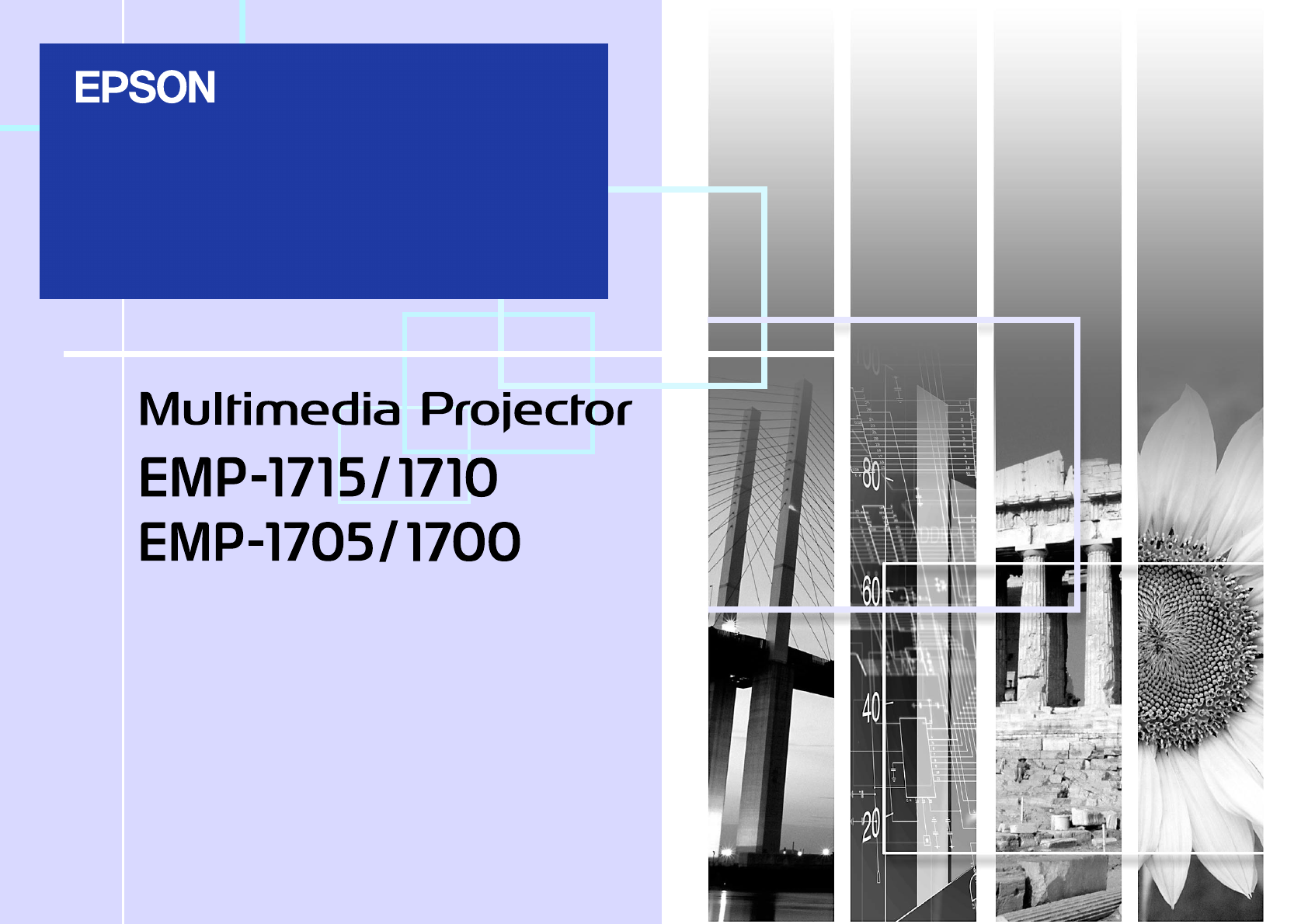
1
User’s Guide
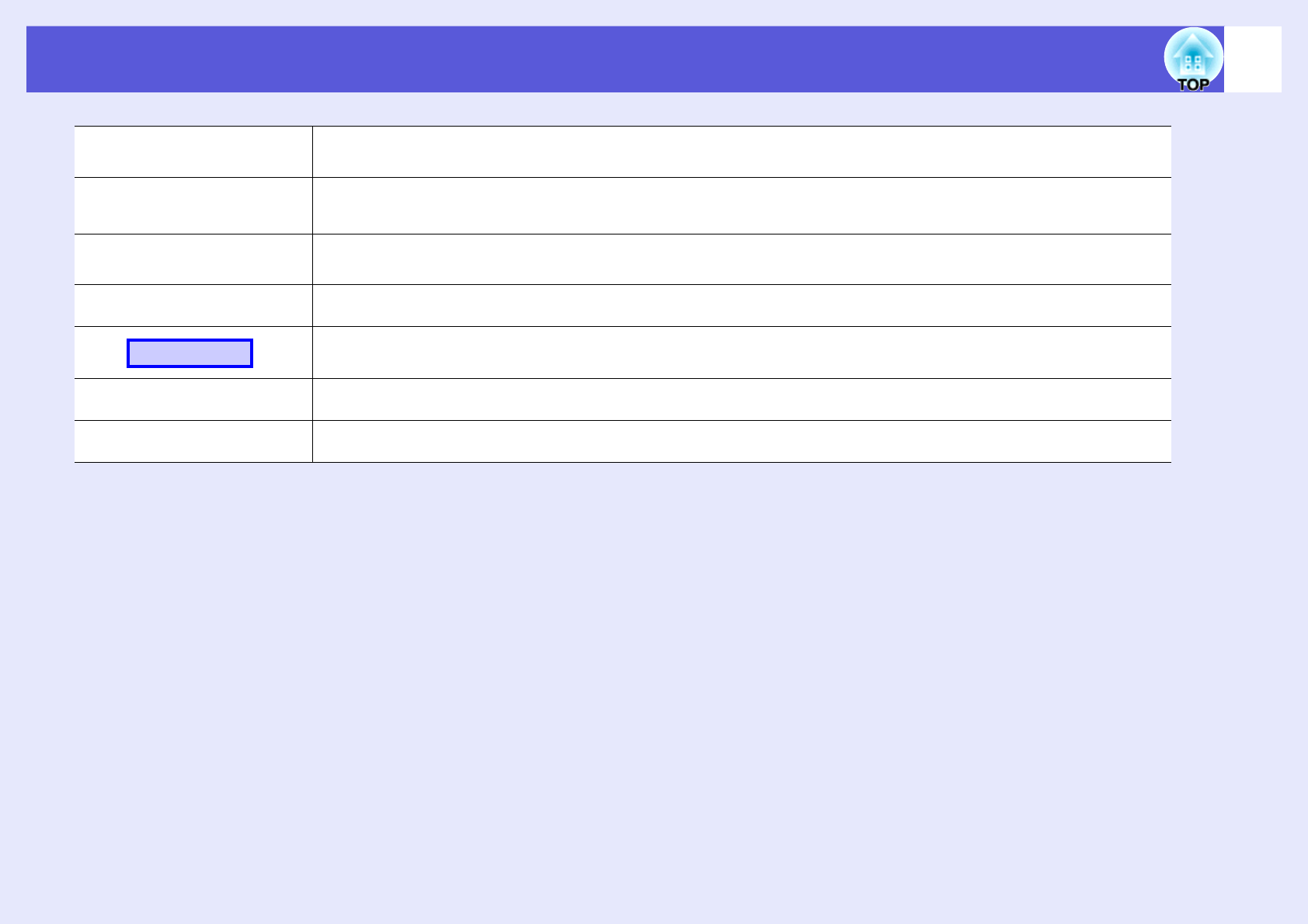
2
Notations Used in This Guide
Attention Indicates procedures which may result in damage or injury if sufficient care is not taken.
qIndicates additional information and points which may be useful to know regarding a topic.
sIndicates a page where detailed information regarding a topic can be found.
gIndicates that an explanation of the underlined word or words in front of this symbol appears in the glossary of terms. See
the "Glossary" section of the "Appendices". sp.65
Indicates operating methods and the order of operations.
The procedure indicated should be carried out in the order of the numbered steps.
[ (Name) ] Indicates the name of the buttons on the remote control or the control panel.
Example: [Esc] button
"(Menu Name)" Indicates configuration menu items.
Example: "Image" - "Brightness"
Procedure

3
Contents
Projector Features......................................................................................4
EMP-1715/1705 only............................................................................................ 5
Part Names and Functions ........................................................................6
Front/Top.............................................................................................................. 6
Control Panel ....................................................................................................... 7
Rear ..................................................................................................................... 8
Base ..................................................................................................................... 9
Remote Control .................................................................................................. 10
Useful Functions
Changing the Projected Image................................................................13
Automatically Detect Incoming Signals and Change the Projected Image
(Source Search) ................................................................................................. 13
Changing Directly from the Remote Control ...................................................... 14
Functions for Enhancing Projection.......................................................15
Selecting the Projection Quality (Selecting Colour Mode) ................................. 15
Hiding the Image and Sound Temporarily (A/V Mute) ....................................... 16
Freezing the Image (Freeze).............................................................................. 17
Changing the Aspect Ratiog (Resize) ................................................................17
Pointer Function (Pointer) .................................................................................. 18
Enlarging Part of the Image (E-Zoom) ............................................................... 19
Using the Remote Control to Operate the Mouse Pointer (Wireless Mouse)..... 20
Adjusting Colour for Several Projectors (Multi-Screen Colour
Adjustment)...............................................................................................23
Summary of Adjustment Procedure ................................................................... 23
Setting Screen ID ............................................................................................... 23
Image Correction Method...................................................................................24
Security Functions ...................................................................................26
Managing Users (Password Protect) ................................................................. 26
Restricting Operation (Operation Lock).............................................................. 29
Configuration Menu
Using the Configuration Menu ................................................................31
List of Functions.......................................................................................32
Image Menu ....................................................................................................... 32
Signal Menu ....................................................................................................... 33
Settings Menu .................................................................................................... 34
Extended Menu .................................................................................................. 35
Network Menu (EMP-1715/1705 Only) ..............................................................37
Info Menu (Display Only).................................................................................... 38
Reset Menu........................................................................................................ 39
Troubleshooting
Using the Help .......................................................................................... 41
Problem Solving....................................................................................... 42
Reading the Indicators....................................................................................... 42
When the Indicators Provide No Help................................................................ 45
Appendices
Installation Methods ................................................................................ 53
Cleaning .................................................................................................... 54
Cleaning the Projector's Surface ....................................................................... 54
Cleaning the Lens.............................................................................................. 54
Cleaning the Air Filter and Air Intake Vent......................................................... 54
Replacing Consumables ......................................................................... 55
Replacing the Remote Control Batteries ........................................................... 55
Replacing the Lamp........................................................................................... 56
Replacing the Air Filter ...................................................................................... 59
Saving a User’s Logo............................................................................... 60
Screen Size and Distance........................................................................ 62
Connecting to External Equipment ........................................................ 63
Connecting to External Speakers ...................................................................... 63
Optional Accessories and Consumables .............................................. 64
Glossary.................................................................................................... 65
List of ESC/VP21 Commands.................................................................. 67
Command List.................................................................................................... 67
Cable Layouts.................................................................................................... 67
USB Connection Setup...................................................................................... 68
PJLink (EMP-1715/1705 only).................................................................. 69
List of Supported Monitor Displays ....................................................... 70
Specifications........................................................................................... 71
Appearance............................................................................................... 74
Index.......................................................................................................... 75

4
Projector Features
B5 file size (19.3 cm deep, 27.3 cm wide, and 6.8 cm high) with a light
and compact body (1.6 to 1.7 kg*)
Carrying is also easy as there is a special pocket for storing cables and so
on in the soft carrying case supplied with the projector. sp.71
* EMP-1715/1705: 1.7 kg, EMP-1710/1700: 1.6 kg
You can disconnect the projector's power cable without having to wait for
the projector to cool down first.
fWhen you turn the projector power on and off a "Beep"
sounds
A "Beep" sounds when the power is turned on, after the cooling down
period has finished the confirmation buzzer beeps twice. Once you hear
the confirmation buzzer beep twice, you can unplug the power cable.
fA single foot design means you do not have to make any
difficult leveling adjustments
You can easily make height
adjustments with one hand. sQuick
Start Guide
fThe A/V mute slide makes it easy to project and store
You can stop and resume projection
easily by opening and closing the A/V
mute slide which makes giving clear
presentations easier.
fEasy to use control panel
For ease of use, buttons are classified
and arranged according to their
projection and adjustment functions.
sp.7
fPassword Protect to restrict and manage users
By setting a password you can restrict who can use the projector. sp.26
fOperation Lock restricts button operation on the control
panel
You can use this to prevent people changing projector settings without
permission at events, in schools, and so on.
Small and light
No cool down delay
Ease of use
Security Functions
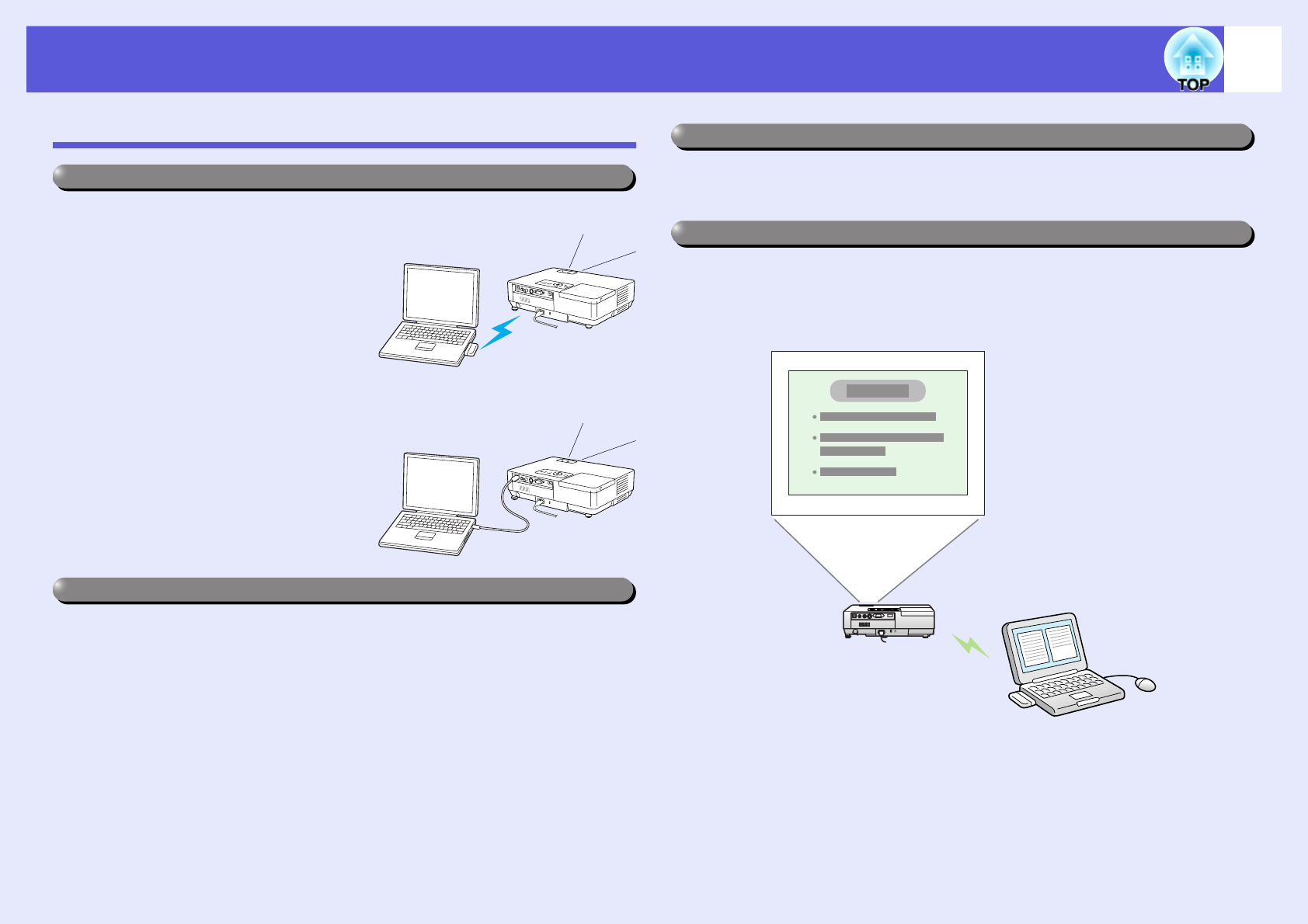
Projector Features 5
EMP-1715/1705 only
fComputer and wireless connection
Use a wireless LAN to connect
easily 1 to 1 with your computer.
sWireless LAN Quick Connection
Guide
You can also connect to the access
point. sEasyMP Operation Guide
fConnect using a USB cable (USB display)
Simply by connecting a cable to
your computer you can project
images from the computer's screen.
sEasyMP Operation Guide
fPresentations without a computer
You can record presentation scenarios to media beforehand, and then
simply start playback. Presentations are possible without a computer.
sEasyMP Operation Guide
fSlide show projection only (Presentation mode)
Presentation mode only projects images from a PowerPoint slide show.
You can give stylish presentations without showing spectators operations
or other preparation material. sEasyMP Operation Guide
Security is stronger than previous models. You can feel secure using it as
part of the network. sEasyMP Operation Guide
You can project each virtual display set on the computer by using two or
more projectors. You can use it to make file operations and arrangements
for the virtual displays while projecting only the virtual displays.
sEasyMP Operation Guide
Connect to a computer easily
Powerful presentation support
Strengthened security level of wireless LAN
Second and third screen projection (Multi-screen display)
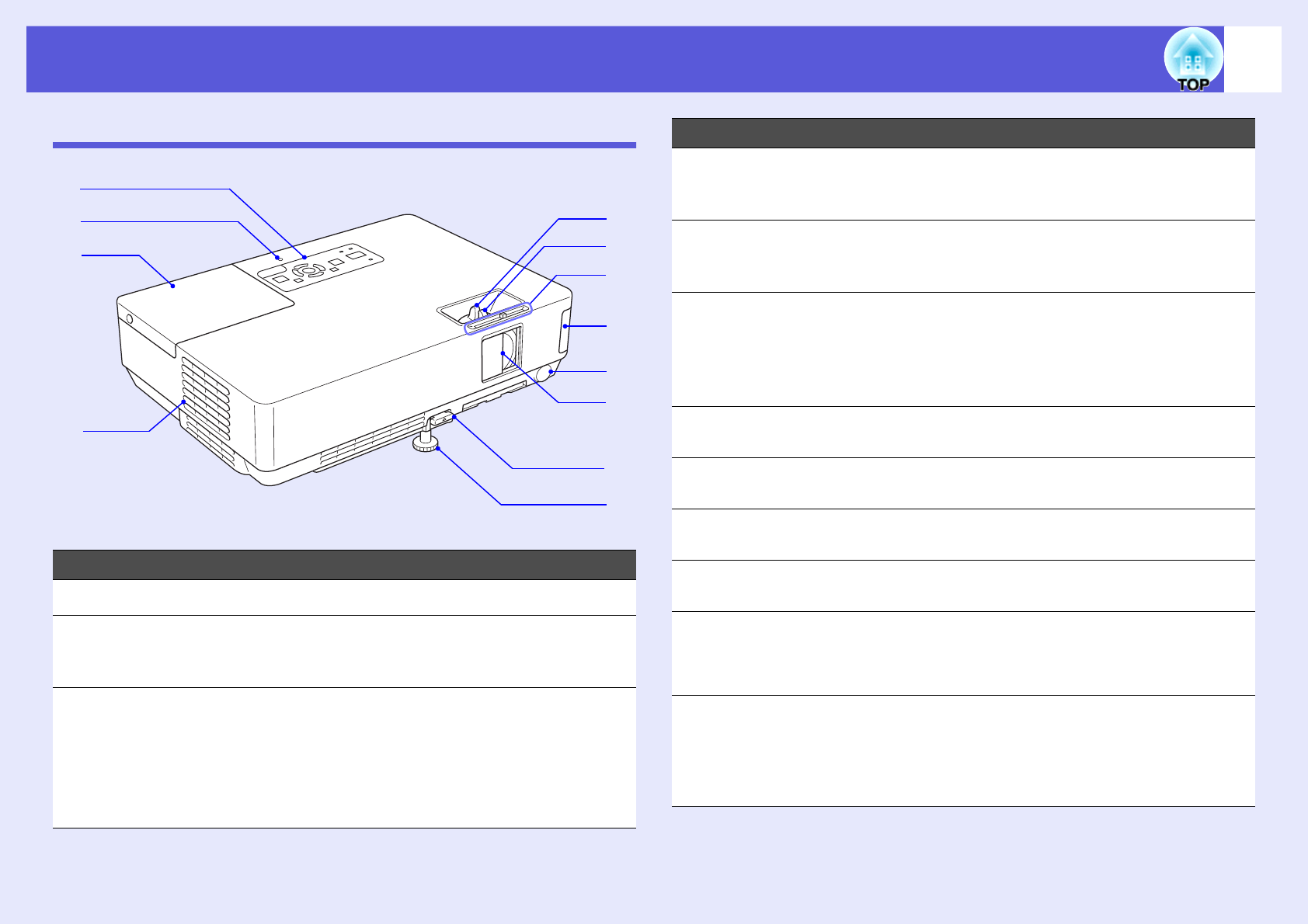
6
Part Names and Functions
Front/Top
Name Function
AControl panel sp.7
BLamp cover Open this cover when replacing the projector's
lamp.
sp.56
CAir exhaust vent Attention
Do not place objects that may become warped
or otherwise affected by heat near the air
exhaust vent and do not put your face or
hands near the air exhaust vent while
projection is in progress.
H
E
D
C
B
A
F
J
L
K
G
I
DFront adjustable
foot
Extend and adjust the position of the projected
image when the projector is placed on a
surface such as a desk.
EFoot adjust lever Pull out the foot lever to extend and retract the
front foot.
sQuick Start Guide
FA/V mute slide Slide shut when not using the projector to
protect the lens. By closing during projection
you can hide the image and the sound (A/V
Mute).
sQuick Start Guide, p.16
GA/V mute slide
knob
Slide the knob to open and close the A/V mute
slide.
HRemote receiver Receives signals from the remote control.
sQuick Start Guide
IFocus ring Adjusts the image focus.
sQuick Start Guide
JZoom ring Adjusts the image size.
sQuick Start Guide
KUSB access
indicator
(EMP-1715/1705
only)
Whether they are flashing or lit indicates the
access status of USB Type A.
LWireless LAN unit
(EMP-1715/1705
only)
Install this before using the projector. Connects
the projector to a computer by a wireless
connection.
sWireless LAN Quick Connection Guide
EasyMP Operation Guide
Name Function
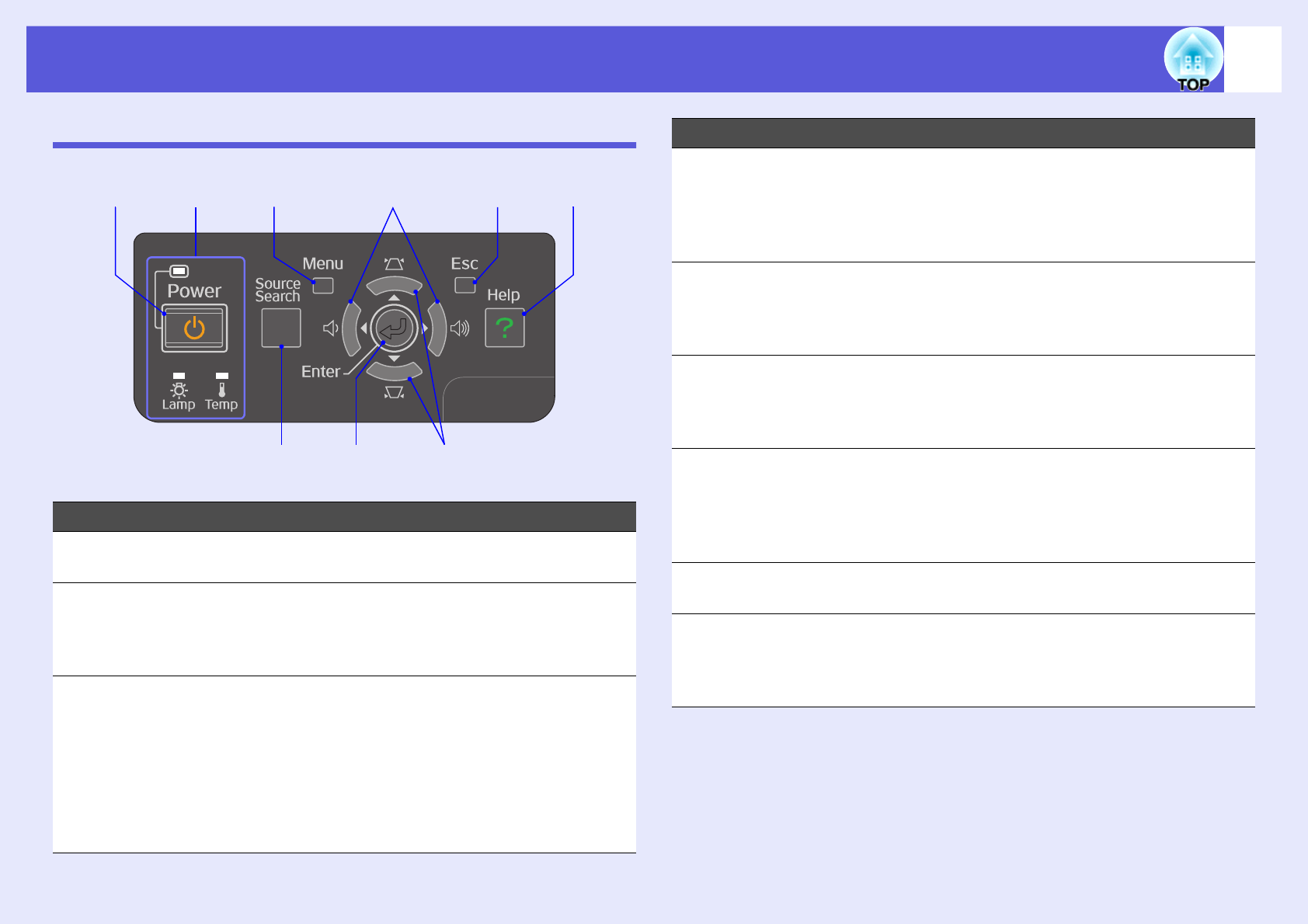
Part Names and Functions 7
Control Panel
Name Function
A[Power] button Turns the projector power on or off.
sQuick Start Guide
B[Source Search]
button
Changes to the next input source that is
connected to the projector and is sending an
image.
sp.13
C[Enter] button If pressed during projection of computer signal
images, it automatically adjusts the tracking,
synchronization, and position to project the
optimum image. When a configuration menu or
a help screen is displayed, it accepts and
enters the current selection and moves to the
next level.
sp.31
G
D
HF
CB
EIA
D[v] [w] buttons Corrects keystone distortion.
If pressed when a configuration menu or a help
screen is displayed, these buttons select menu
items and setting values.
sQuick Start Guide, p.31
E[Help] button Displays and closes the help screen which
shows you how to deal with problems if they
occur.
sp.41
F[Esc] button Stops the current function.
If pressed when a configuration menu is
displayed, it moves to the previous menu level.
sp.31
G[a] [b] buttons Adjusts the sound volume.
If pressed when a configuration menu or a help
screen is displayed, these buttons select menu
items and setting values.
sQuick Start Guide, p.31
H[Menu] button Displays and closes the configuration menu.
sp.31
IStatus indicators The colour of the indicators and whether they
are flashing or lit indicates the status of the
projector.
sp.42
Name Function
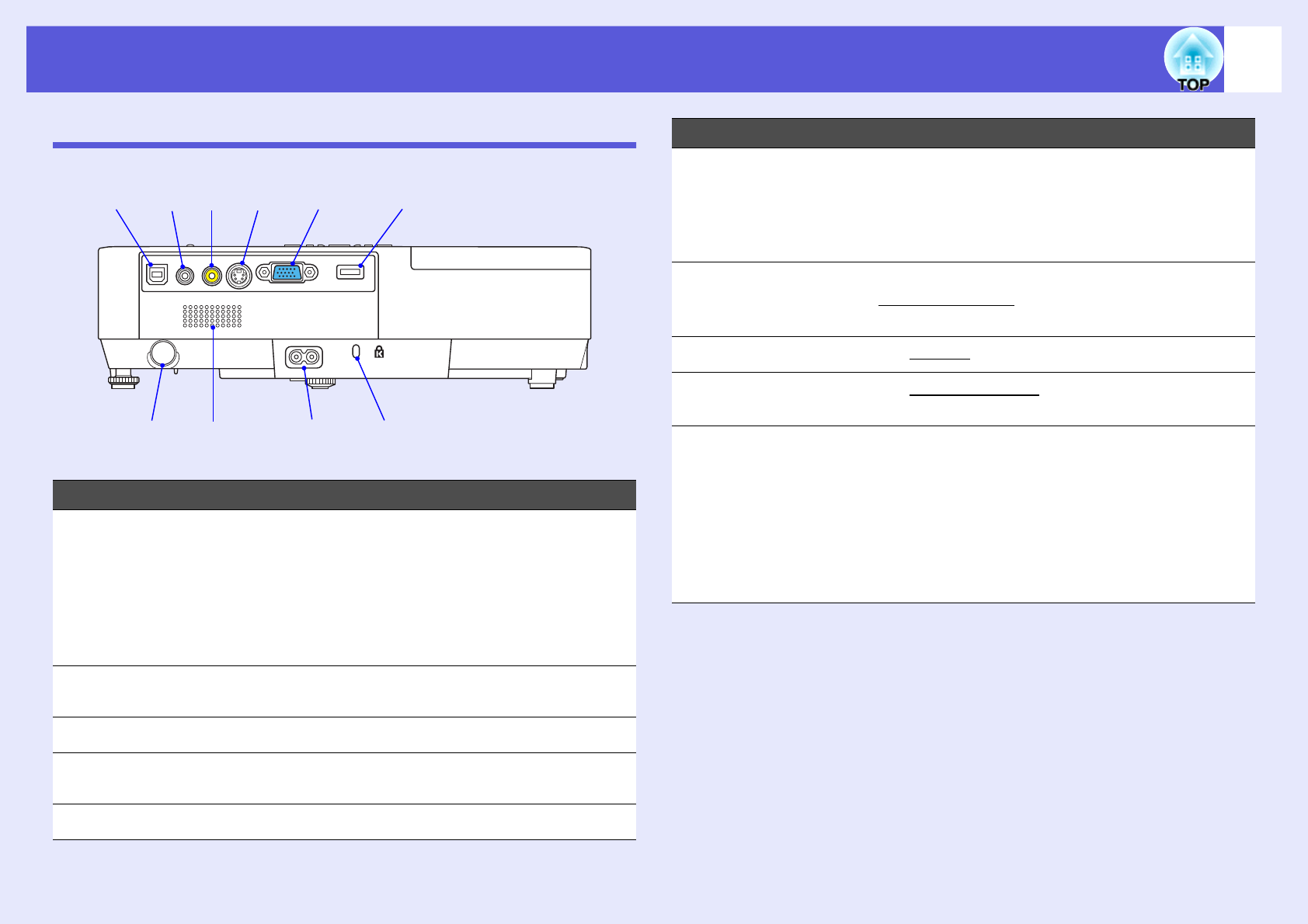
Part Names and Functions 8
Rear
Name Function
AUSB port Type B Connects the projector to a computer by a
USB cable, and the image on the computer is
projected (EMP-1715/1705 only).
Also, when using the wireless mouse function,
you can connect to a computer by a USB
cable.
sQuick Start Guide
BRemote receiver Receives signals from the remote control.
sQuick Start Guide
CSpeaker
DPower inlet Connects to the power cable.
sQuick Start Guide
ESecurity slot (j)sp.66
A
BC
JI H G F
ED
FUSB port Type A
(EMP-1715/1705
only)
Connects the memory for compatible digital
cameras and USBs, and projects image/movie
files and scenarios with the PC Free of
EasyMP.
sQuick Start Guide
GComputer
(Component
Video) port
For video signals from a computer and
component videog signals from other video
sources.
HS-Video port For S-videog signals from video sources.
IVideo port For composite videog signals from video
sources.
JAudio port For the audio in signal of connected
equipment.
When projecting with the PC Free function of
EasyMP, you can output the audio to an
external speaker by setting "EasyMP Audio
Out" from the configuration menu (EMP-1715/
1705 only).
sp.34
Name Function
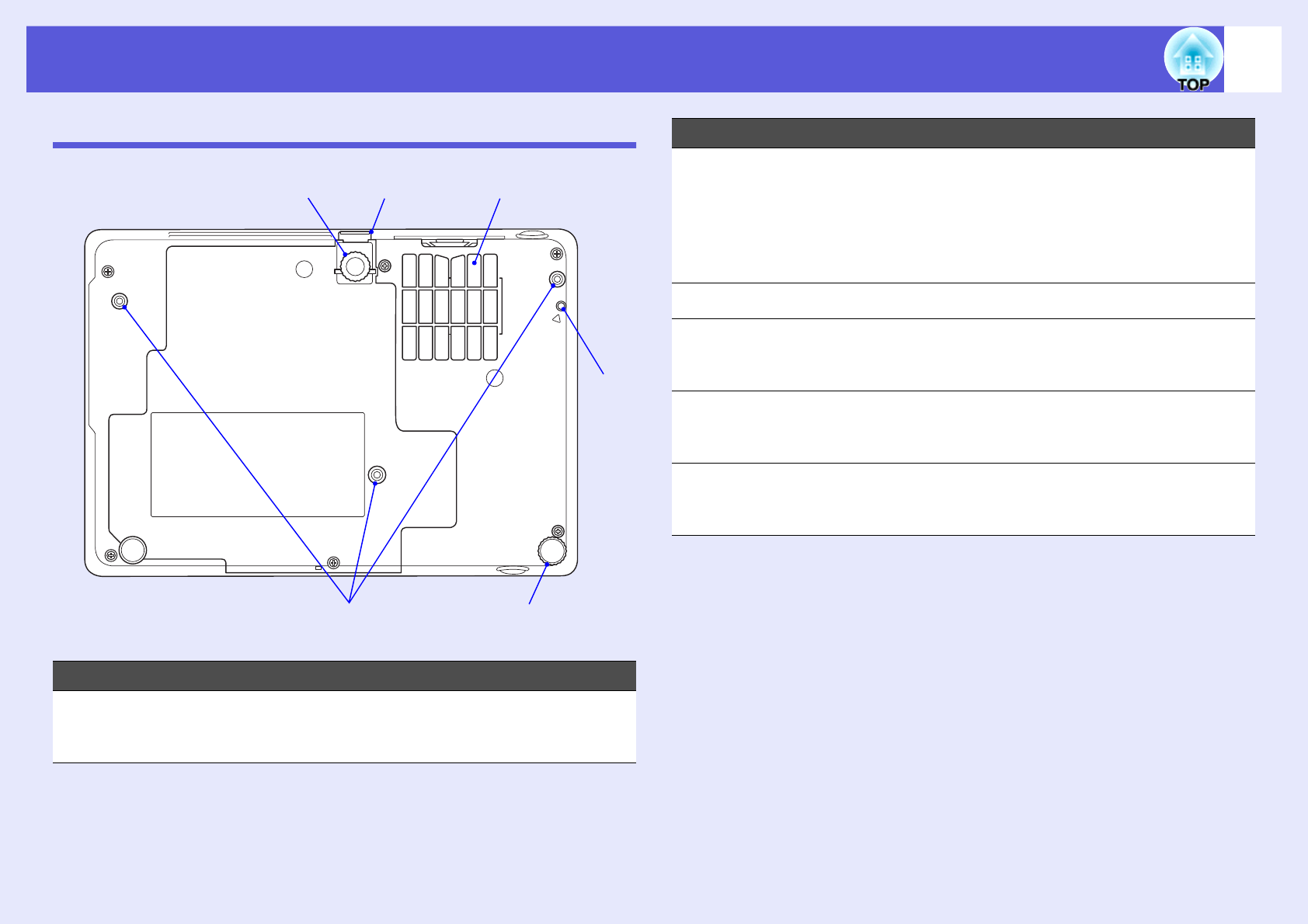
Part Names and Functions 9
Base
Name Function
ASuspension
bracket fixing
points (3 points)
Attach the optional ceiling mount here when
suspending the projector from a ceiling.
sp.53, 64
A
BCD
E
F
BAir filter (Air
intake vent)
This prevents dust and other foreign particles
from getting inside the projector when air is
drawn in. The projector displays a warning
message when it is time to clean or replace the
air filter.
sp.54, 59
CFoot adjust lever sQuick Start Guide
DFront adjustable
foot
Extend and adjust the position of the projected
image when the projector is placed on a
surface such as a desk.
ERear foot Turn to extend and retract to adjust the
horizontal tilt.
sQuick Start Guide
FScrew hole to fix
wireless or cable
LAN unit
This hole is for a screw to fix the wireless or
cable LAN unit in place.
sWireless LAN Quick Connection Guide
Name Function
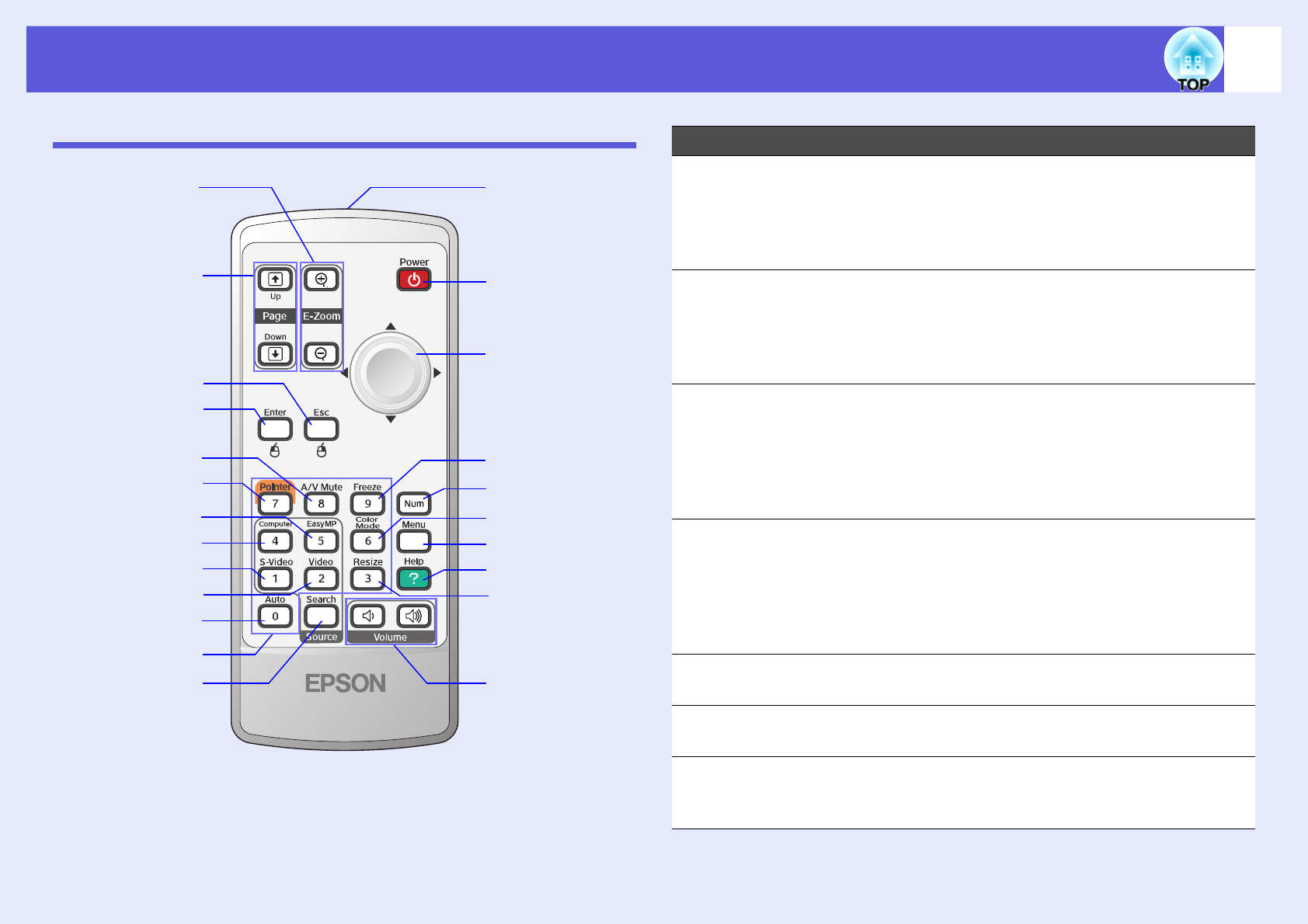
Part Names and Functions 10
Remote Control
B
E
H
U
Q
WA
C
D
F
G
I
J
K
L
NM
O
P
R
S
T
V
Name Function
A[E-Zoom] button
(z) (x)
(z) Enlarges the image without changing the
projection size.
(x) Reduces parts of images that have been
enlarged using the [z] button.
sp.19
B[Page Up] [Page
Down] buttons
([) (])
When the wireless mouse function and
Network presentation are performed (EMP-
1715/1705 only), you can change the
PowerPoint file page by pressing the page up/
page down buttons.
C[Esc] button Stops the current function. If pressed when a
configuration menu is displayed, it moves to
the previous level. Acts as a mouse's right
button when using the wireless mouse
function.
sp.31
D[Enter] button When a configuration menu or a help screen is
displayed, it accepts and enters the current
selection and moves to the next level. Acts as
a mouse's left button when using the wireless
mouse function.
sp.31
E[A/V Mute] button Turns the video and audio on or off.
sp.16
F[Pointer] button Press to activate the on screen pointer.
sp.18
G[EasyMP] button Changes to the EasyMP image. This cannot
be used with the EMP-1710/1700 (EMP-1715/
1705 only).
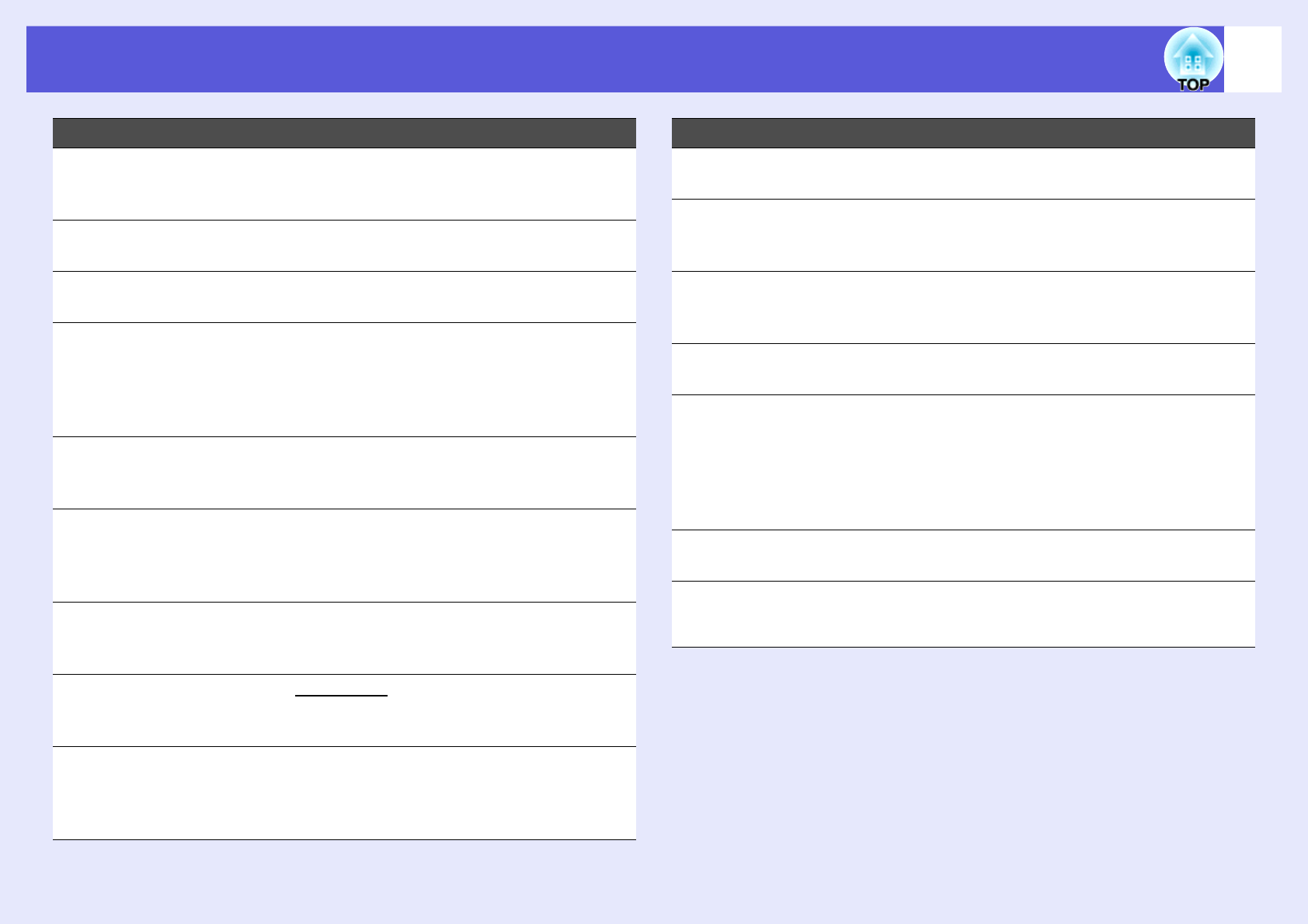
Part Names and Functions 11
H[Computer]
button
Displays to images from the Computer
(Component Video) port.
sp.14
I[S-Video] button Displays to images from the S-Video port.
sp.14
J[Video] button Displays to images from the Video port.
sp.14
K[Auto] button If pressed during projection of computer signal
images, it automatically adjusts the tracking,
synchronization, and position to project the
optimum image.
sp.33
LNumeric buttons Use these buttons when entering a password
or screen ID.
sp.28
M[Search] button Changes to the next input source that is
connected to the projector and is sending an
image.
sp.13
N[Volume] buttons (a) Decreases the volume.
(b) Increases the volume.
sQuick Start Guide
O[Resize] button The aspect ratiog changes each time the
button is pressed.
sp.17
P[Help] button Displays and closes the help screen which
shows you how to deal with problems if they
occur.
sp.41
Name Function
Q[Menu] button Displays and closes the configuration menu.
sp.31
R[Color Mode]
button
Each time the button is pressed, the colour
mode changes.
sp.15
S[Num] button Use this button when entering a password or
screen ID.
sp.28
T[Freeze] button Images are paused or unpaused.
sp.17
U[h] button When a configuration menu or help screen is
displayed, it selects menu items and setting
values. When the wireless mouse function is
activated, tilting this button moves the pointer
in the direction it is tilted.
sp.31
V[Power] button Turns the projector power on or off.
sQuick Start Guide
WRemote control
light-emitting
area
Outputs remote control signals.
sQuick Start Guide
Name Function

Useful Functions
This chapter explains useful functions for giving presentations and so on, and the security functions.
Changing the Projected Image .......................... 13
• Automatically Detect Incoming Signals and Change
the Projected Image (Source Search) ..............................13
• Changing Directly from the Remote Control .................14
Functions for Enhancing Projection................. 15
• Selecting the Projection Quality
(Selecting Colour Mode)...................................................15
• Hiding the Image and Sound Temporarily
(A/V Mute) .........................................................................16
• Freezing the Image (Freeze).............................................17
• Changing the Aspect Ratiog (Resize) ..............................17
• Pointer Function (Pointer) ...............................................18
• Enlarging Part of the Image (E-Zoom) ...........................19
• Using the Remote Control to Operate the Mouse
Pointer (Wireless Mouse) .................................................20
Adjusting Colour for Several Projectors
(Multi-Screen Colour Adjustment).....................23
• Summary of Adjustment Procedure............................... 23
• Setting Screen ID .............................................................. 23
• Image Correction Method ............................................... 24
Security Functions..............................................26
• Managing Users (Password Protect)............................... 26
Type of Password Protect .............................................................. 26
Setting Password Protect................................................................ 27
Entering the password.................................................................... 28
• Restricting Operation (Operation Lock)........................ 29
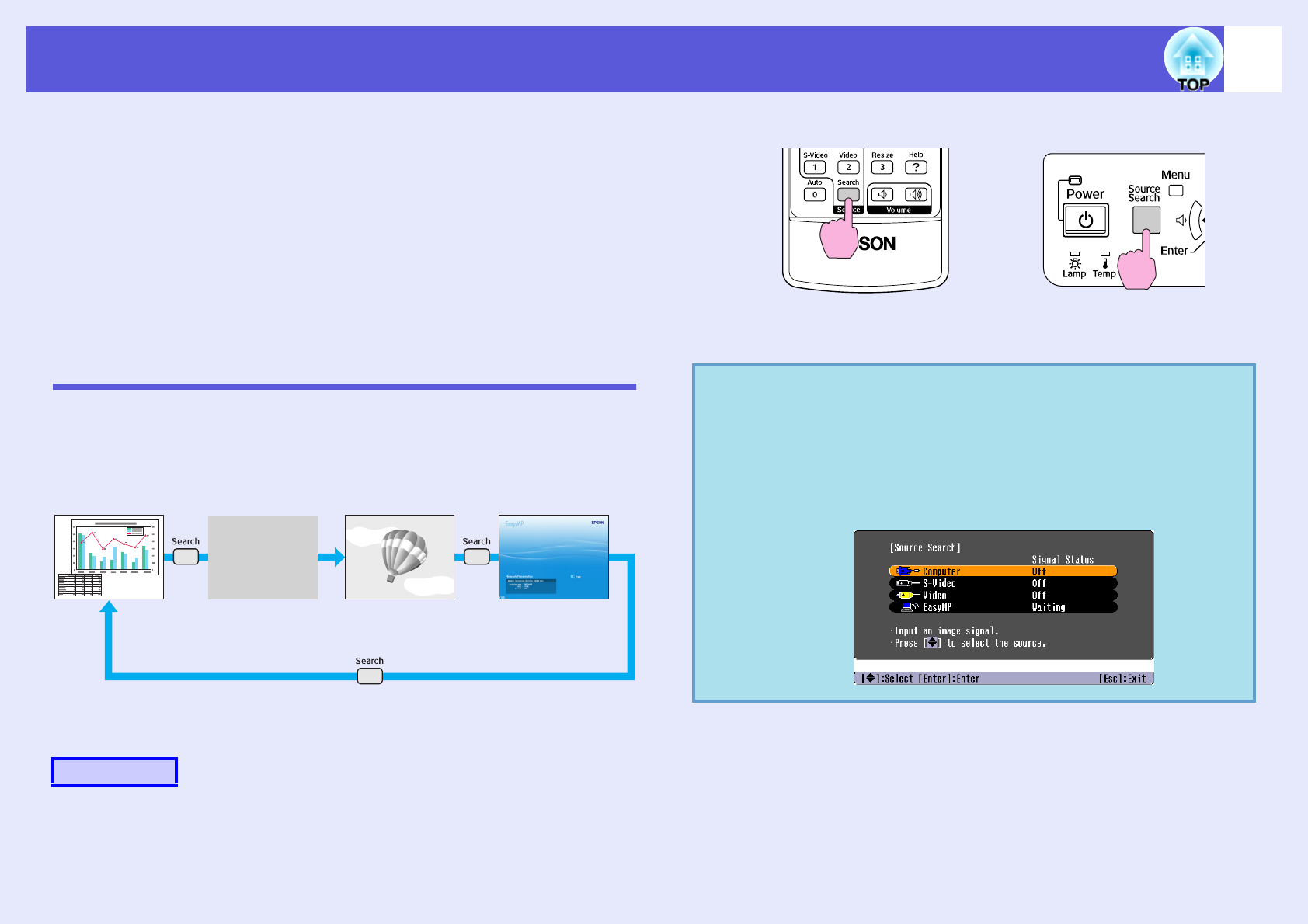
13
Changing the Projected Image
You can change the projected image in the following two ways.
• Changing by Source Search
The projector automatically detects signals being input from
connected equipment, and the image being input from the equipment
is projected.
• Changing directly
You can use the remote control buttons to change to the target input
port.
Automatically Detect Incoming Signals and Change
the Projected Image (Source Search)
You can project the target image quickly as input ports with no image
signal being input are ignored when you change by pressing the [Source
Search] button.
* EasyMP changes when using EMP-1715/1705.
Install the wireless LAN unit supplied (EMP-1715/1705 only).
When your video equipment is connected, start playback before beginning
this operation.
When two or more pieces of equipment are connected, press the
[Source Search] button until the target image is projected.
Procedure
Computer EasyMP
(EMP-1715/1705 only)
VideoS-Video
The input port where no image
signal is being input is skipped.
qThe following screen showing the status of image signals is
displayed when only the image that the projector is
currently displaying is available, or when no image signal
can be found. You can select the input port where the
connected equipment you want to use is projecting. If no
operation is performed after about 10 seconds, the screen
closes.
Using the remote control Using the control panel
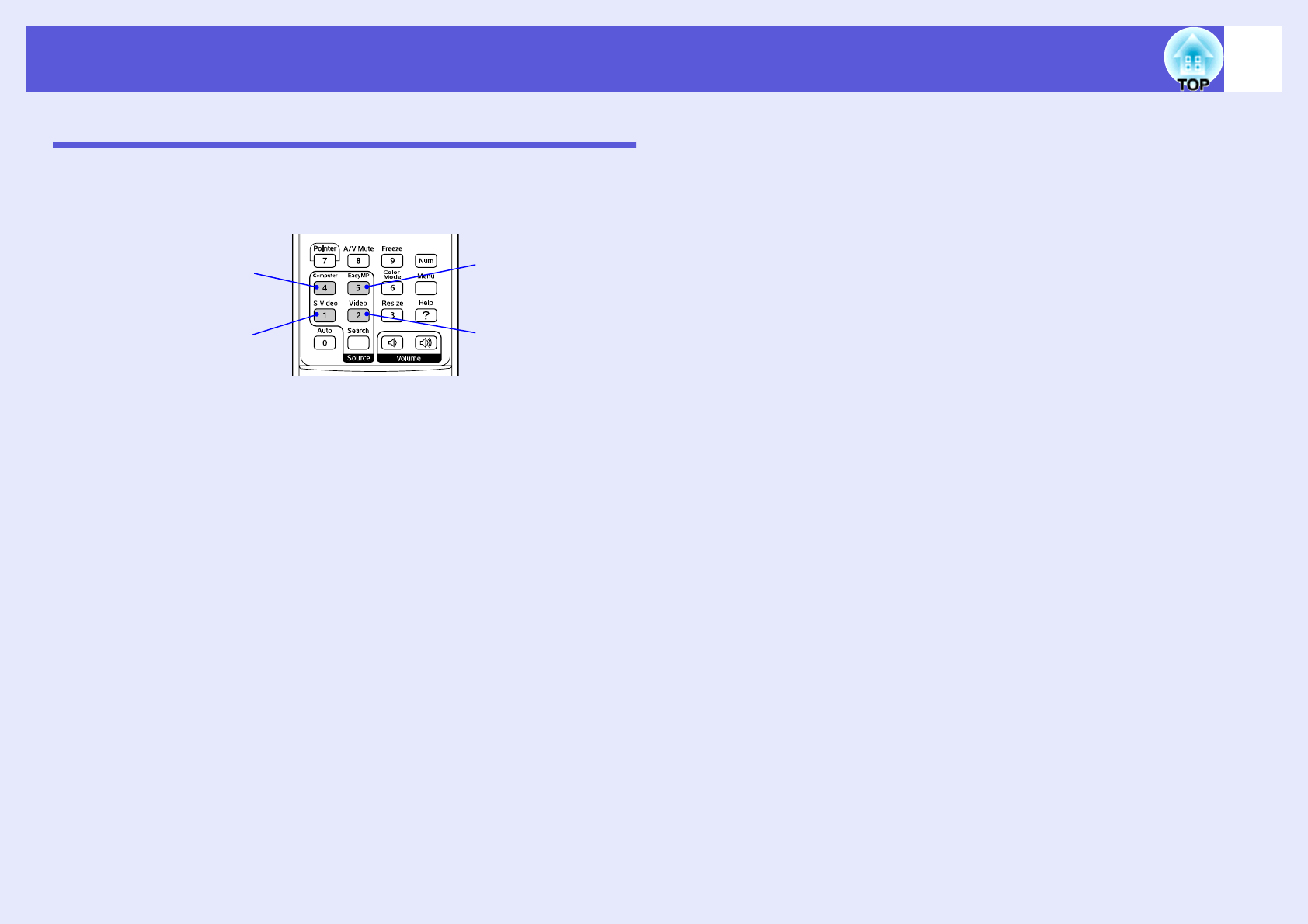
Changing the Projected Image 14
Changing Directly from the Remote Control
You can change directly to the target image by pressing the following
buttons on the remote control.
Changes to images from
the Computer
(Component Video) port.
Changes to images from
the S-Video port.
Changes to images
from the Video port.
Remote control
Changes to the
EasyMP image.
(EMP-1715/1705 only)
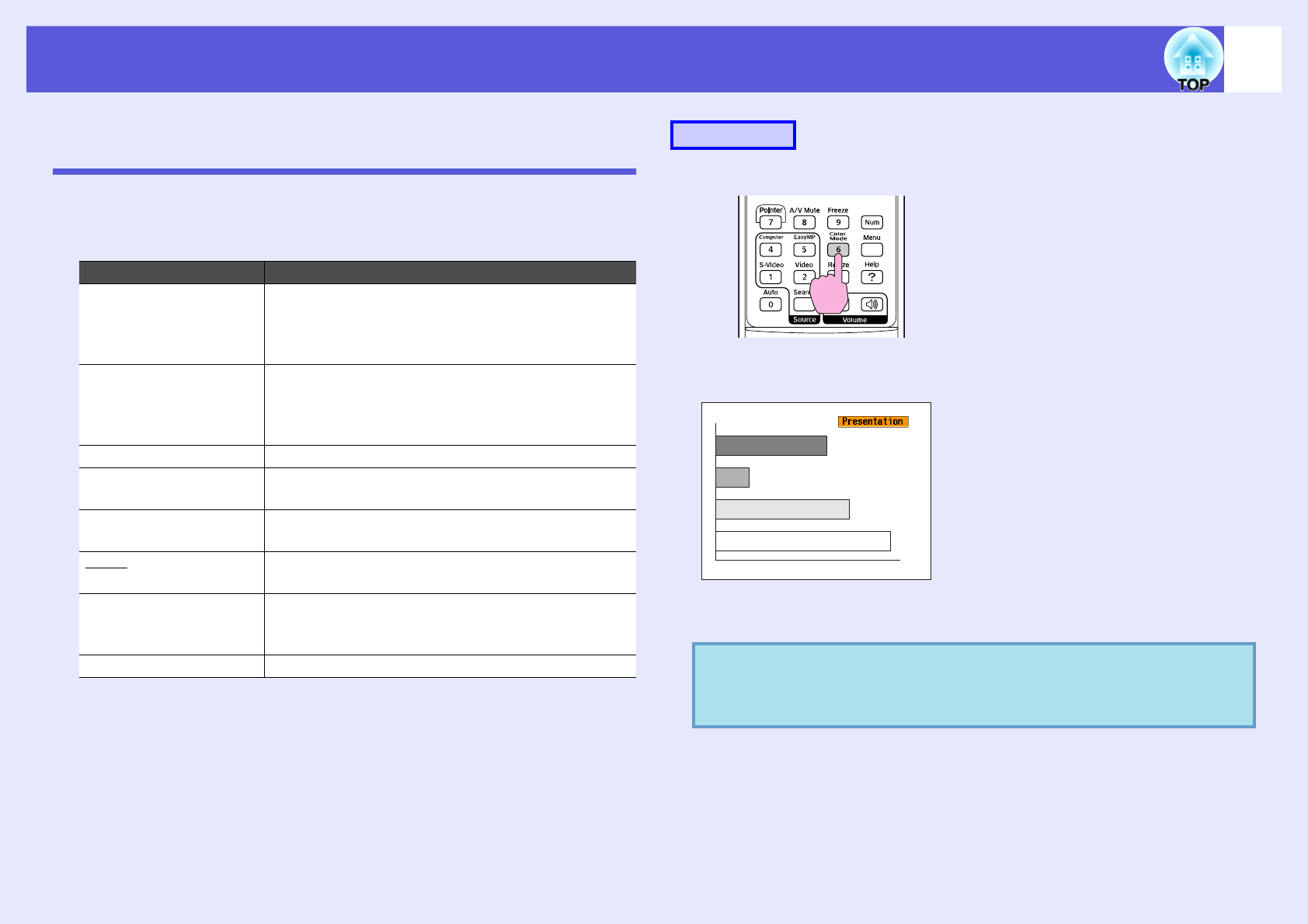
15
Functions for Enhancing Projection
Selecting the Projection Quality (Selecting Colour
Mode)
You can easily obtain the optimum image quality simply by selecting the
setting that best corresponds to your surroundings when projecting. The
brightness of the image varies depending on the mode selected.
Each time you press the button, the colour mode name is displayed on the
screen and the colour mode changes.
If you press the button while the colour mode name is displayed on the
screen, it changes to the next colour mode.
Mode Application
Photo (When computer images are input)
Ideal for projecting still pictures, such as photos, in a
bright room. The images are vivid and brought into
contrast.
Sports (When component video, S-video, or composite
video images are input)
Ideal for watching TV programmes in a bright room.
The images are vivid and brought to life.
Presentation Ideal for giving presentations in a bright room.
Theatre Ideal for watching films in a dark room. Gives
images a natural tone.
Game Ideal for playing video games in a bright room.
Excels at emphasizing dark gradations.
sRGBgIdeal for images that conform to the sRGB colour
standard.
Blackboard Even if you are projecting onto a blackboard
(greenboard), this setting gives your images a natural
tint, just like when projecting onto a screen.
Customized You can set it to a specific colour.
Procedure
qThe colour mode can also be set using "Color Mode" in the
"Image" menu from the configuration menu.
s
p.32
Remote control
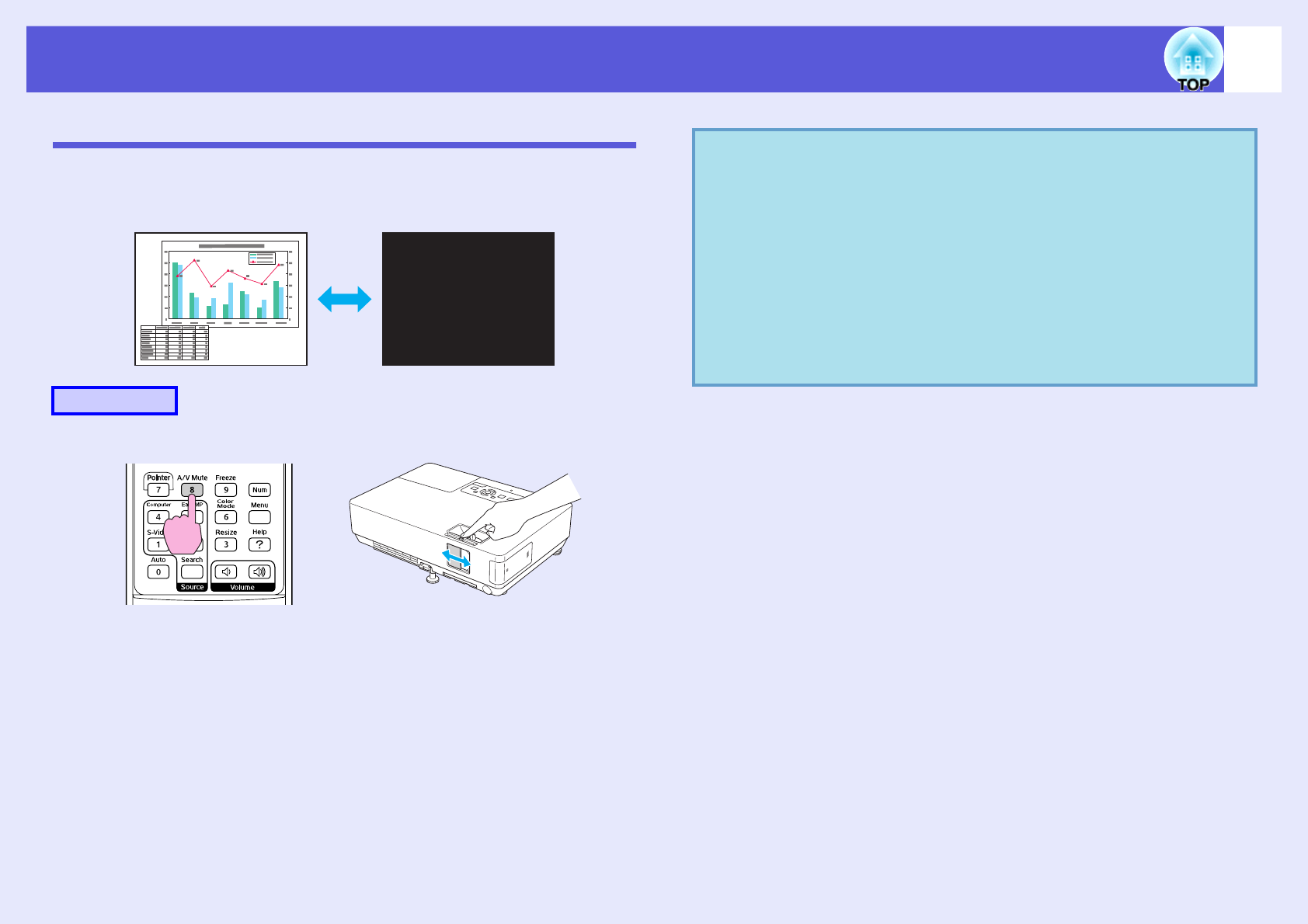
Functions for Enhancing Projection 16
Hiding the Image and Sound Temporarily (A/V Mute)
You can use this when you want to focus the audience's attention on what
you are saying, or if you do not want to show details such as when you are
changing between files during presentations from a computer.
Each time you press the button, or the A/V mute slide is opened or closed,
A/V Mute turns on or off.
Procedure
Remote control Projector
q• If you use this function when projecting moving images,
the images and sound continue to be played back by the
source, and you cannot return to the point where A/V
Mute was activated.
• You can choose to display black, blue, or logo as the A/V
mute display using the "Extended"-"Display"-"A/V
Mute" setting from the configuration menu.
s
p.35
• When the A/V mute slide is closed and A/V mute begins,
the power supply can be set to automatically turn off after
about 30 minutes by setting "Extended" - "Sleep Mode"
from the configuration menu.
s
p.36
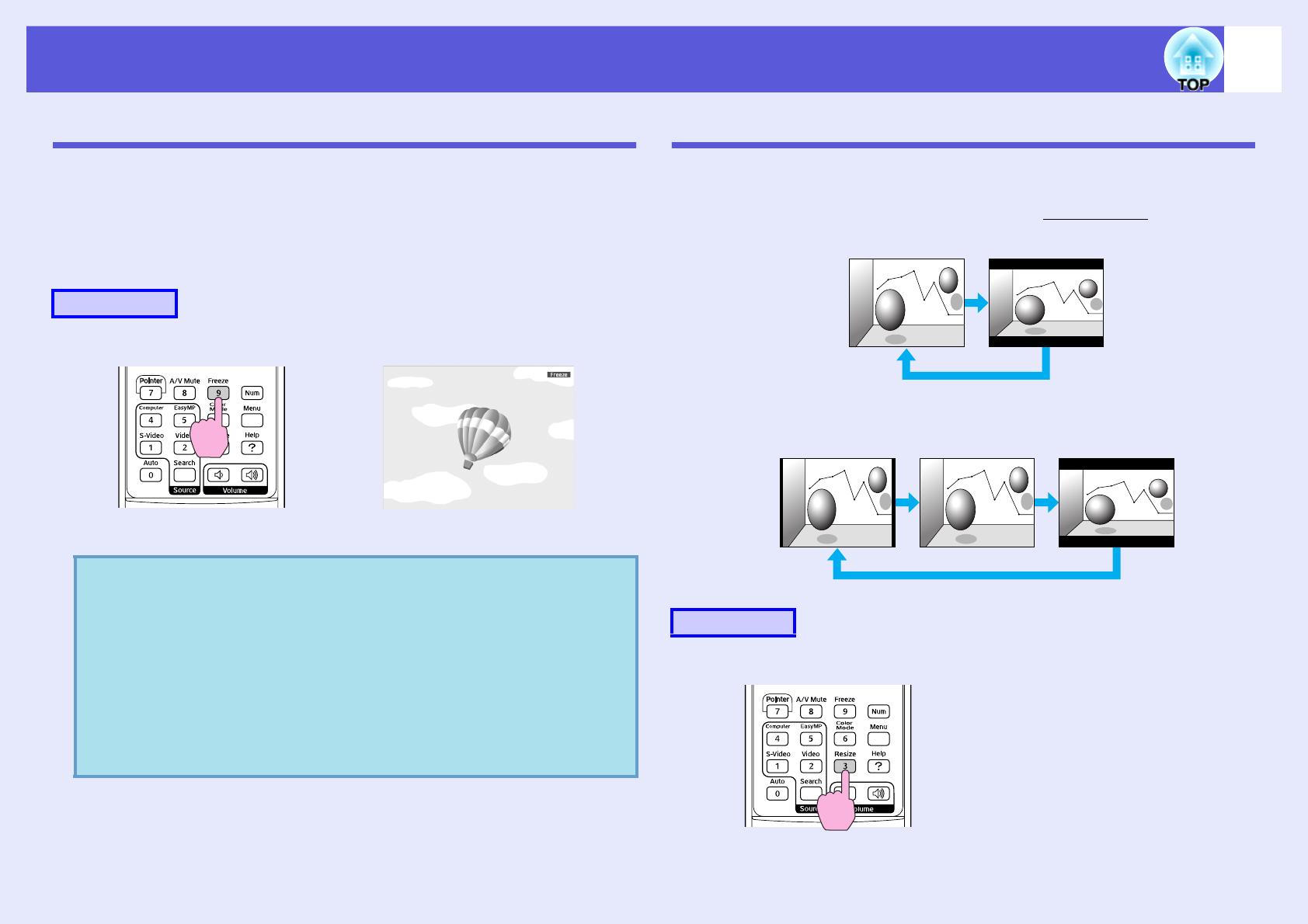
Functions for Enhancing Projection 17
Freezing the Image (Freeze)
When the moving image on the screen is frozen, the image continues to
project, so you can project a moving image one frame at a time like a still
photo. Also, you can perform operations such as changing between files
during presentations from a computer without projecting any images if the
freeze function is activated beforehand.
Each time you press the button, Freeze turns on or off.
Changing the Aspect Ratiog (Resize)
When video equipment is connected, images that have been recorded in
digital video or onto DVDs can be viewed in 16:9 wide-screen format.
You can change the aspect ratio for images in squeeze modeg as follows.
You can change the aspect ratio for computer images as follows.
Procedure
q• Audio does not stop.
• The image source continues to playback the moving
images even while the screen is frozen, and so it is not
possible to resume projection from the point where it was
paused.
• If the [Freeze] button is pressed while the configuration
menu or a help screen is displayed, the menu or help
screen being displayed is cleared.
• Freeze still works while E-Zoom is being used.
Remote control
Procedure
16:94:3
16:94:3Normal (only when RGB)
Remote control

Functions for Enhancing Projection 18
Each time you press the button, the aspect name is displayed on the screen
and the aspect changes.
If you press the button while the aspect name is displayed on the screen, it
changes to the next aspect mode.
Pointer Function (Pointer)
This allows you to move a pointer icon on the projected image, and helps
you draw attention to the area you are talking about.
ADisplay the pointer.
Each time you press the button, the pointer appears or disappears.
qThe colour mode can also be set using "Resize" in the
"Signal" menu from the configuration menu.
s
p.33
Procedure
Remote control

Functions for Enhancing Projection 19
BMove the pointer icon. Enlarging Part of the Image (E-Zoom)
This is useful when you want to expand images to see them in greater
detail, such as graphs and tables.
AStart E-Zoom.
qYou can choose from three different kinds of pointer icon
( ) in "Settings" - "Pointer Shape" from the
configuration menu.
s
p.34
Pointer icon
Remote control
Procedure
Remote control
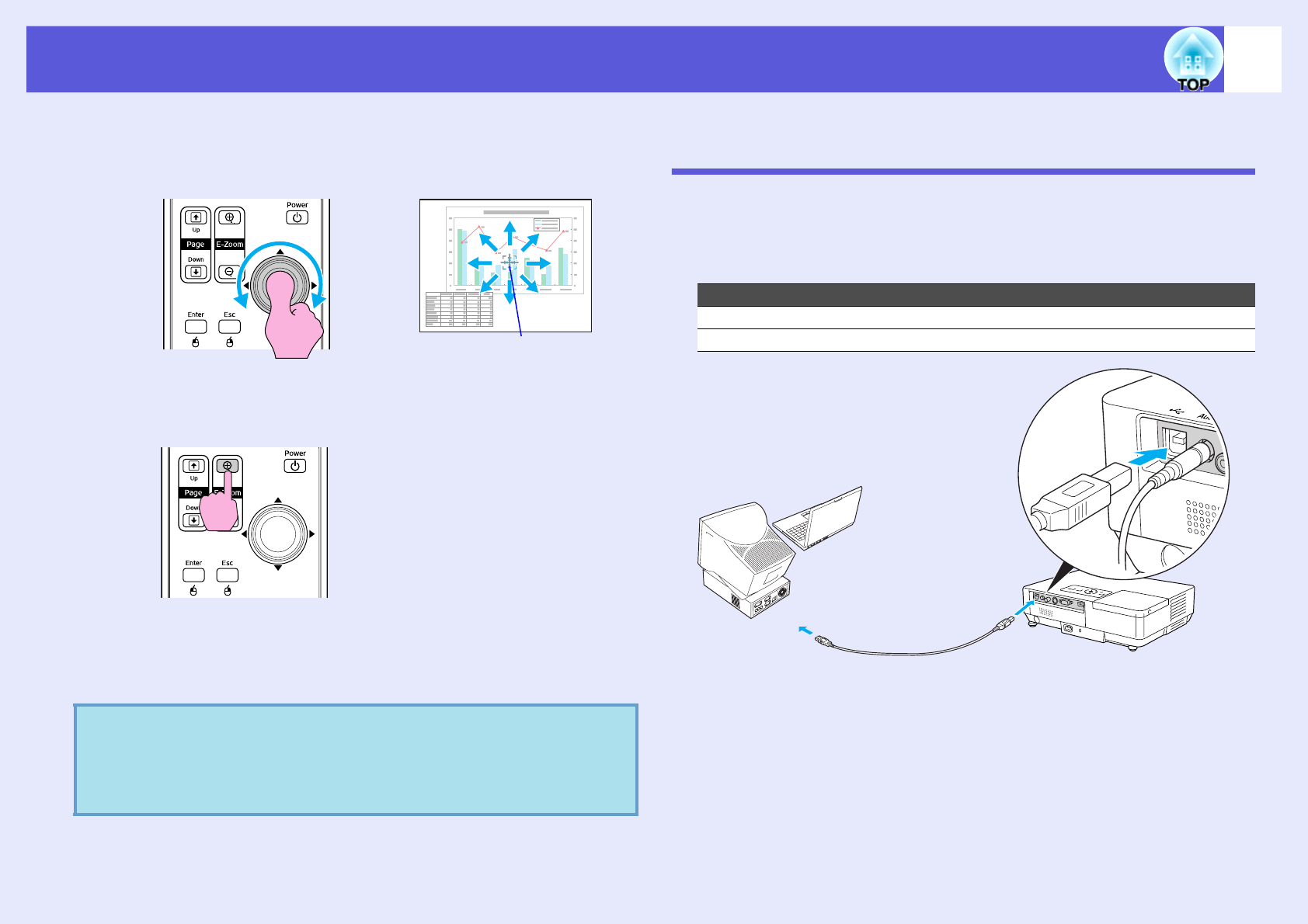
Functions for Enhancing Projection 20
BMove the cross to the area of the image that you
want to enlarge.
CEnlarge.
Each time the button is pressed, the area is expanded. You can
expand quickly by holding the button down.
You can reduce the enlarged image by pressing the [x] button.
Press the [Esc] button to cancel.
Using the Remote Control to Operate the Mouse
Pointer (Wireless Mouse)
If the USB terminal of a computer and the USB terminal on the back of
this projector are connected by a commercially available USB A-B cable,
you can use the projector's remote control like a wireless mouse to control
the computer's mouse pointer.
q• The enlargement ratio appears on the screen. The selected
area can be enlarged to between 1 to 4 times in 25
incremental steps.
• Tilt the [
h
] button to scroll the image.
Cross
Remote control
Remote control
Computer
Windows 98/2000/Me/XP Home Edition/XP Professional
Macintosh (OS 8.6–9.2/10.1–10.4)
USB cable
To USB port
To USB port
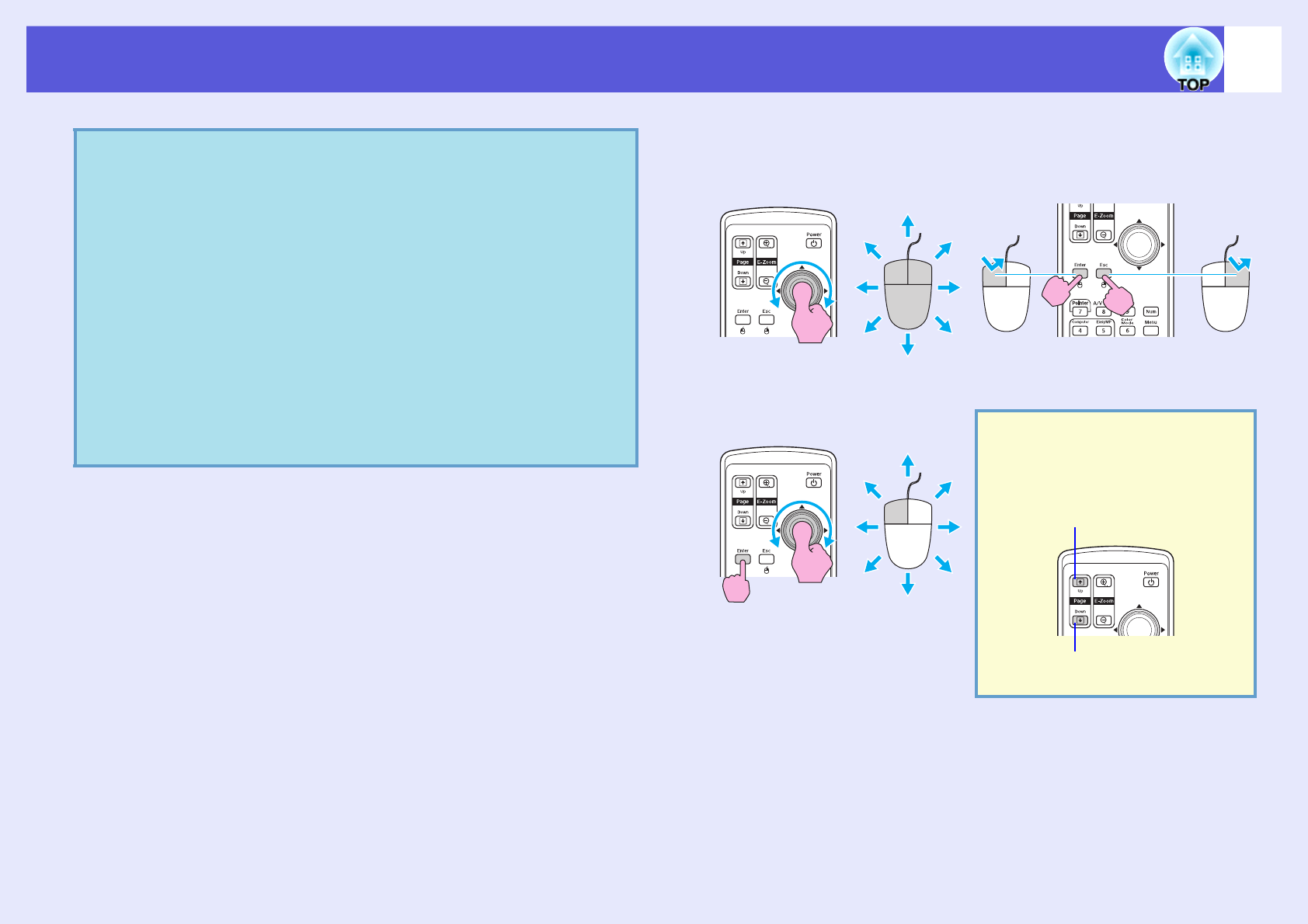
Functions for Enhancing Projection 21
Once the connection has been made, the mouse pointer can be operated as
follows.
q• The USB cable can only be connected to computers with a
standard USB interface. If using a computer which is
running Windows, the computer must have had a full
version of Windows 98/2000/Me/XP Home Edition/XP
Professional installed. If the computer is running a
version of Windows 98/2000/Me/XP Home Edition/XP
Professional that has been upgraded from an earlier
version of Windows, correct operation cannot be
guaranteed.
• It may not be possible to use the mouse function under
some versions of both the Windows and Macintosh
operating systems.
• Some computer settings may have to be changed in order
for the mouse function to be used. Consult the
documentation for the computer for further details.
Moving the mouse pointer Mouse clicks
Drag and drop This is useful for displaying
the previous or next slide in a
PowerPoint slideshow.
Double-click: Press twice in rapid
succession.
Left click Right click
1. Hold down the [Enter] button and
tilt and drag the [h] button.
2. Release the [Enter] button to drop
at the desired location.
To previous slide
To next slide
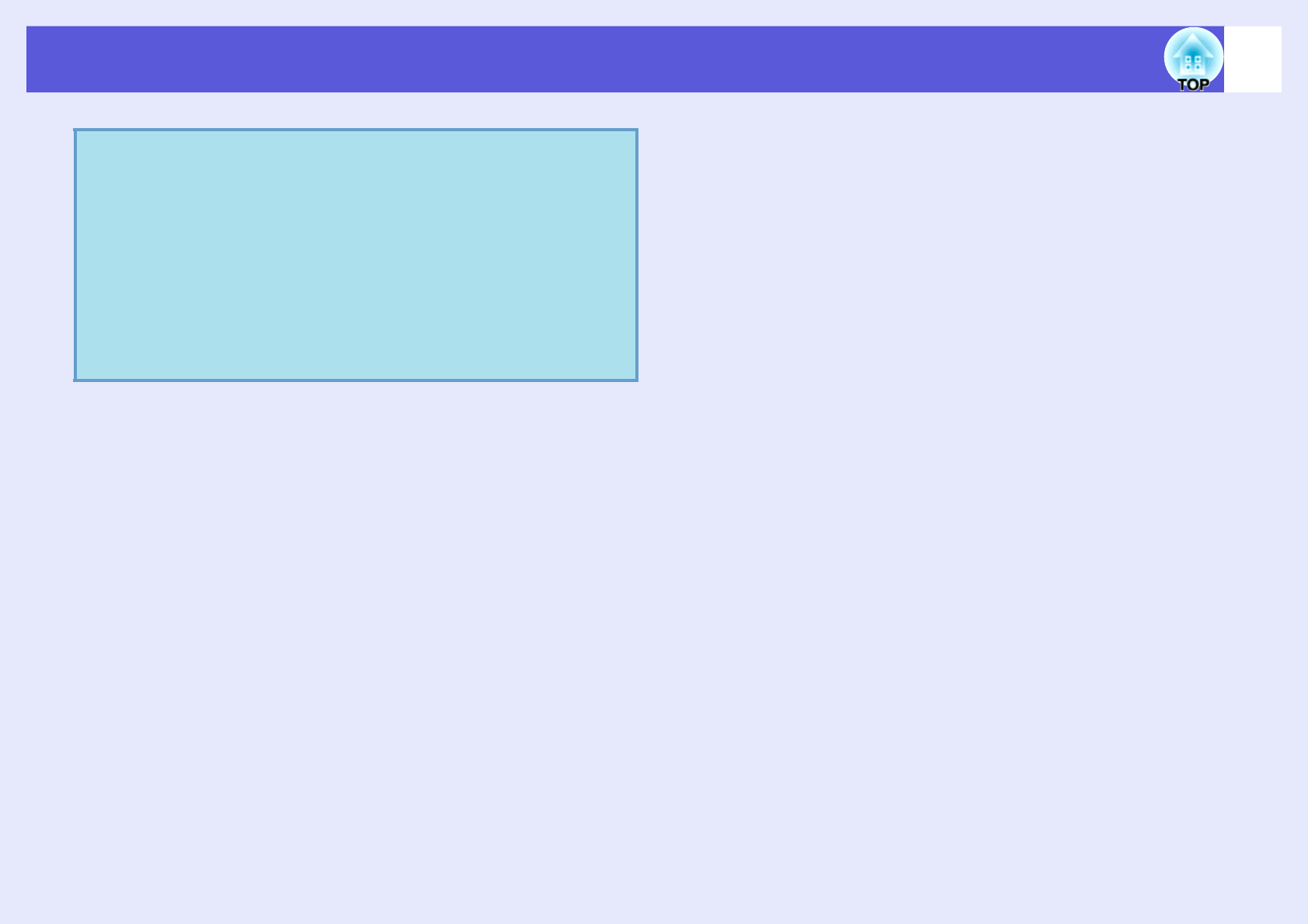
Functions for Enhancing Projection 22
q• If the mouse button settings are set to reverse on the
computer, the operation of the remote control buttons will
also be reversed.
• The wireless mouse function cannot be used while the
following functions are being used.
· While a configuration menu is being displayed
· While a help menu is being displayed
· While the E-Zoom function is being used
· While a user's logo is being captured
· Pointer function
· While adjusting sound volume
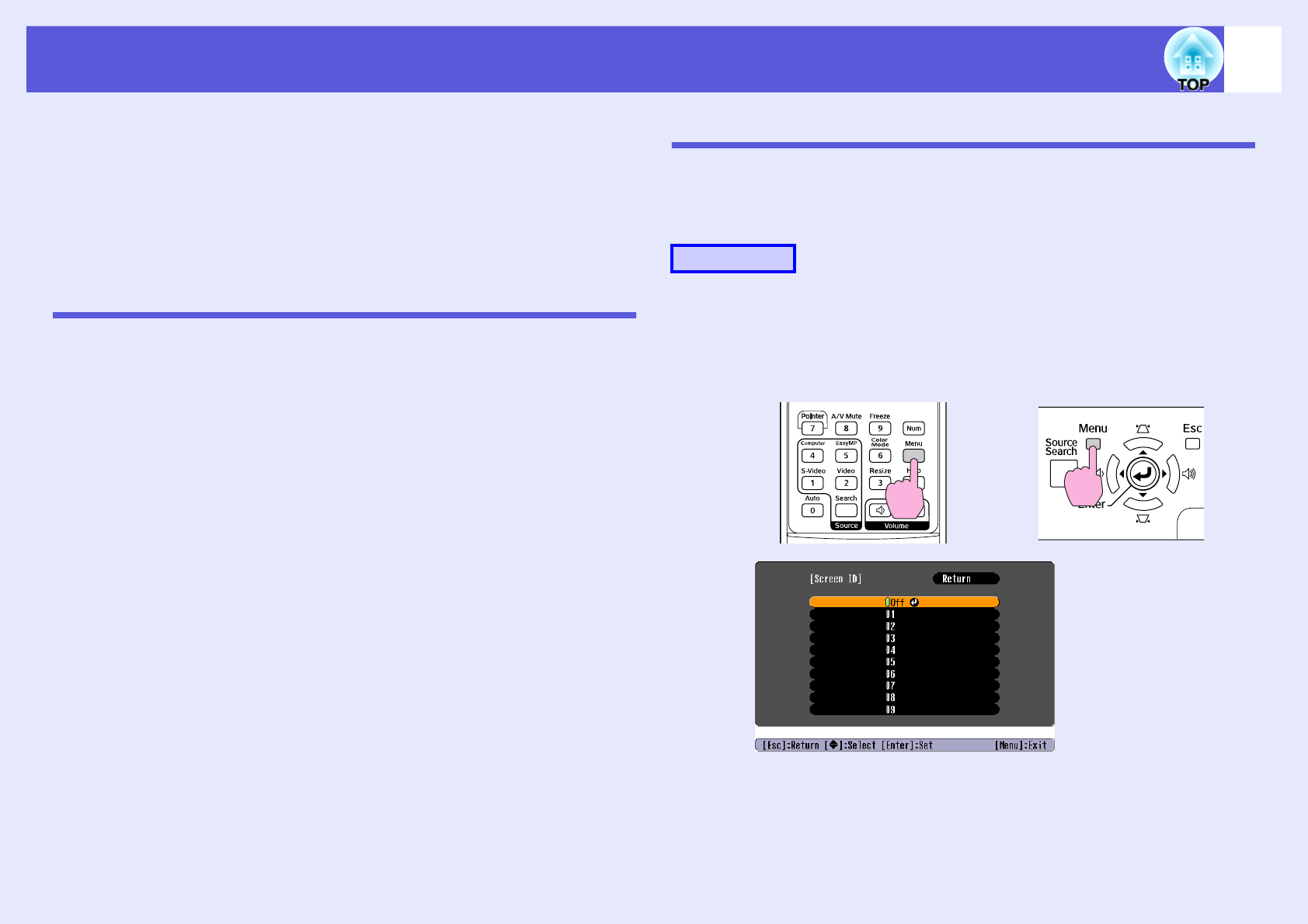
23
Adjusting Colour for Several Projectors (Multi-Screen Colour Adjustment)
When several projectors are lined up and projecting images, you can
adjust the brightness and colour tone of each projector's image with
multi-screen colour adjustment so that the colours of images from
each projector match closely.
In some cases the brightness and colour tone may not match
completely even after adjustment.
Summary of Adjustment Procedure
Make adjustments according to the following procedure.
1. Setting screen ID
Before setting up the projectors, set one screen ID for each.
When making adjustments for two or more projectors using the remote
control, you can operate them individually by setting individual screen
IDs for each projector.
2. Making image corrections
After the projectors are setup, you can adjust the image for each
projector.
Using Image Correction you can adjust from black to white in five
stages called levels 1 to 5, and in each level 1 to 5 you can adjust the
following two points.
• Adjusting brightness
Adjust each image by levels 1 to 5 so that they are all equal.
• Adjusting colour
Adjust each image by levels 1 to 5 so that the colours match using
"Color Correct. (G/R)" and "Color Correct. (B/Y)".
Setting Screen ID
For instance, after setting one projector as screen ID3, when you press
button [3] while holding down the [Num] button, even if there is more
than one projector setup, you can operate just the one set as screen ID3.
APress the [Menu] button and select "Extended" -
"Multi-screen" - "Screen ID" from the configuration
menu. sp.31
Check the buttons you can use and the operations they perform in
the guide under the menu.
Procedure
Using the remote control Using the control panel

Adjusting Colour for Several Projectors (Multi-Screen Colour Adjustment) 24
BChoose the ID you want to set and press the [Enter]
button.
CPress the [Menu] button to close the configuration
menu.
• Point the remote control at the remote receiver on the projector
you want to operate, press the numeric button corresponding to
the screen ID set while holding down the [Num] button, and then
you can operate only the projector specified with the ID number.
• You can operate all projectors regardless of the screen ID
settings by pointing the remote control at the remote receiver on
the projector, and pressing the [0] button while holding down the
[Num] button.
Image Correction Method
After setting up the projectors, adjust the brightness and tone for each
image.
APress the [Menu] button and select "Extended" -
"Multi-screen" - "Image Correction" from the
configuration menu. sp.31
BSelect the level to be adjusted in "Adjustment
Level".
• Each time a level is selected, the pattern of the level selected is
displayed.
• You can start adjusting from any level, usually you can make it
darker or lighter by adjusting 1 to 5 or 5 to 1.
CAdjust the brightness with "Brightness Correct.".
• When you select level 5, it adjusts to the darkest image from
several projectors.
• When you select level 1, it adjusts to the brightest image from
several projectors.
• When you select level 2 to 4, it adjusts to the mid-range
brightness image from several projectors.
• Each time the [Enter] button is pressed the image displayed
changes between the pattern display and the actual image, and
you can check the adjustment results and make corrections in the
actual image.
q• The screen IDs set here are only effective during "Image
Correction" for "Multi-screen".
• If a projector that is not the object of operation reacts to
the remote control, point the remote control at the remote
receiver on that projector and press the number set as that
projector's screen ID while holding down the [Num]
button.
Procedure

Adjusting Colour for Several Projectors (Multi-Screen Colour Adjustment) 25
DAdjusting "Color Correct. (G/R)" and "Color Correct.
(B/Y)".
Each time the [Enter] button is pressed the image displayed
changes between the pattern display and the actual image, and you
can check the adjustment results and make corrections in the actual
image.
ERepeat procedures 2 to 4 until adjustments are
finished.
FWhen all adjustments are finished, press the [Menu]
button to close the configuration menu.

26
Security Functions
The projector has the following security functions.
• Password Protect
You can limit who can use the projector.
• Operation Lock
You can prevent people changing the settings on the projector
without permission.
Managing Users (Password Protect)
When Password Protect is activated, people who do not know the
password cannot use the projector to project images even if the projector
power is on. Furthermore, the user's logo that is displayed when you turn
on the projector cannot be changed. This acts as an anti-theft device as the
projector cannot be used even if it is stolen. At the time of purchase,
Password Protect is not activated.
fType of Password Protect
The following four kinds of password protect settings can be made
according to how the projector is being used.
1. "Power On Protect"
When "Power On Protect" is "On", the password must be entered
whenever the projector is turned on after it has been disconnected from
the power supply it was connected to the last time the password was
entered.
If the correct password is not entered, projection does not start.
2. "Password Timer"
When "Password Timer" is set to "On" and a time limit is set, the
projector requests the password after the time limit has passed.
3. "User's Logo Protect"
When "User's Logo Protect" is set to "On" the user's logo cannot be
changed and the following setting changes for user's logo are
prohibited.
• Capturing a user's logo
• Settings for "Display Background", "Startup Screen", and "A/V
Mute" from "Display" on the configuration menu.
4. "Network Protect" (EMP-1715/1705 only)
When "Network Protect" is set to "On" setting changes for "Network"
in the configuration menu are prohibited.
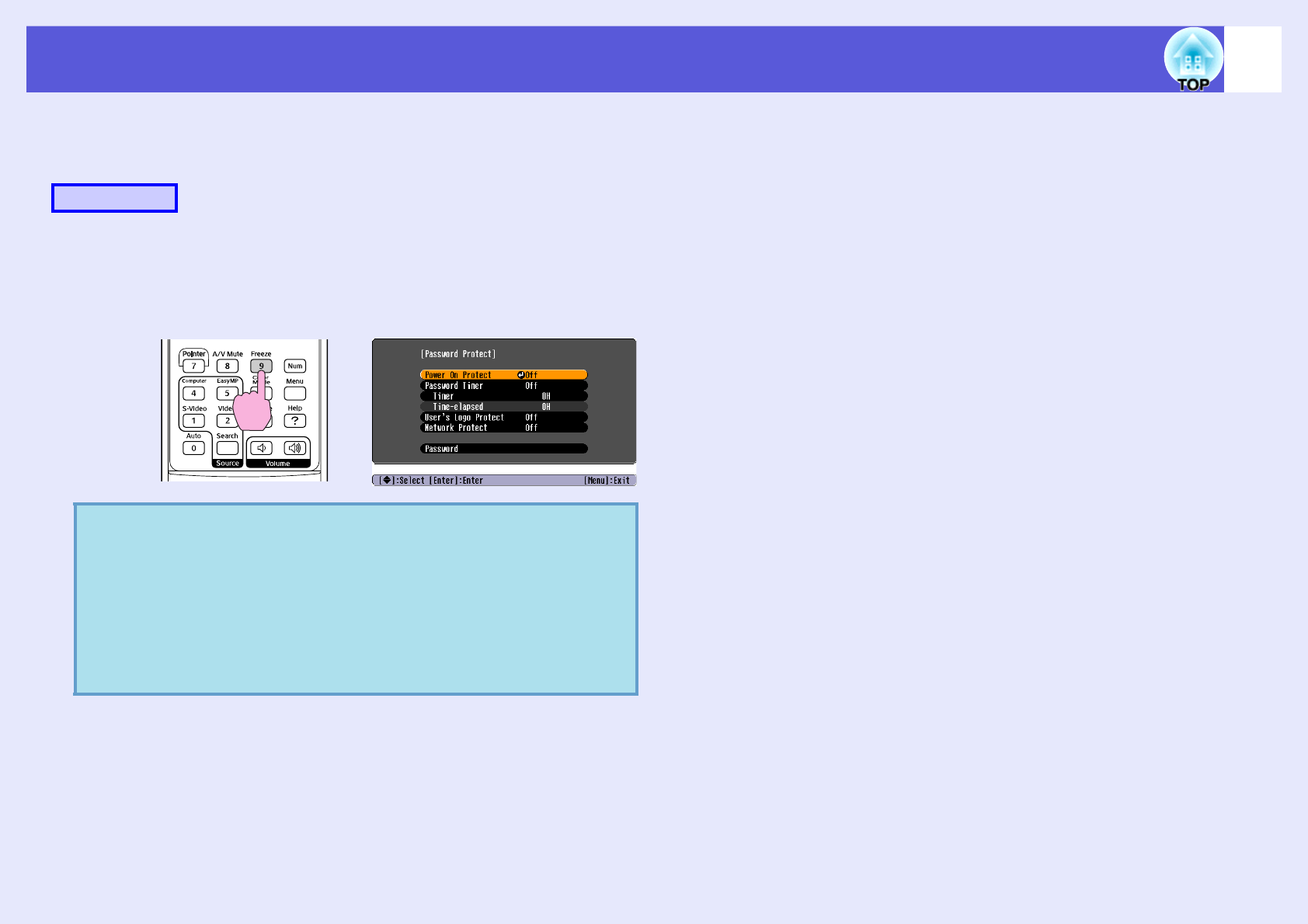
Security Functions 27
fSetting Password Protect
Use the following procedure to set Password Protect.
AHold down the [Freeze] button for about five
seconds.
The password protect setting menu is displayed.
BTurn on "Power On Protect".
(1) Select "Power On Protect", and then press the [Enter] button.
(2) Select "On", and then press the [Enter] button.
(3) Press the [Esc] button.
CTurn on "Password Timer".
If you do not use this setting, go to step 4.
(1) Select "Password Timer", and then press the [Enter] button.
(2) Select "On", and then press the [Enter] button.
(3) Press the [Esc] button.
(4) Select "Timer", and then press the [Enter] button.
(5) While holding down the [Num] button, use the numeric buttons
to enter the setting time within a range of 1 to 9999 hours and
then press the [Enter] button. If you make a mistake entering
the time, press the [Esc] button and re-enter the time. The time
counter begins when you close the password protect setting
menu. The count is only done while the lamp is lit, and not
while it is turned off.
The time already counted is displayed in "Time-elapsed".
DTurn on "User's Logo Protect".
(1) Select "User's Logo Protect", and then press the [Enter] button.
(2) Select "On", and then press the [Enter] button.
(3) Press the [Esc] button.
ETurn on "Network Protect" (EMP-1715/1705 only).
(1) Select "Network Protect", and then press the [Enter] button.
(2) Select "On", and then press the [Enter] button.
(3) Press the [Esc] button.
Procedure
q• If Password Protect is already activated, you must enter
the password.
If the password is entered correctly, the password protect
setting menu is displayed.
s
"Entering the password"
p.28
• When the password is set, stick the password protect
sticker in a visible position on the projector as a further
theft deterrent.
Remote control

Security Functions 28
FSet the password.
(1) Select "Password", and then press the [Enter] button.
(2) The message "Change the password?" is displayed, select
"Yes" and then press the [Enter] button. The default setting for
the password is "0000". Change this to your own desired
password. If you select "No", the screen shown in step 1 is
displayed again.
(3) While holding down the [Num] button, enter a four digit
number using the numeric buttons. The number entered is
displayed as "* * * *". When you enter the fourth digit, the
confirmation screen is displayed.
(4) Re-enter the password.
The message "Password accepted." is displayed.
If you enter the password incorrectly, a message is displayed
prompting you to re-enter the password.
fEntering the password
When the password entry screen is displayed, enter the password using the
numeric buttons on the remote control.
While holding down the [Num] button, enter the password
by pressing the numeric buttons.
When you enter the correct password, projection begins.
Remote control
Numeric buttons
Keep
pressed
Procedure
Attention
• If an incorrect password is entered three times in succession, the
message "The projector's operation will be locked." is displayed
for about five minutes, and then the projector switches to standby
mode. If this happens, disconnect the power plug from the
electrical outlet and then reinsert it and turn the projector's power
back on. The projector displays the password entry screen again
so that you can enter the correct password.
• If you have forgotten the password, make a note of the "Request
Code: xxxxx" number that appears on the screen and contact the
nearest address provided in the World-Wide Warranty Terms.
s
Inquiries
• If you continue to repeat the above operation and input the wrong
password thirty times in succession, the following message is
displayed and the projector does not accept any more password
entries. "The projector's operation will be locked. Contact Epson
as described in your documentation."
s
Inquiries
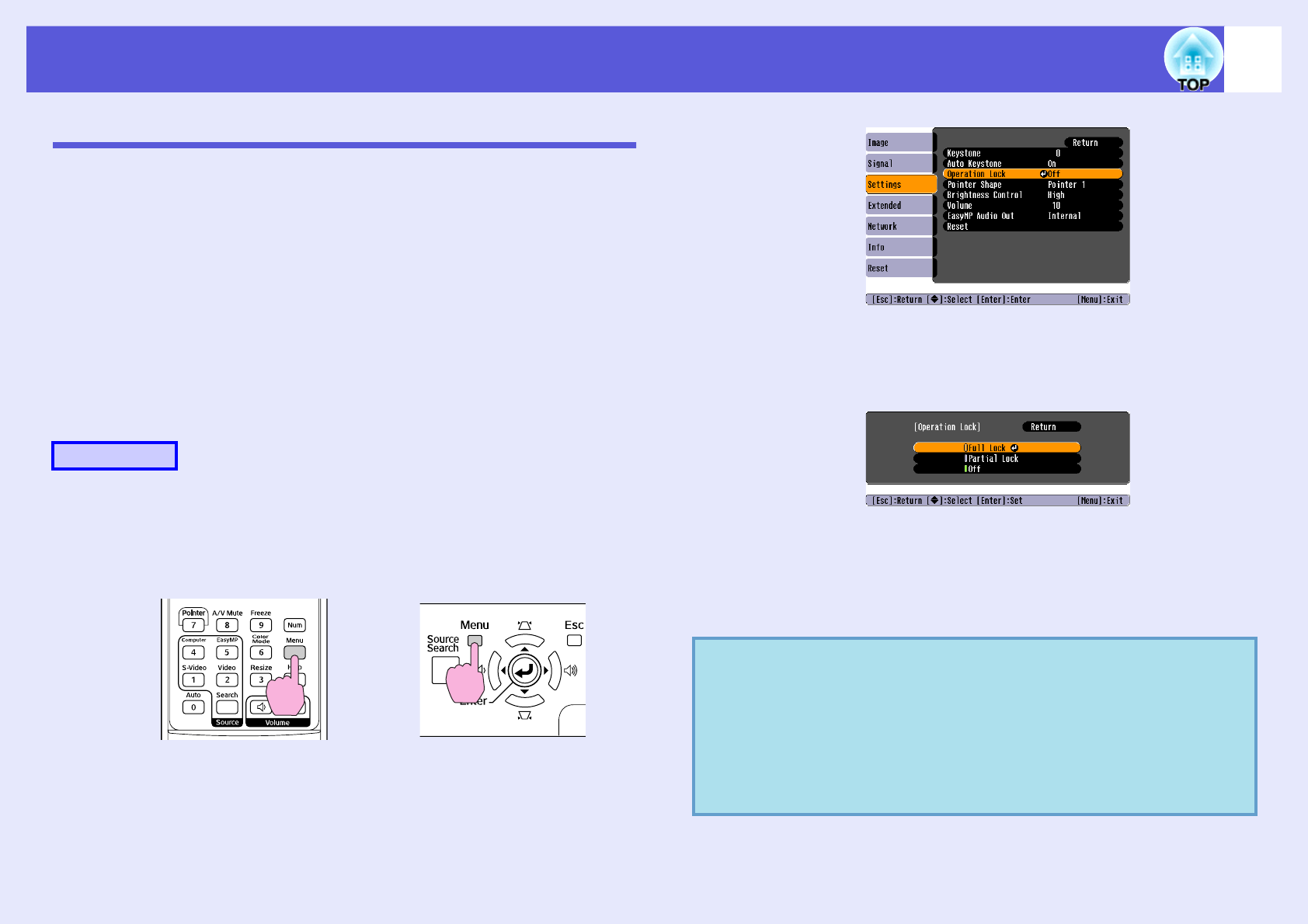
Security Functions 29
Restricting Operation (Operation Lock)
Do one of the following to lock the operation buttons on the control panel.
•Full lock
All of the buttons on the control panel are locked. You cannot perform
any operations from the control panel, including turning the power on or
off.
• Partial lock
All of the buttons on the control panel, except for the [Power] button,
are locked.
This is useful at events or shows when you want to deactivate all buttons
and only project, or at schools when you want to limit button operation.
The projector can still be operated using the remote control.
APress the [Menu] button and select "Settings" -
"Operation Lock". s"Using the Configuration
Menu" p.31
Check the buttons you can use and the operations they perform in
the guide under the menu.
BSelect either "Full Lock" or "Partial Lock".
CSelect "Yes" when the confirmation message is
displayed.
The control panel buttons are locked according to the setting you
chose.
Procedure
Using the remote control Using the control panel
qYou can release the control panel lock by one of the
following two methods.
• From the remote control, select "Off" in "Settings" -
"Operation Lock" from the configuration menu.
• Press and hold down the [Enter] button on the control
panel for about seven seconds, a message is displayed and
the lock is released.

Configuration Menu
This chapter explains how to use the configuration menu and its functions.
Using the Configuration Menu .......................... 31
List of Functions................................................. 32
• Image Menu .......................................................................32
• Signal Menu .......................................................................33
• Settings Menu ....................................................................34
• Extended Menu .................................................................35
• Network Menu (EMP-1715/1705 Only) ..........................37
• Info Menu (Display Only).................................................38
• Reset Menu ........................................................................39

31
Using the Configuration Menu
ASelecting from the
top menu CChanging the
selected item
BSelecting from the
sub menu
Top menu
Sub menu (Settings)
Guide
Select the setting to change
Using the remote control
Using the control panel
Buttons used
DExit
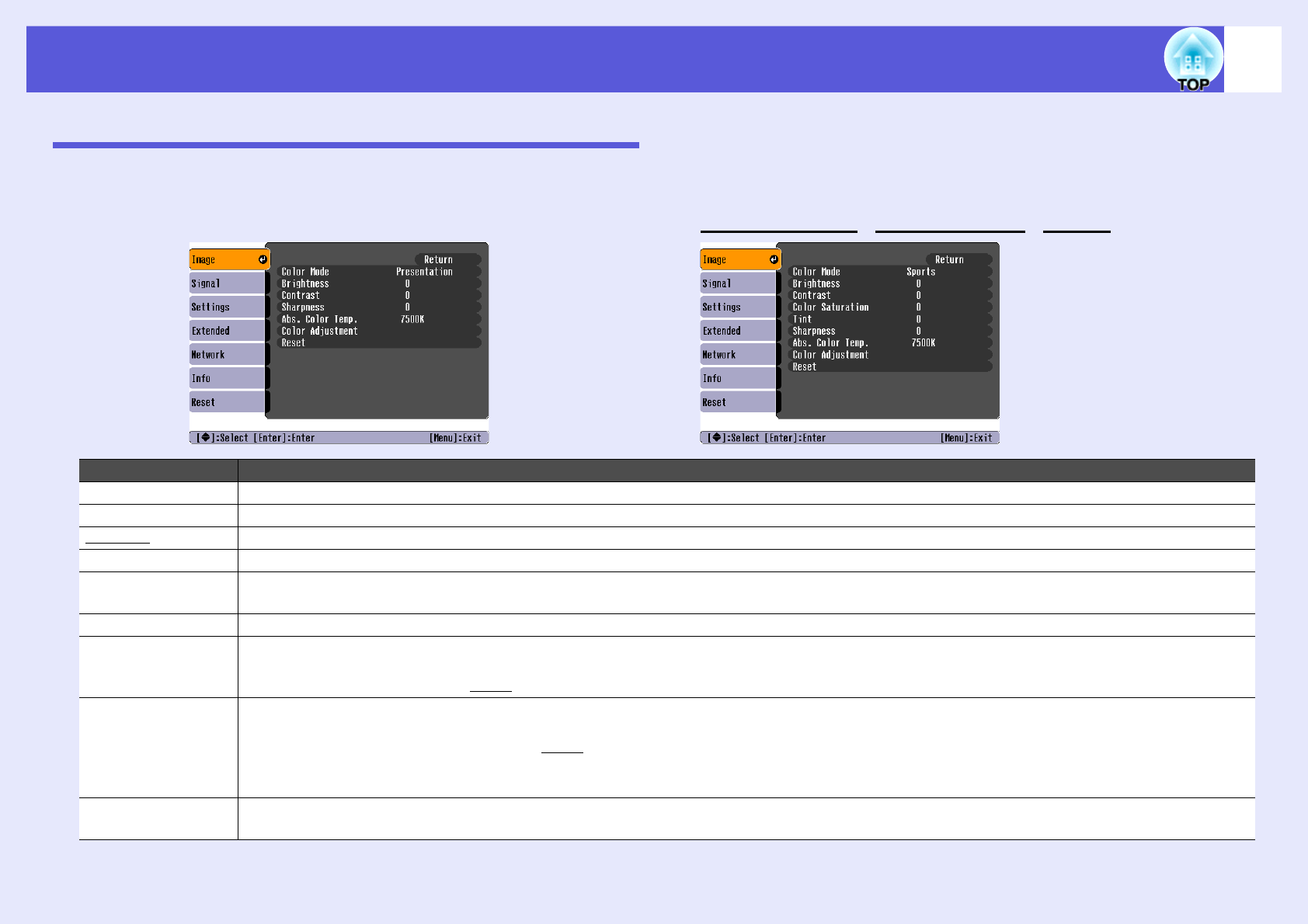
32
List of Functions
Image Menu
Items that can be set vary depending on the image signal currently being projected as shown in the following screen shots. Setting details are saved for each
image signal.
Sub Menu Function
Color Mode You can select the quality of the image to suit your surroundings. sp.15
Brightness You can adjust the image brightness.
ContrastgYou can adjust the difference between light and shade in the images.
Color Saturation You can adjust the colour saturation for the images.
Tint (Adjustment is only possible when NTSC signals are being input if you use composite video/S-video.)
You can adjust the image tint.
Sharpness You can adjust the image sharpness.
Abs. Color Temp. You can adjust the overall tint of the image. You can adjust tints in 10 stages from 5000 K to 10000 K. When a high value is selected the image
becomes tinged with blue, when a low value is selected the image becomes tinged with red.
(This item cannot be selected if "sRGBg" is selected as the "Color Mode" setting in the "Image" menu.)
Color Adjustment You can make adjustments by choosing one of the following
Red, Green, Blue: You can adjust the saturation of each colour individually.
(This item cannot be selected if values for "sRGBg" or "Customized" are selected from "Image" - "Color Mode".)
R, G, B, C, M, Y: You can adjust the strength of each colour R (red), G (green), B (blue), C (cyan), M (magenta), Y (yellow) individually.
(This item can only be selected when "Customized" is selected from "Image" - "Color Mode".)
Reset You can reset all adjustment values for the "Image" menu functions to their default settings. To return all menu items to their default settings, see
sp.39
Computer image Component videog/Composite videog/S-videog
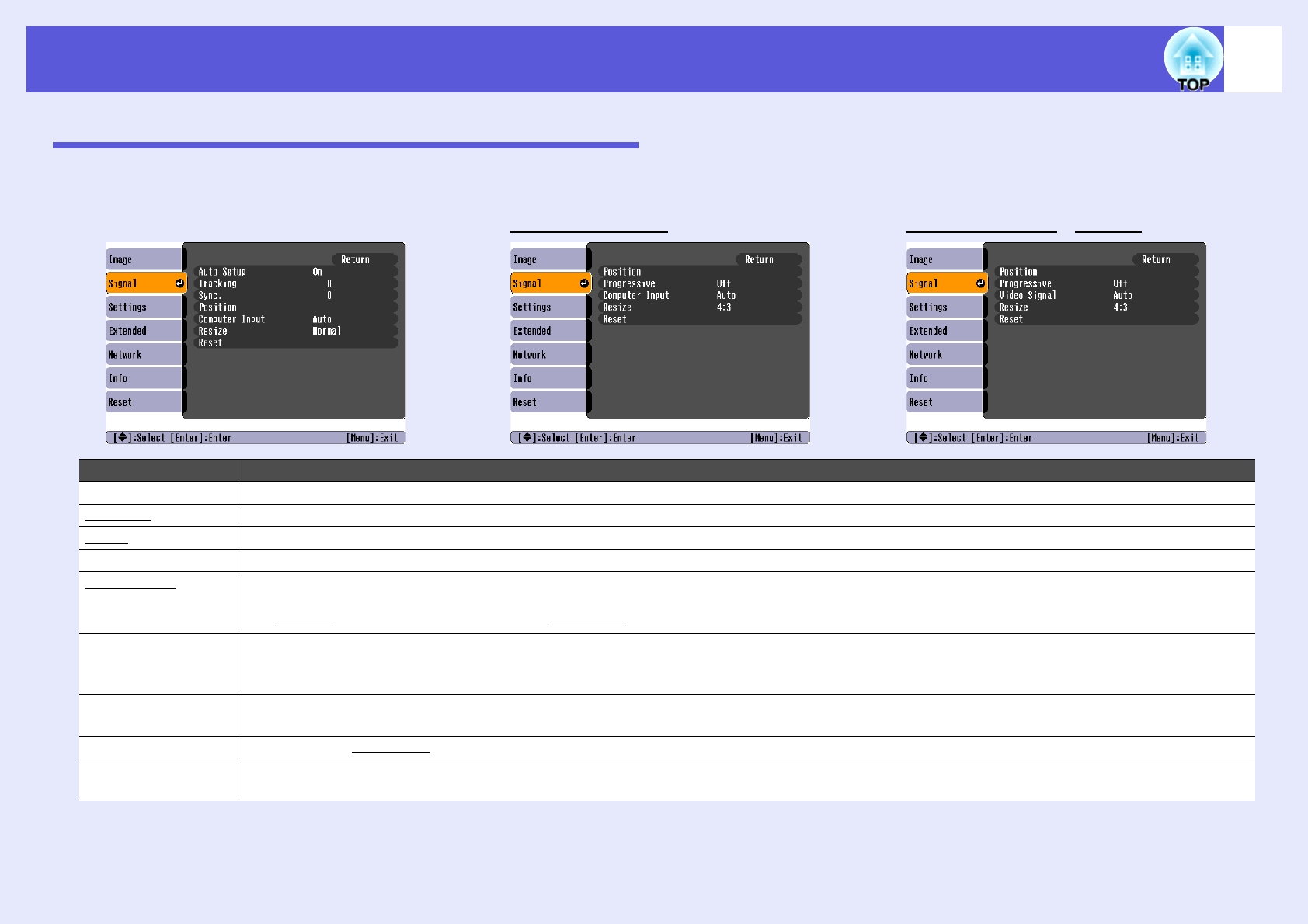
List of Functions 33
Signal Menu
Items that can be set vary depending on the image signal currently being projected as shown in the following screen shots. Setting details are saved for each
image signal.
Sub Menu Function
Auto Setup You can select whether, when the input signal changes, the image is automatically adjusted to the optimum state (On) or not (Off). sp.48
TrackinggYou can adjust computer images when vertical stripes appear in the images. sp.48
Sync.gYou can adjust computer images when flickering, fuzziness, or interference appear in the images. sp.48
Position You can adjust the display position up, down, left, and right when a part of the image is missing so that all of the image is projected.
Progressiveg(Component video can only be adjusted when 525i/625i signals are being input)
Off: IP conversion is carried out for each field in the screen. This is ideal for viewing images with a large amount of movement.
On: interlaceg (i) signals are converted into progressiveg (p) signals. This is ideal for viewing still images.
Computer Input You can select the input signal from Computer (Component Video) port.
If set to "Auto" the input signal is set automatically according to the connected equipment.
If colours do not appear correctly when set to "Auto", select the appropriate signal according to the connected equipment.
Video Signal If set to "Auto", video signals are recognized automatically. If interference appears in the image or a problem occurs such as no image is being
projected when set to "Auto", select the appropriate signal according to the connected equipment.
Resize You can set the aspect ratiog for projected images. sp.17
Reset You can reset all adjustment values on the "Signal" menu to their default settings, except for "Computer Input".
To return all menu items to their default settings, see sp.39
Computer image Component videogComposite videog/S-videog
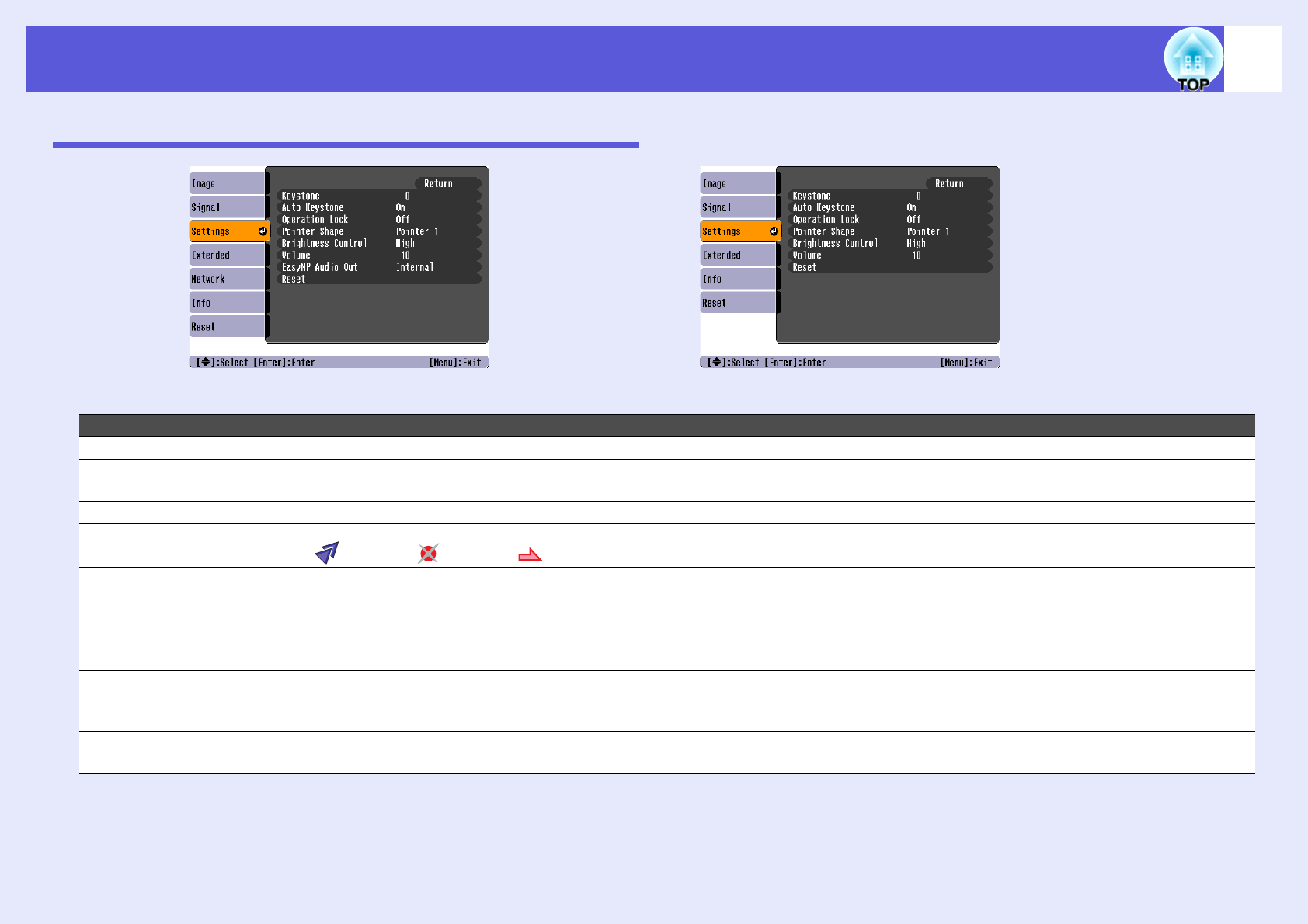
List of Functions 34
Settings Menu
Sub Menu Function
Keystone You can correct vertical keystone distortion in images. sQuick Start Guide
Auto Keystone You can correct keystone distortion automatically.
(This item can only be selected when "Front" is selected from "Extended" - "Projection")
Operation Lock You can use this to restrict operation of the projector's control panel. sp.29
Pointer Shape You can select the shape of the pointer. sp.18
Pointer 1: Pointer 2: Pointer 3:
Brightness Control You can set the lamp brightness to one of two settings.
Select "Low" if the images being projected are too bright such as when projecting images in a dark room or onto a small screen. When "Low" is
selected, the amount of electricity consumed and the lamp's operating life are changed as follows, and fan rotation noise during projection is
reduced. Electrical consumption: about a 46 W decrease, lamp life: about 1.5 times longer
Volume You can adjust the volume. sQuick Start Guide
EasyMP Audio Out
(EMP-1715/1705
only)
You can set the audio out method for EasyMP. The setting is only effective when projecting images with EasyMP.
You can output audio from an external amplifier's built-in speaker by setting this to "External". You can output audio from the projector's built-in
speaker by setting this to "Internal".
Reset You can reset all adjustment values for the "Settings" menu to their default settings.
To return all menu items to their default settings, see sp.39
For EMP-1715/1705 For EMP-1710/1700
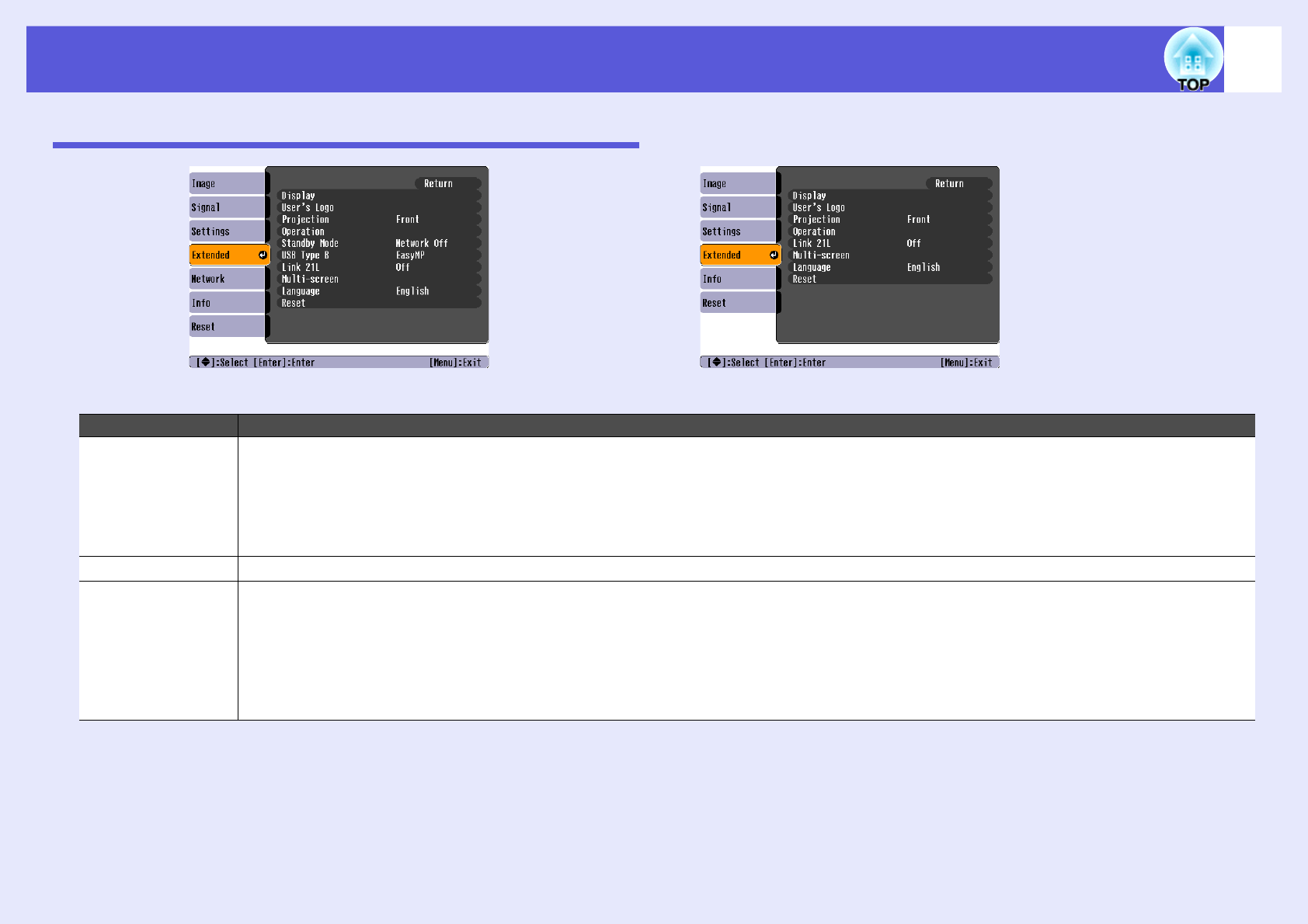
List of Functions 35
Extended Menu
Sub Menu Function
Display You can make settings related to the projector's display.
Messages: You can set whether to display (On) or not display (Off) the source name when you change the input source, the colour mode name when
you change the colour mode, a message when no image signal is input, and so on.
Display Background*: You can set the screen status for when no image signal is available to "Black", "Blue", or "Logo".
Startup Screen*: You can set if the startup screen (the image projected when starting the projector) is displayed or not.
A/V Mute*: You can set the screen displayed during A/V mute as "Black", "Blue", or "Logo".
User's Logo*You can change the user's logo that is displayed as a background and displayed during A/V Mute. sp.60
Projection You can set from the following according to the way the projector is setup. sp.53
"Front" "Front/Ceiling" "Rear" "Rear/Ceiling"
You can change the setting as follows by pressing down the [A/V Mute] button on the remote control for about five seconds.
"Front"W"Front/Ceiling"
"Rear"W"Rear/Ceiling"
* When set to "Front/Ceiling" or "Rear/Ceiling", you cannot disconnect the power cable immediately because cool down is performed after the
power is turned off.
* When "User's Logo Protect" is set to "On" in "Password Protect", settings concerning user's logo cannot be changed. You can make changes after setting "User's
Logo Protect" to "Off". sp.27
For EMP-1715/1705 For EMP-1710/1700
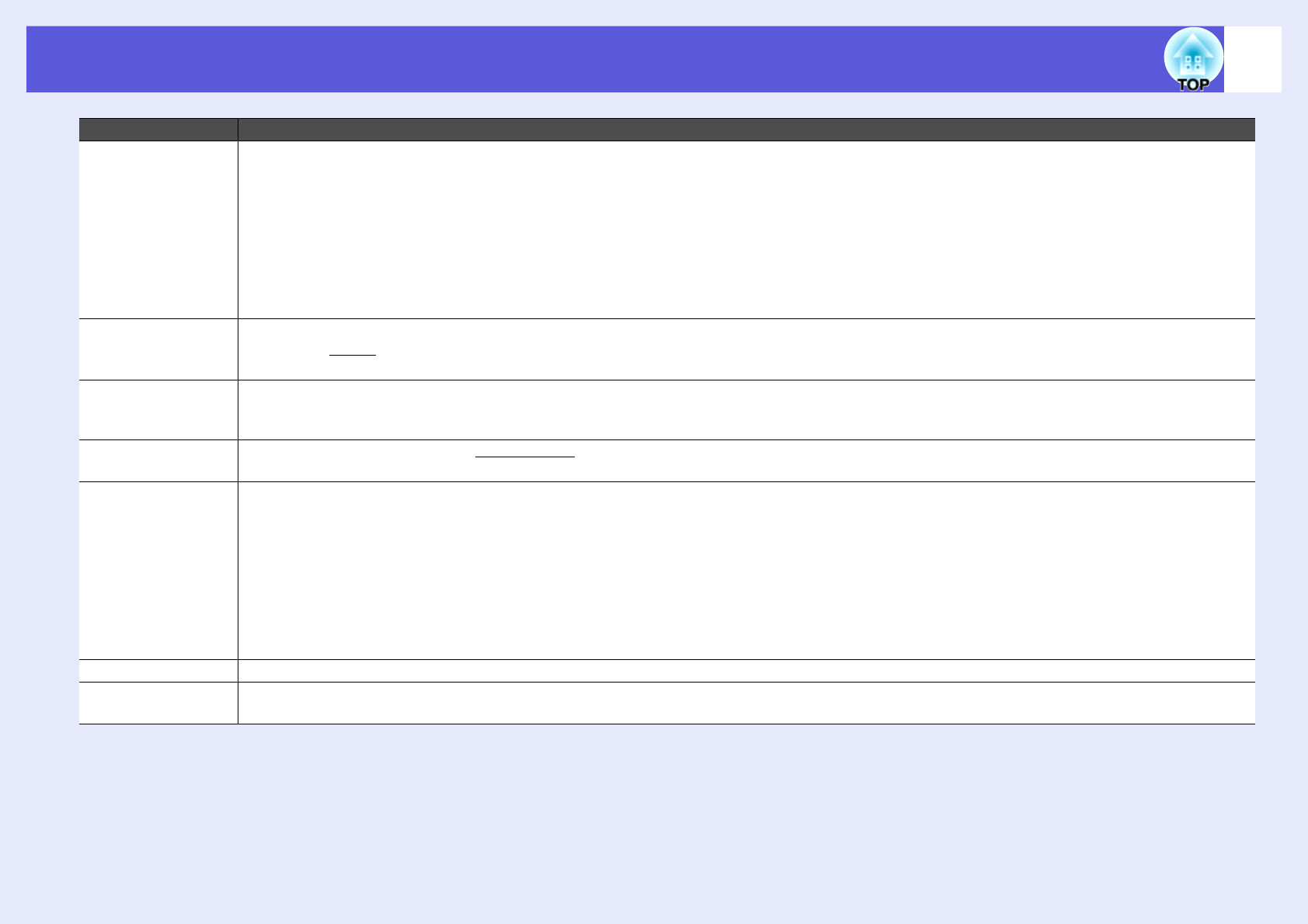
List of Functions 36
Operation Direct Power On: You can set whether Direct Power On is enabled (On) or disabled (Off).
When it is set to "On" and the projector power cable is connected to an electrical outlet, be aware that sudden surges of electricity when power
comes back on after a power outage may cause the projector to turn on automatically.
Sleep Mode:
• You can set whether projection stops automatically (On) or not (Off) when no operations are carried out for about 30 minutes while no image
signals are being input.
• You can set whether the power turns off automatically (On) or not (Off) after about 30 minutes when the A/V mute slide is closed.
Sleep mode is set to (Off) at the time of purchase, so do not forget to turn off the power after projecting.
High Altitude Mode: Set to "On" when using the projector above an altitude of 1500 m.
Standby Mode
(EMP-1715/1705
only)
You can use network monitoring and control functions while the projector is in standby mode when this is set to "Network On".
You can use SNMPg to monitor and control the status of the projector over the network, or by using the "EMP Monitor" software supplied with this
product.
USB Type B
(EMP-1715/1705
only)
Set to "EasyMP" when the projector and a computer are connected by a USB cable and computer images are projected. sWireless LAN Quick
Connection Guide
Link 21L You can set whether or not to use EMP Link21Lg utility software.
(Select it after setting "USB Type B" to "Link 21L".)
Multi-screen You can adjust the hue and brightness of each projected image when multiple projectors are lined up and projecting. sp.23
Screen ID: When performing "Image Correction" for "Multi-screen" by using one remote control for multiple projector's, you can define which
projector to use when individual IDs are set.
The IDs set here are only effective during "Image Correction" for "Multi-screen".
Image Correction: You can make the following adjustments.
• Adjustment Level: You can adjust from black to white in five stages called levels 1 to 5, and in each level 1to 5 you can adjust "Brightness
Correct." and "Color Correct".
• Brightness Correct.: Corrects the difference in the brightness of each product.
• Color Correct. (G/R) / Color Correct. (B/Y): You can correct the difference in the colour of each product.
Language You can set the language for message displays.
Reset You can reset "Display*1" and "Operation*2", in the "Extended" menu to their default settings.
To return all menu items to their default settings, see sp.39
*1 When "User's Logo Protect" is set to "On" in "Password Protect", settings relating to user's logo cannot be changed. You can make changes after setting "User's
Logo Protect" to "Off". sp.27
*2 Except for "High Altitude Mode".
Sub Menu Function
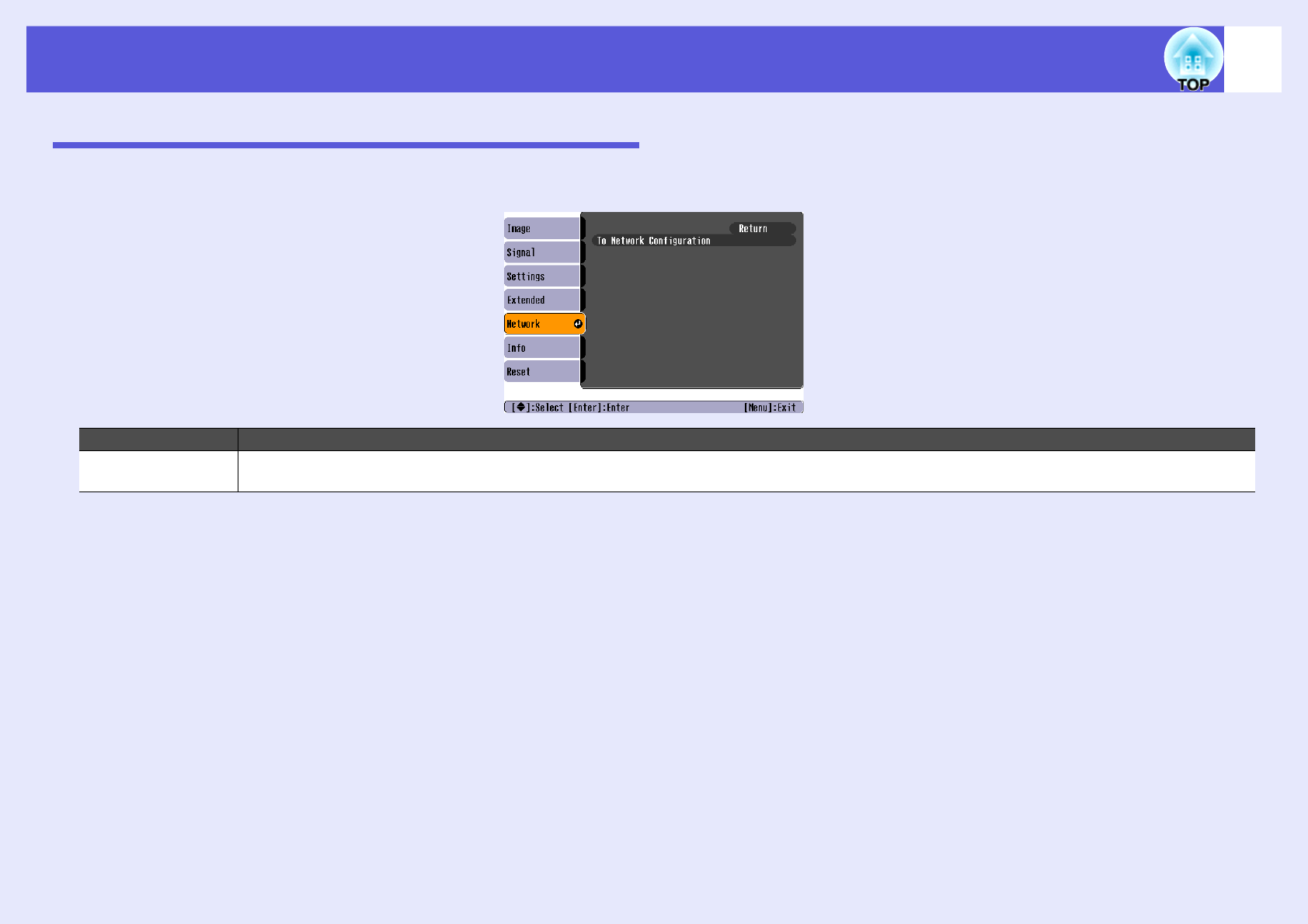
List of Functions 37
Network Menu (EMP-1715/1705 Only)
When "Network Protect" is set to "On" in "Password Protect", a message is displayed and the settings cannot be changed. You can make changes after
setting "Network Protect" to "Off". sp.27
Sub Menu Function
To N etwork
Configuration
You can display the network settings screen. sEasyMP Operation Guide "Preparing the Projector", Wireless LAN Quick Connection Guide
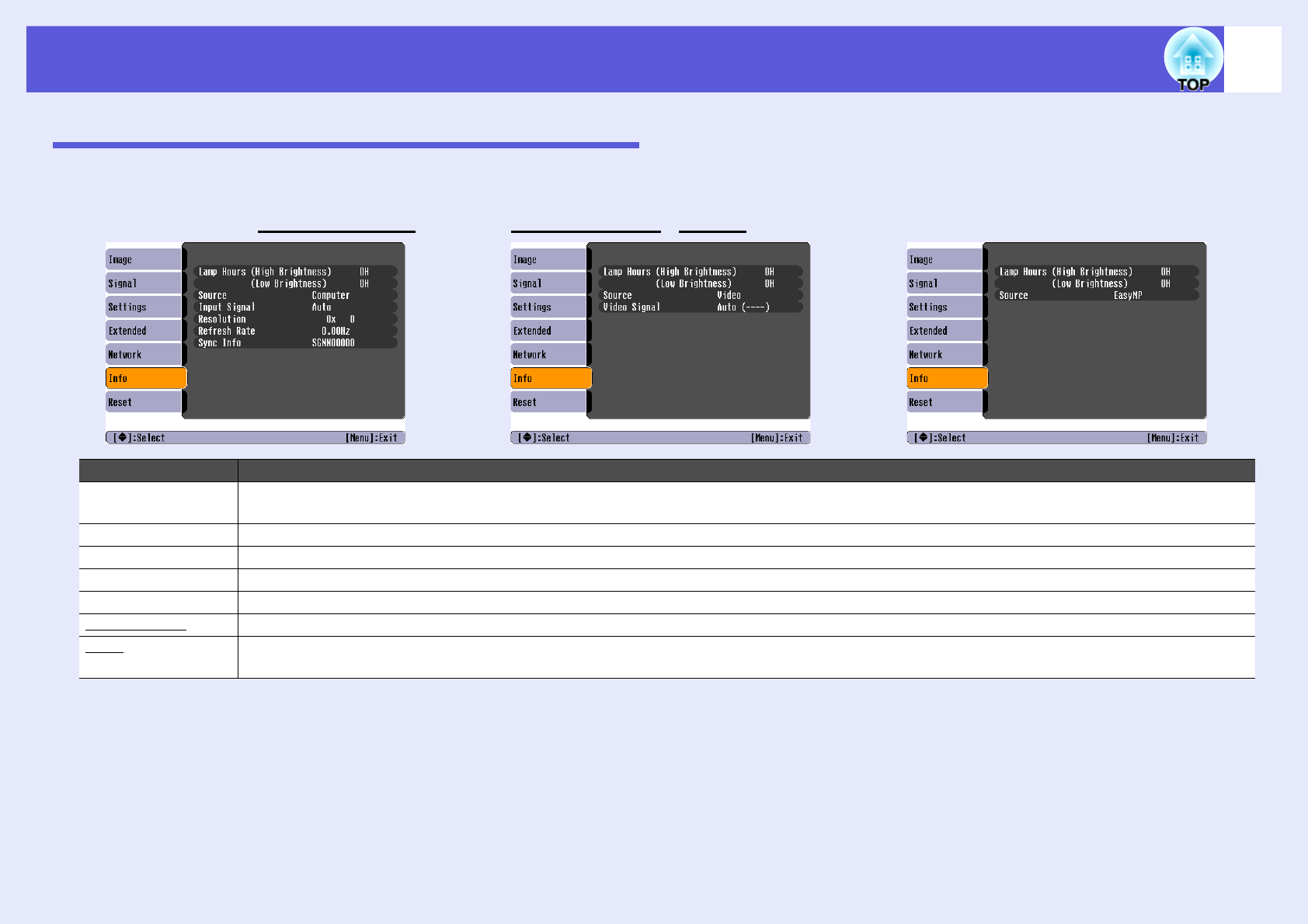
List of Functions 38
Info Menu (Display Only)
Lets you check the status of the image signals being projected and the status of the projector. Items displayed vary depending on the image signal currently
being projected as shown in the following screen shots.
Sub Menu Function
Lamp Hours You can display the cumulative lamp operating time*.
When it reaches the lamp warning time, the characters are displayed in yellow.
Source You can display the input port name for the connected equipment currently being projected.
Input Signal You can display the content of "Computer" set in the "Signal" menu according to the "Source".
Resolution You can display the input resolution.
Video Signal You can display the content of "Video Signal" set in the "Signal" menu.
Refresh RategYou can display the refresh rate.
Syncg Info You can display the image signal information.
This information may be needed if service is required.
* The cumulative use time is displayed as "0H" for the first 10 hours.
Computer image/Component videogComposite videog/S-videogEasyMP
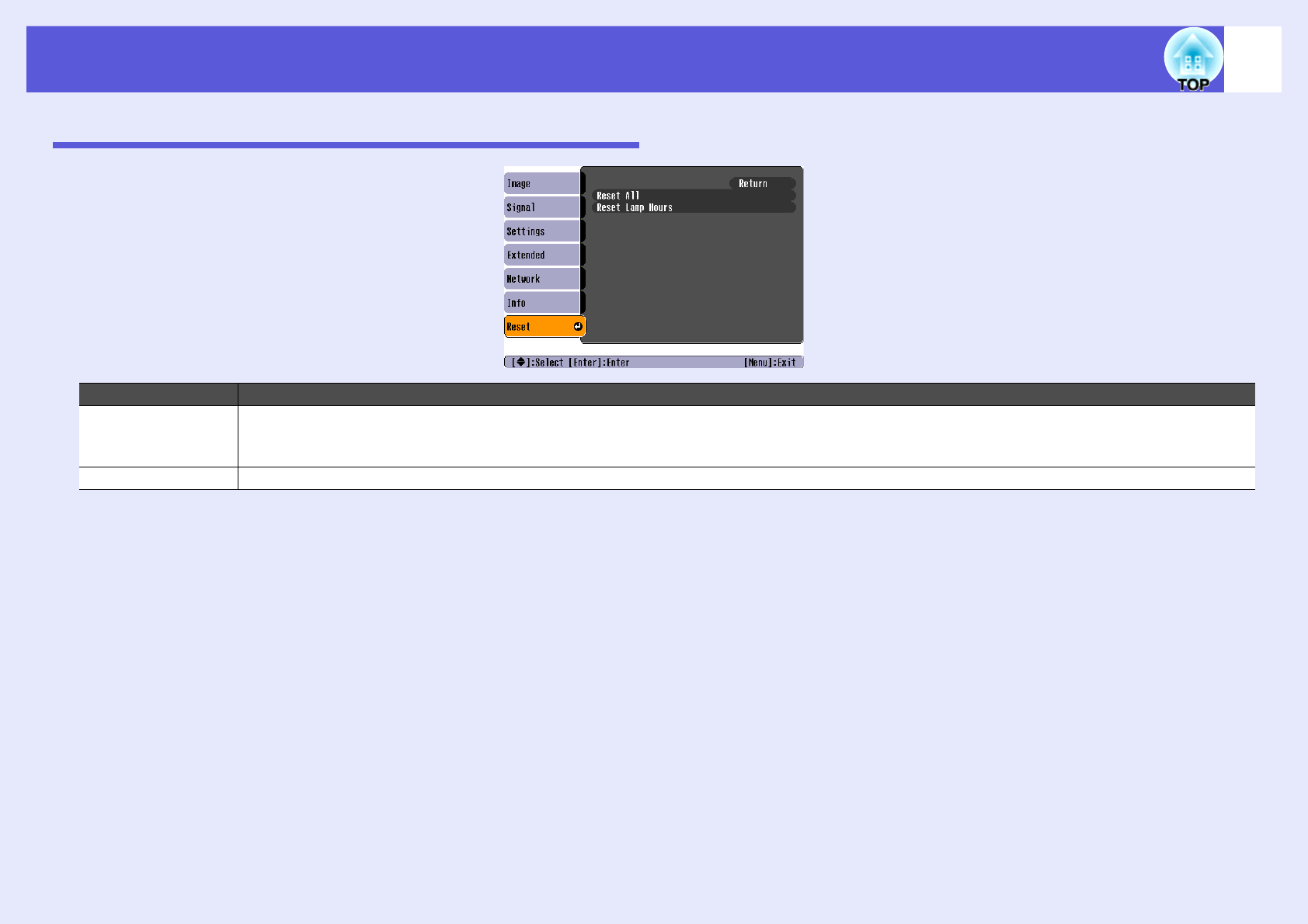
List of Functions 39
Reset Menu
Sub Menu Function
Reset All You can reset all items in all menus to their default settings.
The following items are not reset to their defaults: "Computer Input", "User's Logo", "Multi-screen", all items for "Network" menus, "Lamp Hours",
and "Language".
Reset Lamp Hours You can clear the cumulative lamp hours use time, and return it to "0H". Reset when you replace the lamp.

Troubleshooting
This chapter describes how to identify problems and what to do if a problem is found.
Using the Help..................................................... 41
Problem Solving ................................................. 42
• Reading the Indicators......................................................42
t Power indicator lights red ..........................................................43
i · o Indicator is lit or flashing orange.........................................44
• When the Indicators Provide No Help ............................45
Problems relating to images ...........................................................46
Problems when projection starts.....................................................49
Other problems ...............................................................................50

41
Using the Help
If a problem occurs with the projector, Help uses on-screen displays to
assist you in solving the problem.
APress the [Help] button.
The help screen is displayed.
BSelect a menu item.
CConfirm the selection.
DUse the same operations as procedures 2 and 3 to
proceed through the menu to more detailed items.
Press the [Help] button to exit Help.
Procedure
Using the remote control Using the control panel
Using the remote control Using the control panel
qIf Help does not provide a solution to the problem, refer to
"Problem Solving" (
s
p.42).
Using the control panelUsing the remote control

42
Problem Solving
If you are having a problem with the projector, first check the projector's indicators and refer to "Reading the Indicators" below.
If the indicators do not show clearly what the problem might be, refer to "When the Indicators Provide No Help". sp.45
Reading the Indicators
The projector is provided with the following three indicators that indicate the operating status of the projector.
Refer to the following table to see what the indicators mean and how to remedy problems that they indicate.
If all indicators are off, check that the power cable is connected correctly and that the power is being supplied normally.
Sometimes, when the power cable is unplugged, the t indicator remains lit for a short period, this is not a fault.
Indicates the operating status.
Orange : Standby condition
When the [Power] button is pressed in this condition, projection starts.
Green : Warm-up in progress
Warm-up time is about 30 seconds. After warm-up is complete, the indicator stops flashing.
Green : Projection in progress
Indicates the projection lamp status.
Indicates the internal temperature status.
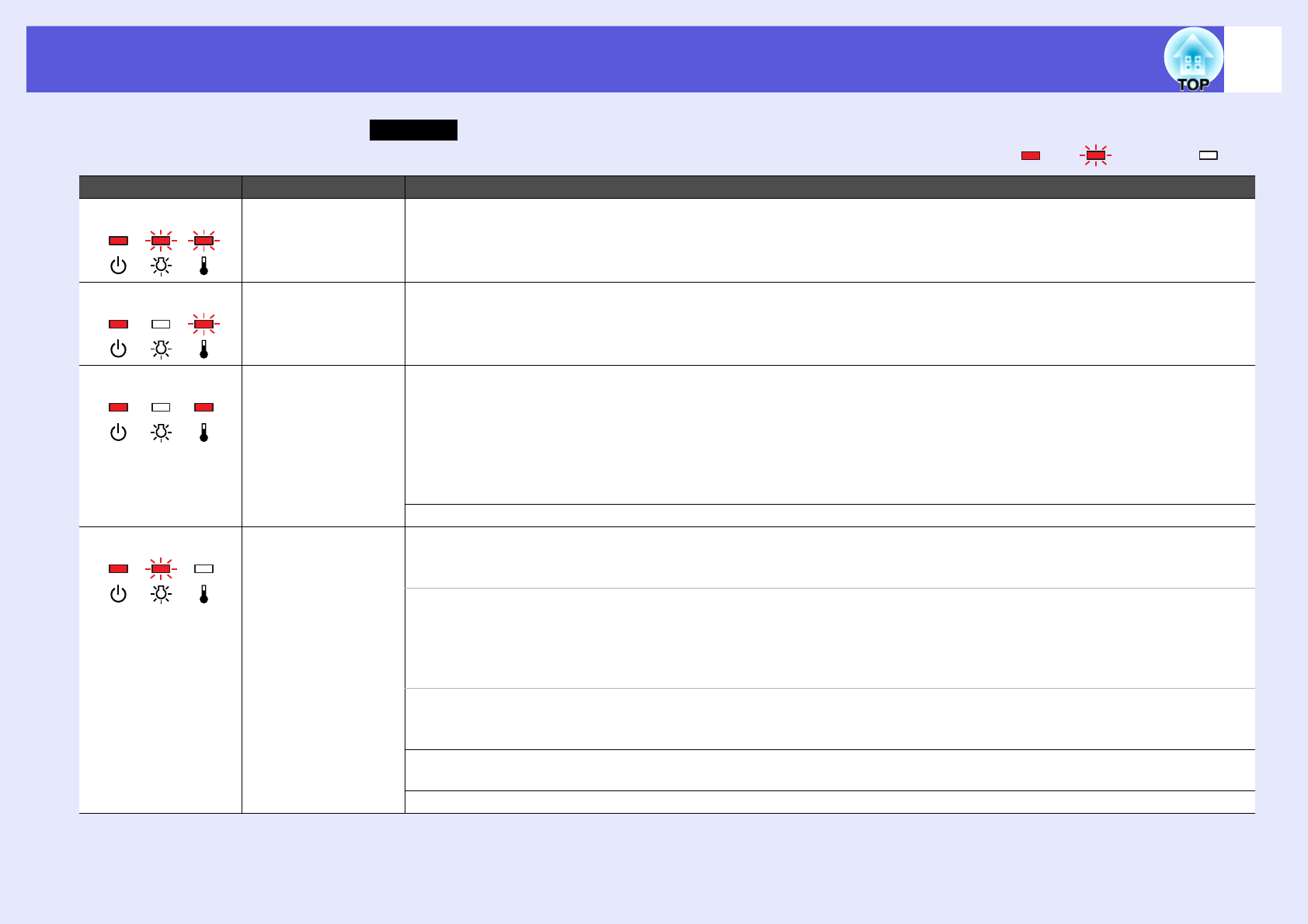
Problem Solving 43
ft Power indicator lights red
: Lit : Flashing: : Off
Status Cause Remedy or Status
Internal Error Stop using the projector, disconnect the power cable from the electrical outlet, and contact your local dealer or the nearest
address provided in the World-Wide Warranty Terms. sInquiries
Fan Error
Sensor Error
Stop using the projector, disconnect the power cable from the electrical outlet, and contact your local dealer or the nearest
address provided in the World-Wide Warranty Terms. sInquiries
High Temp Error
(overheating)
The lamp turns off automatically and projection stops. Wait for about five minutes. After about five minutes the projector
switches to standby mode, so check the following two points.
• Check that the air filter and air exhaust vent are clear, and that the projector is not positioned against a wall.
• If the air filter is clogged, clean or replace it. sp.54, 59
If the error continues after checking the points above, stop using the projector, disconnect the power cable from the
electrical outlet, and contact your local dealer or the nearest address provided in the World-Wide Warranty Terms.
sInquiries
When using at an altitude of 1500 m or more, set "High Altitude Mode" to "On". sp.36
Lamp Error
Lamp Failure
Lamp Cover Open
Check the following two points.
• Take out the lamp and check if it is cracked. sp.56
• Clean the air filter. sp.54
If it is not cracked _ Re-fit the lamp and turn on the power.
If the error continues _ Replace the lamp with a new lamp and turn on the power.
If the error continues _Stop using the projector, disconnect the power cable from the electrical outlet, and contact
your local dealer or the nearest address provided in the World-Wide Warranty Terms.
sInquiries
If it is cracked _Replace it with a new lamp, or contact your local dealer for further advice. If replacing the lamp
yourself, be careful to avoid pieces of broken glass (you cannot continue projecting until the lamp is
replaced).
Check that the lamp cover and the lamp are securely installed. sp.56
If the lamp cover or the lamp is not securely installed, the lamp does not switch on.
When using at an altitude of 1500 m or more, set "High Altitude Mode" to "On". sp.36
Abnormal
RedRedRed
RedRed
RedRed
RedRed
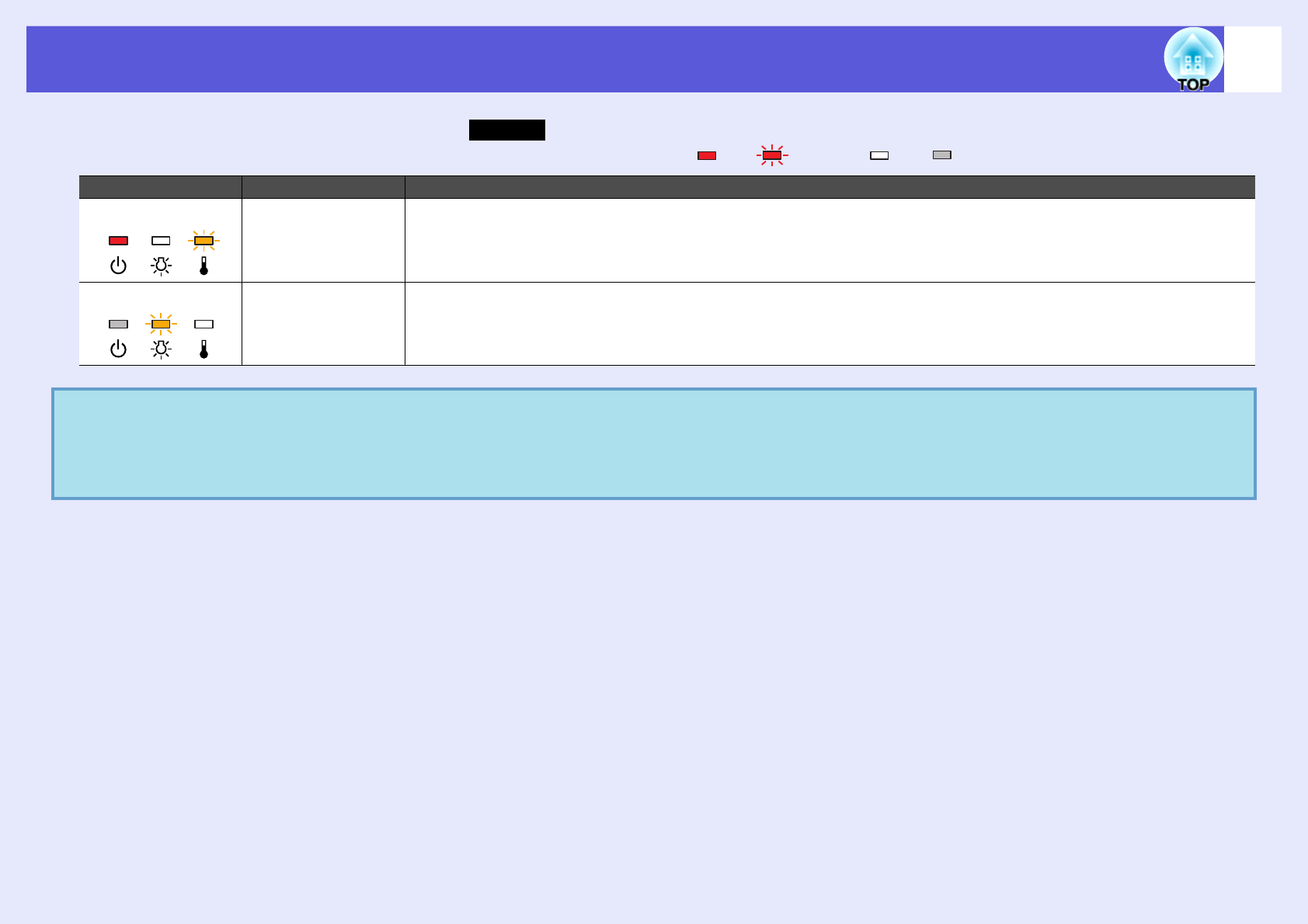
Problem Solving 44
fi · o Indicator is lit or flashing orange
: Lit : Flashing : Off : Varies according to the projector status
Status Cause Remedy or Status
High Temp Warning (This is not an abnormality. However, if the temperature rises too high again, projection stops automatically.)
• Check that the air filter and air exhaust vent are clear, and that the projector is not positioned against a wall.
• If the air filter is clogged, clean or replace it. sp.54, 59
Replace Lamp Replace it with a new lamp. sp.56
If you continue to use the lamp after the replacement period has passed, the possibility that the lamp may explode
increases. Replace it with a new lamp as soon as possible.
q• If the projector is not operating properly, even though the indicators are all showing normal, refer to "When the Indicators Provide No
Help" (
s
p.45).
• If an indicator is displaying a status not described in the tables, contact your local dealer or the nearest address provided in the World-Wide
Warranty Terms.
s
Inquiries
Warning
OrangeRed
Orange
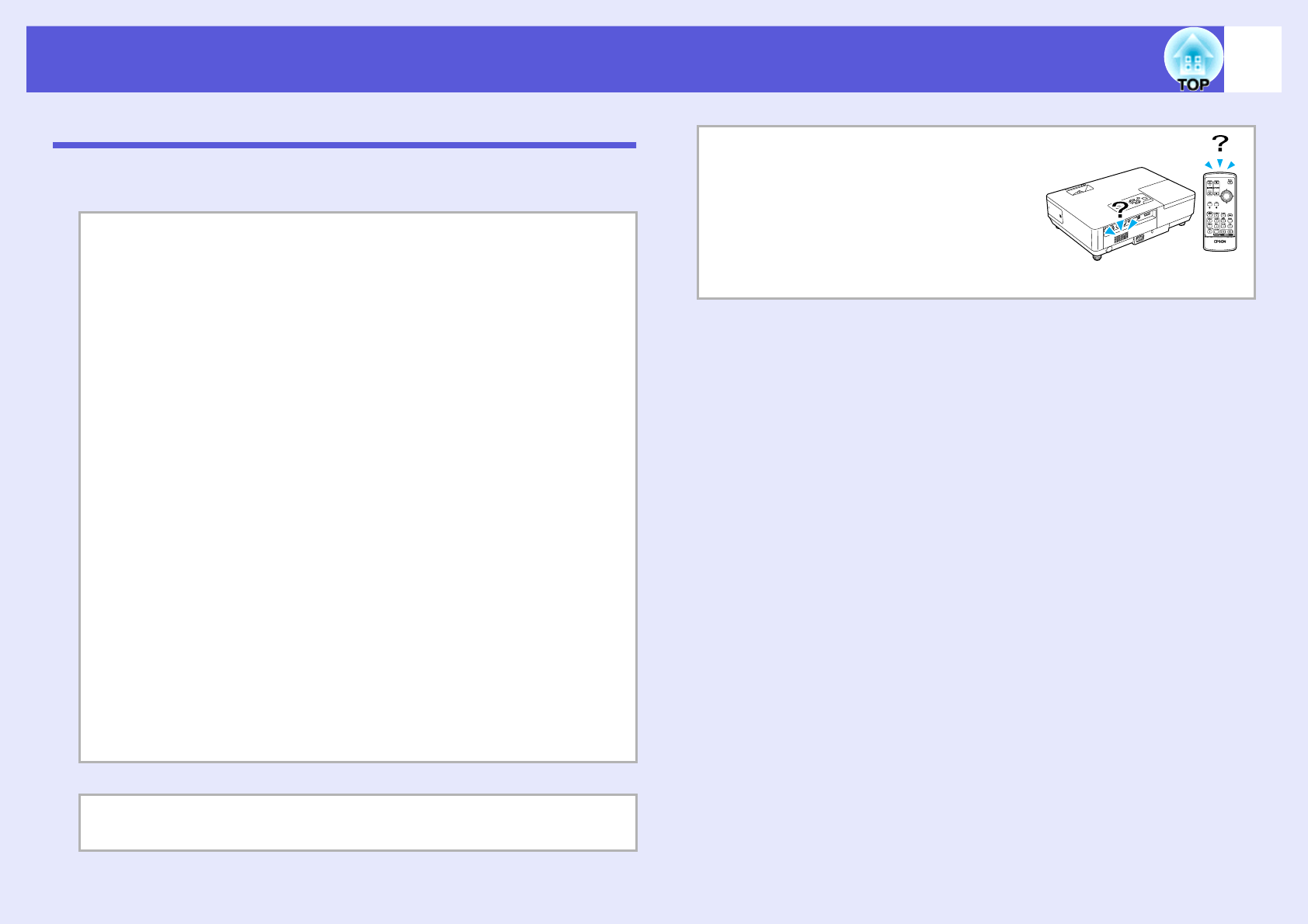
Problem Solving 45
When the Indicators Provide No Help
If any of the following problems occur and the indicators do not offer a
solution, refer to the pages given for each problem.
Problems relating to images
fNo images appear sp.46
Projection does not start, the projection area is completely black, the
projection area is completely blue, and so on.
fMoving images are not displayed sp.46
Moving images being projected from a computer appear black and
nothing is projected.
fProjection stops automatically sp.46
fThe message "Not supported." is displayed sp.47
fThe message "No Signal." is displayed sp.47
fImages are fuzzy or out of focus sp.47
fInterference or distortion appears in images sp.48
Problems such as interference, distortion, or black & white checked
patterns appear.
fThe image is truncated (large) or small, or the aspect is not
suitable sp.48
Only part of the image is displayed, or the height and width ratios of the
image are not correct, and so on.
fImage colours are not right sp.49
The whole image appears purplish or greenish, images are black & white,
colours appear dull, and so on.
(Computer monitors and LCD screens have different colour reproduction
performance, so that the colours projected by the projector and the
colours appearing on the monitor may not necessarily match, but this is
not a sign of a problem.)
fImages appear dark sp.49
Problems when projection starts
fPower does not turn on sp.49
Other problems
fNo sound can be heard or the
sound is faint sp.50
fThe remote control does not work
sp.50
fMail is not received even if an
abnormality occurs in the
projector sp.51

Problem Solving 46
fProblems relating to images
fNo images appear
fMoving images are not displayed
fProjection stops automatically
Check Remedy
Did you press the [Power] button? Press the [Power] button to turn the power on.
Are the indicators switched off? The power cable is not connected correctly or power is not being supplied normally.
Connect the projector's power cable correctly. sQuick Start Guide
Check that your electrical outlet or power source is functioning correctly.
Is A/V Mute active? Press the [A/V Mute] button on the remote control to cancel A/V Mute. sp.16
Is the A/V mute slide closed? Open the A/V mute slide.
Are the configuration menu settings correct? Reset all of the settings. s"Reset"-"Reset All" p.39
Is the projected image completely black? Some input images, such as screen savers, may be completely black.
Is the image signal format setting correct? Change the setting according to the signal for the connected equipment. s"Signal"-"Video Signal" p.33
Check Remedy
Is the computer's image signal being output to the LCD and
the monitor?
Change the image signal to external output only. s Check your computer's documentation.
Check Remedy
Is "Sleep Mode" set to "On"? Press the [Power] button to turn the power on. If you do not want to use "Sleep Mode", change the setting to
"Off". s"Extended"-"Operation"-"Sleep Mode" p.36
Only when projecting computer images
Only when projecting images from a video source
Only when projecting images from a laptop
computer or a computer with a built-in LCD screen
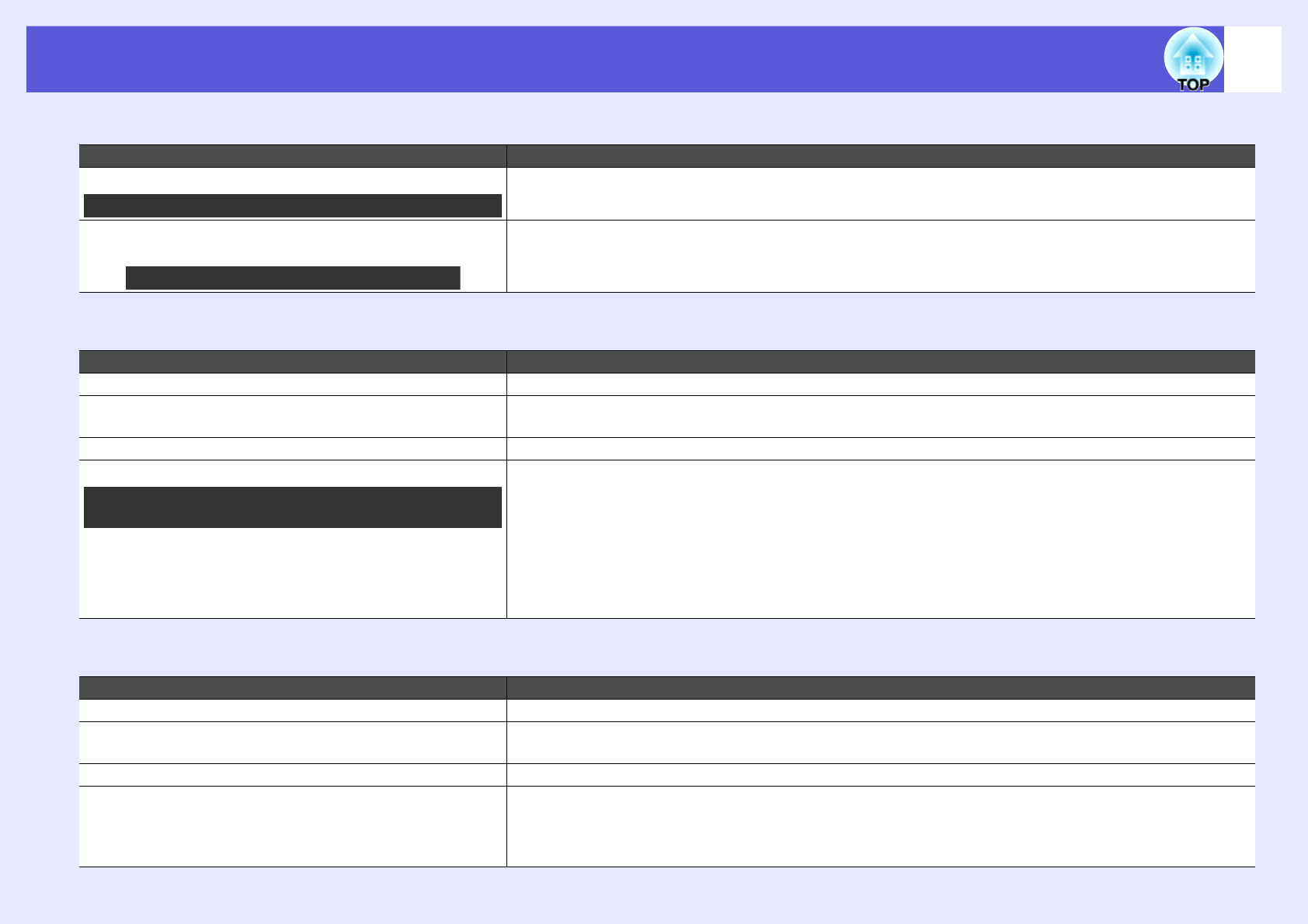
Problem Solving 47
fThe message "Not supported." is displayed
fThe message "No Signal." is displayed
fImages are fuzzy or out of focus
Check Remedy
Is the image signal format setting correct? Change the setting according to the signal for the connected equipment. s"Signal"-"Video Signal" p.33
Do the image signal resolution and the refresh rate
correspond to the mode?
Refer to the computer's documentation for how to change the image signal resolution and the refresh rate
output from the computer. s"List of supported monitor displays" p.70
Check Remedy
Are the cables connected correctly? Check that all the cables required for projection are securely connected. sQuick Start Guide
Is the correct input port selected? Change the image by pressing the [Source Search] button on the remote control or the control panel.
sp.13
Is the power for the computer or video source turned on? Turn the power on for the equipment.
Are the image signals being output to the projector? If the image signals are only being output to the computer's LCD monitor or to the accessory monitor, you
need to change the output to an external destination as well as the computer's own monitor. For some
computer models, when the image signals are output externally, they no longer appear on the LCD monitor
or accessory monitor. sComputer's documentation, under a title such as "External output" or "Connecting
an external monitor".
If the connection is made while the power of the projector or computer is already turned on, the function
[Fn] key that changes the computer's image signal to external output may not work. Turn the power for the
computer and the projector off and then back on again.
Check Remedy
Is the focus adjusted correctly? Turn the focus ring to adjust the focus.
Is the projector at the correct distance? The recommended projection distance ranges from 99 to 1211 cm (38.98 to 476.77 in.).
Setup within this range. sp.62
Is the Keystone adjustment value too large? Lower the projection angle to reduce the amount of keystone correction.
Has condensation formed on the lens? If the projector is suddenly taken from a cold environment to a warm environment, or if sudden ambient
temperature changes occur, condensation may form on the surface of the lens, and this may cause the images
to appear fuzzy. Set the projector up in the room about one hour before it is used. If condensation forms on
the lens, turn the projector off and wait for the condensation to disappear.
Only when projecting images from a video source
Only when projecting computer images
Only when projecting images from a laptop
computer or a computer with a built-in LCD screen
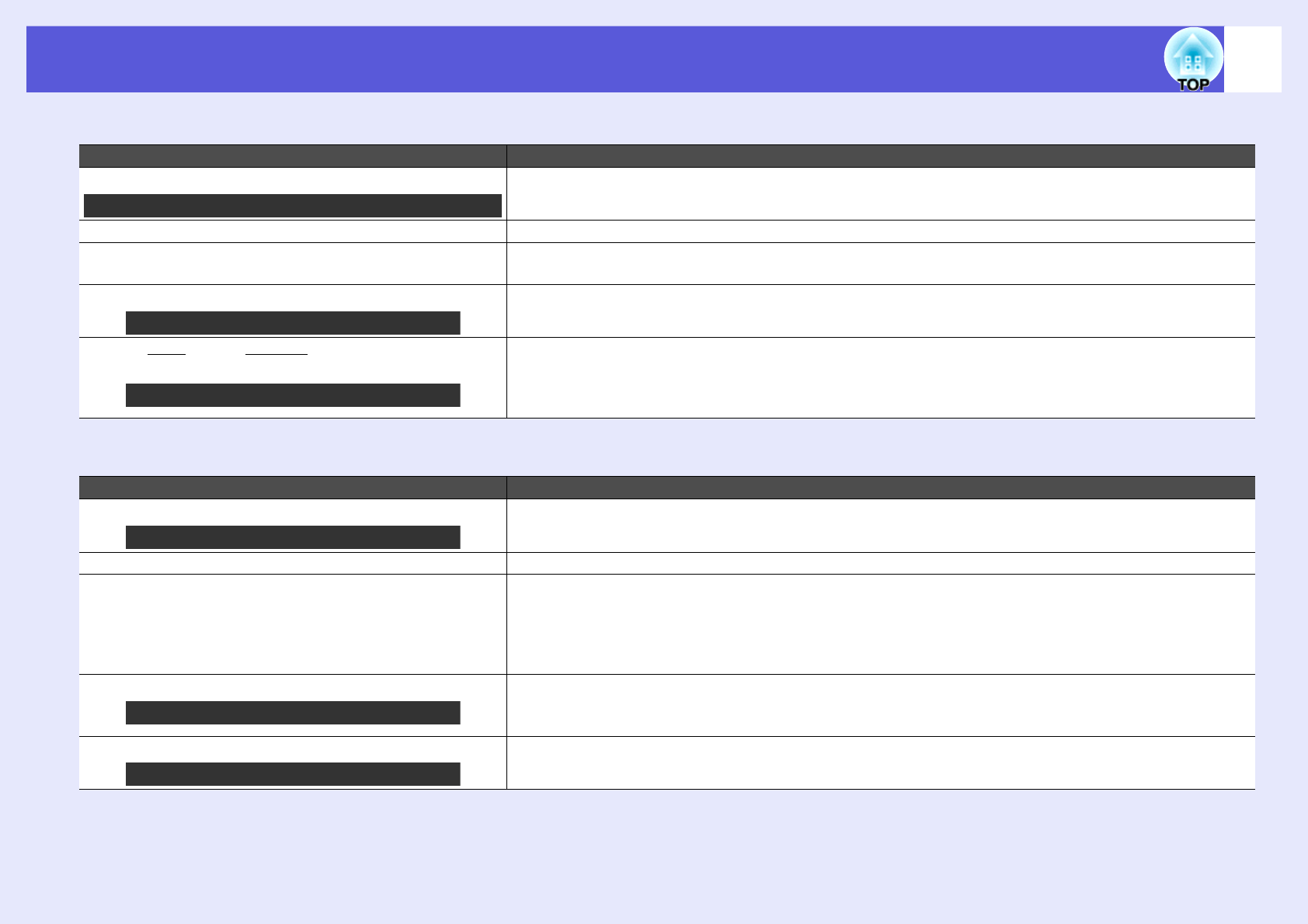
Problem Solving 48
fInterference or distortion appear in images
fThe image is truncated (large) or small, or the aspect is not suitable
Check Remedy
Is the image signal format setting correct? Change the setting according to the signal for the connected equipment. s"Signal"-"Video Signal" p.33
Are the cables connected correctly? Check that all the cables required for projection are securely connected. sQuick Start Guide
Is an extension cable being used? If an extension cable is used, electrical interference may affect the signals. Use the cables supplied with the
projector to check if the cables you are using may be causing the problem.
Is the correct resolution selected? Set the computer so that the signals being output are compatible with this projector.
s "List of Supported Monitor Displays" p.70 sComputer documentation
Are the "Sync.g" and "Trackingg" settings adjusted
correctly?
Press the [Auto] button on the remote control or the [Enter] button on the control panel to perform automatic
adjustment. If the images are not adjusted correctly after using automatic adjustment, you can make the
adjustments using "Sync." and "Tracking" from the configuration menu. s"Signal"-"Tracking", "Sync."
p.33
Check Remedy
Is a wide panel computer image being projected? Press the [Resize] button on the remote control to change the aspect mode in the order of "Normal", "4:3",
and "16:9". Change the aspect mode according to the resolution.
Is the image still being enlarged by E-Zoom? Press the [Esc] button on the remote control to cancel E-Zoom. sp.19
Is "Position" adjusted correctly? Press the [Auto] button on the remote control or the [Enter] button on the control panel to perform automatic
adjustment of the computer image being projected. If the images are not adjusted correctly after using
automatic adjustment, you can make the adjustments using "Position" from the configuration menu.
Apart from computer image signals, you can adjust other signals while projecting by adjusting "Position"
from the configuration menu. s"Signal"-"Position" p.33
Is the computer set for dual display? If dual display is activated in the "Display Properties" of the computer's control panel, only about half of the
image on the computer screen is projected. To display the entire image on the computer screen, turn off the
dual display setting. sComputer video driver documentation
Is the correct resolution selected? Set the computer so that the signals being output are compatible with the projector.
s "List of Supported Monitor Displays" p.70 sComputer documentation
Only when projecting images from a video source
Only when projecting computer images
Only when projecting computer images
Only when projecting computer images
Only when projecting computer images
Only when projecting computer images

Problem Solving 49
fImage colours are not right
fImages appear dark
fProblems when projection starts
fPower does not turn on
Check Remedy
Do the input signal settings match the signals from the
connected device?
Change the following settings according to the signal for the connected equipment.
When projecting images from equipment connected to Computer (Component Video) s"Signal"-
"Computer Input" p.33
When projecting images from equipment connected to Video or S-Video s"Signal"-"Video Signal
System" p.33
Is the image brightness adjusted correctly? Adjust the "Brightness" setting from the configuration menu. s"Image"-"Brightness" p.32
Are the cables connected correctly? Check that all the cables required for projection are securely connected. sQuick Start Guide
Is the "contrastg" setting adjusted correctly? Adjust the "Contrast" setting from the configuration menu. s"Image"-"Contrast" p.32
Is the colour adjusted correctly? Adjust the "Color Adjustment" setting from the configuration menu. s"Image"-"Color Adjustment" p.32
Are the colour saturation and tint adjusted correctly? Adjust the "Color Saturation" and "Tint" settings from the configuration menu. s"Image"-"Color
Saturation", "Tint" p.32
Check Remedy
Are the image brightness and luminance adjusted correctly? Adjust the "Brightness" and "Brightness Control" settings from the configuration menu.
s"Image"-"Brightness" p.32 s"Settings"-"Brightness Control" p.34
Is the "contrastg" setting adjusted correctly? Adjust the "Contrast" setting from the configuration menu.
s"Image"-"Contrast" p.32
Is the lamp due for replacement? When the lamp is nearly ready for replacement, the images become darker and the colour quality becomes
poorer. When this happens, replace the lamp with a new lamp. sp.56
Check Remedy
Did you press the [Power] button? Press the [Power] button to turn the power on.
Are the indicators switched off? The power cable is not connected correctly or power is not being supplied normally.
Connect the projector's power cable correctly. sQuick Start Guide
Check that your electrical outlet or power source is functioning correctly.
Only when projecting images from a video source
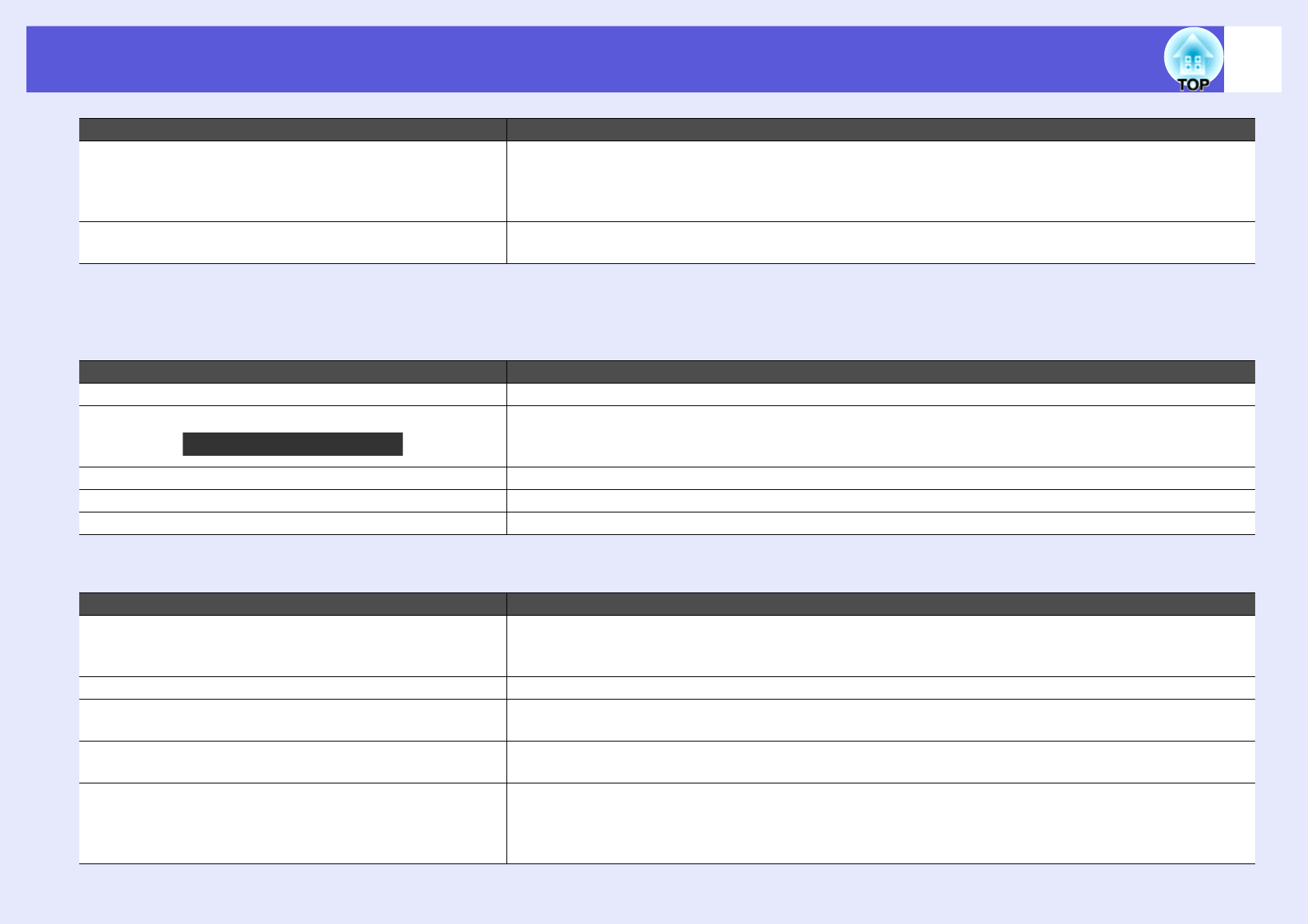
Problem Solving 50
fOther problems
fNo sound can be heard or the sound is faint
fThe remote control does not work
Do the indicators turn on and off when the power cable is
touched?
There is probably a poor contact in the power cable, or the power cable may be defective. Reinsert the power
cable. If this does not solve the problem, stop using the projector, disconnect the power cable from the
electrical outlet, and contact your local dealer or the nearest address provided in the World-Wide Warranty
Terms . sInquiries
Is the operation lock set to "Full Lock"? Press and hold down the [Enter] button on the control panel for about seven seconds, a message is displayed
and the lock is released. sp.29
Check Remedy
Is the audio source connected correctly? Check that the cable is connected to the Audio port.
Is "External" output set? When using EMP-1715/1705, and "EasyMP Audio Out" is set in "External" from the configuration menu,
audio is not output from the projector's built-in speaker. Change the setting to "Internal". s"Settings"-
"EasyMP Audio Out" p.34
Is the volume adjusted to the minimum setting? Adjust the volume so that sound can be heard. sQuick Start Guide
Is A/V Mute active? Press the [A/V Mute] button on the remote control to cancel A/V Mute. sp.16
Is the audio cable's specification "No resistance"? When using a commercially available audio cable, make sure it is labeled "No resistance".
Check Remedy
Is the remote control light-emitting area pointing towards the
remote receiver on the projector when it is operated?
Point the remote control towards the remote receiver.
The operating angle for the remote control is about 30° horizontally, and about 15° vertically. sQuick Start
Guide
Is the remote control too far from the projector? The operating range for the remote control is about 6 m.
Is direct sunlight or strong light from fluorescent lamps
shining onto the remote receiver?
Set the projector up in a location where strong light does not shine onto the remote receiver.
Are the batteries dead or have the batteries been inserted
correctly?
Make sure the batteries are inserted correctly or replace the batteries with new ones if necessary. sp.55
Was a remote control button pressed for more than 30
seconds?
If any of the buttons on the remote control are pressed down for more than 30 seconds, the remote control
stops sending signals (remote control's sleep mode). This feature is to prevent the batteries running down if
the remote control buttons are held down accidentally such as when it is stored in a bag or if an object is
placed on top of it. When the button is released, normal remote control operation resumes.
Check Remedy
EMP-1715/1705 only
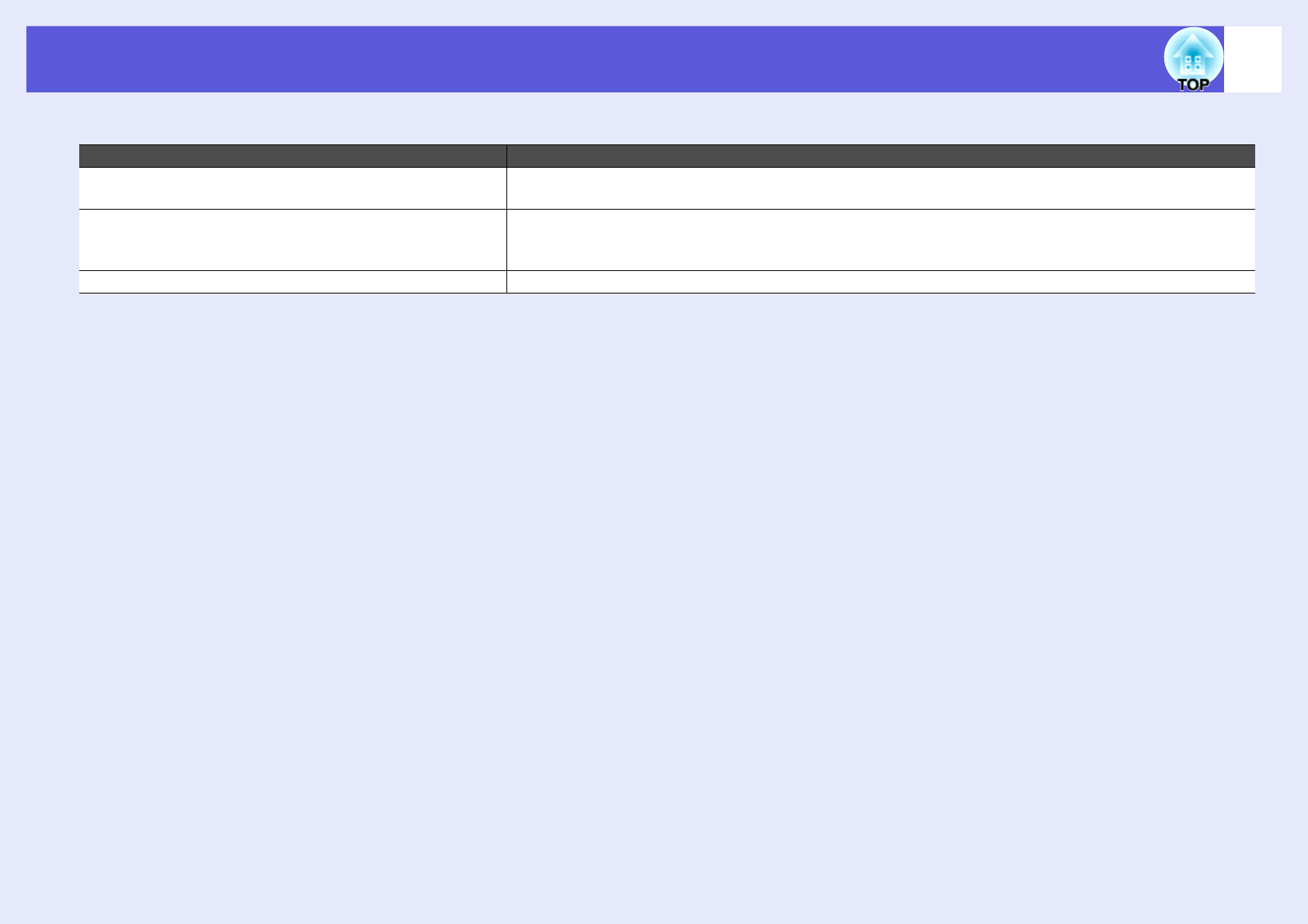
Problem Solving 51
fMail is not received even if an abnormality occurs in the projector (EMP-1715/1705 only)
Check Remedy
Is "Standby Mode" set to "Network On"? To use the mail notification function when the projector is in standby, set "Network On" in "Standby Mode"
from the configuration menu. s"Extended"-"Standby Mode" p.36
Did a fatal abnormality occur and the projector come to a
sudden stop?
When the projector comes to a sudden stop, mail cannot be sent.
If the abnormal state continues, contact your local dealer or the nearest address provided in the World-Wide
Warranty Terms. sInquiries
Is power being supplied to the projector? Check that your electrical outlet or power source is functioning correctly.

Appendices
This chapter provides information on maintenance procedures to ensure the best level of performance from the
projector for a long time to come.
Installation Methods ........................................... 53
Cleaning............................................................... 54
• Cleaning the Projector's Surface .....................................54
• Cleaning the Lens..............................................................54
• Cleaning the Air Filter and Air Intake Vent ..................54
Replacing Consumables .................................... 55
• Replacing the Remote Control Batteries ........................55
• Replacing the Lamp ..........................................................56
Lamp replacement period...............................................................56
How to replace the lamp.................................................................56
Resetting the lamp operating time..................................................58
• Replacing the Air Filter....................................................59
Air filter replacement period ..........................................................59
How to replace the air filter............................................................59
Saving a User’s Logo ......................................... 60
Screen Size and Distance .................................. 62
Connecting to External Equipment................... 63
• Connecting to External Speakers ....................................63
Optional Accessories and Consumables .........64
Optional accessories....................................................................... 64
Consumables .................................................................................. 64
Glossary...............................................................65
List of ESC/VP21 Commands.............................67
• Command List .................................................................. 67
• Cable Layouts ................................................................... 67
USB connection ............................................................................. 67
• USB Connection Setup..................................................... 68
PJLink (EMP-1715/1705 only).............................69
List of Supported Monitor Displays ..................70
Computer image............................................................................. 70
Component video ........................................................................... 70
Composite video/S-video............................................................... 70
Specifications......................................................71
Appearance..........................................................74
Index.....................................................................75

53
Installation Methods
The projector supports the following four different projection methods.
Attention
• A special method of installation is required when suspending the
projector from a ceiling (ceiling mount). If it is not installed
correctly, it could fall causing an accident and injury.
• If you use adhesives on the ceiling mount to prevent the screws
from loosening, or if you use things such as lubricants or oils on
the projector, the projector case may crack causing it to fall from
its ceiling mount. This could cause serious injury to anyone under
the ceiling mount and could damage the projector.
When installing or adjusting the ceiling mount, do not use
adhesives to prevent the screws from loosening and do not use oils
or lubricants and so on.
• Do not use the projector on its side. This may cause malfunctions
to occur.
• Project images from in front
of the screen. (Front
projection)
• Project images from behind a
translucent screen. (Rear
projection)
• Suspend the projector from
the ceiling and project images
from in front of the screen.
(Front/Ceiling projection)
• Suspend the projector from
the ceiling and project images
from behind a translucent
screen. (Rear/Ceiling
projection)
q• An optional ceiling mount is required when suspending
the projector from a ceiling.
s
p.64
• You can change the setting as follows by pressing down the
[A/V Mute] button on the remote control for about five
seconds.
"Front"
W
"Front/Ceiling"
"Rear"
W
"Rear/Ceiling"
s
p.35
• When set to "Front/Ceiling" or "Rear/Ceiling", you
cannot disconnect the power cable immediately because
cool down is performed after the power is turned off.
s
p.35
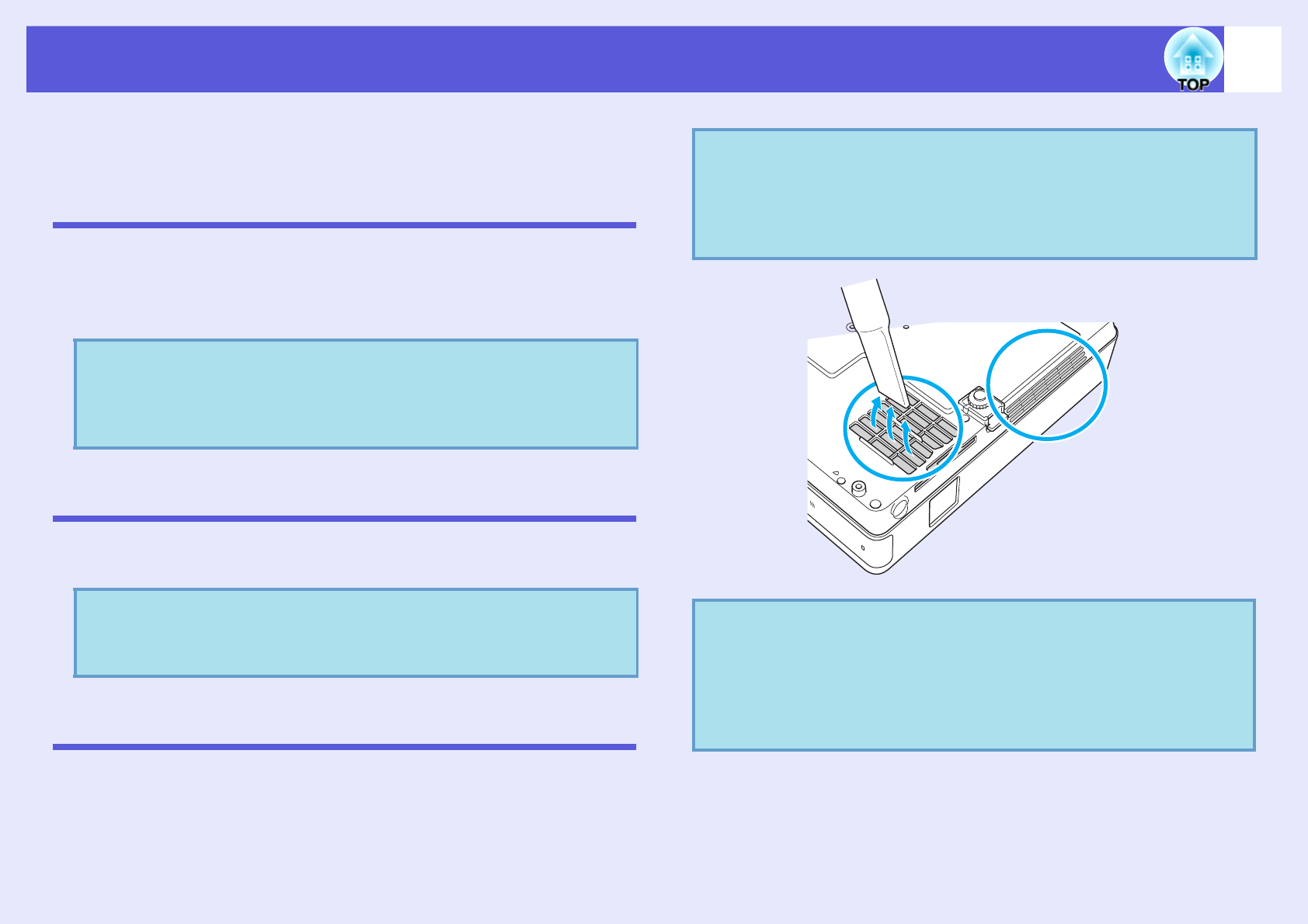
54
Cleaning
You should clean the projector if it becomes dirty or if the quality of
projected images starts to deteriorate.
Cleaning the Projector's Surface
Clean the projector's surface by wiping it gently with a soft cloth.
If the projector is particularly dirty, moisten the cloth with water
containing a small amount of neutral detergent, and then firmly wring the
cloth dry before using it to wipe the projector's surface.
Cleaning the Lens
Use a commercially available cloth for cleaning classes to gently wipe the
lens.
Cleaning the Air Filter and Air Intake Vent
Clean the air filter and the air intake vent when the following message is
displayed.
"The projector is overheating. Make sure nothing is blocking the air vent,
and clean or replace the air filter." s"How to replace the air filter" p.59
Attention
Do not use volatile substances such as wax, alcohol, or thinner to
clean the projector's surface. The quality of the case may change or
become discoloured.
Attention
Do not rub the lens with harsh materials or subject the lens to
shocks, as it can easily become damaged.
Attention
If dust collects on the air filter it can cause the internal temperature
of the projector to rise, and this can lead to problems with operation
and shorten the optical engine's service life. Clean the air filter
immediately when the message is displayed.
q• If a message is frequently displayed, even after cleaning, it
is time to replace the air filter. Replace it with a new air
filter.
s
p.59
• It is recommended that you clean these parts at least once
every three months. Clean them more often than this if
using the projector in a particularly dusty environment.
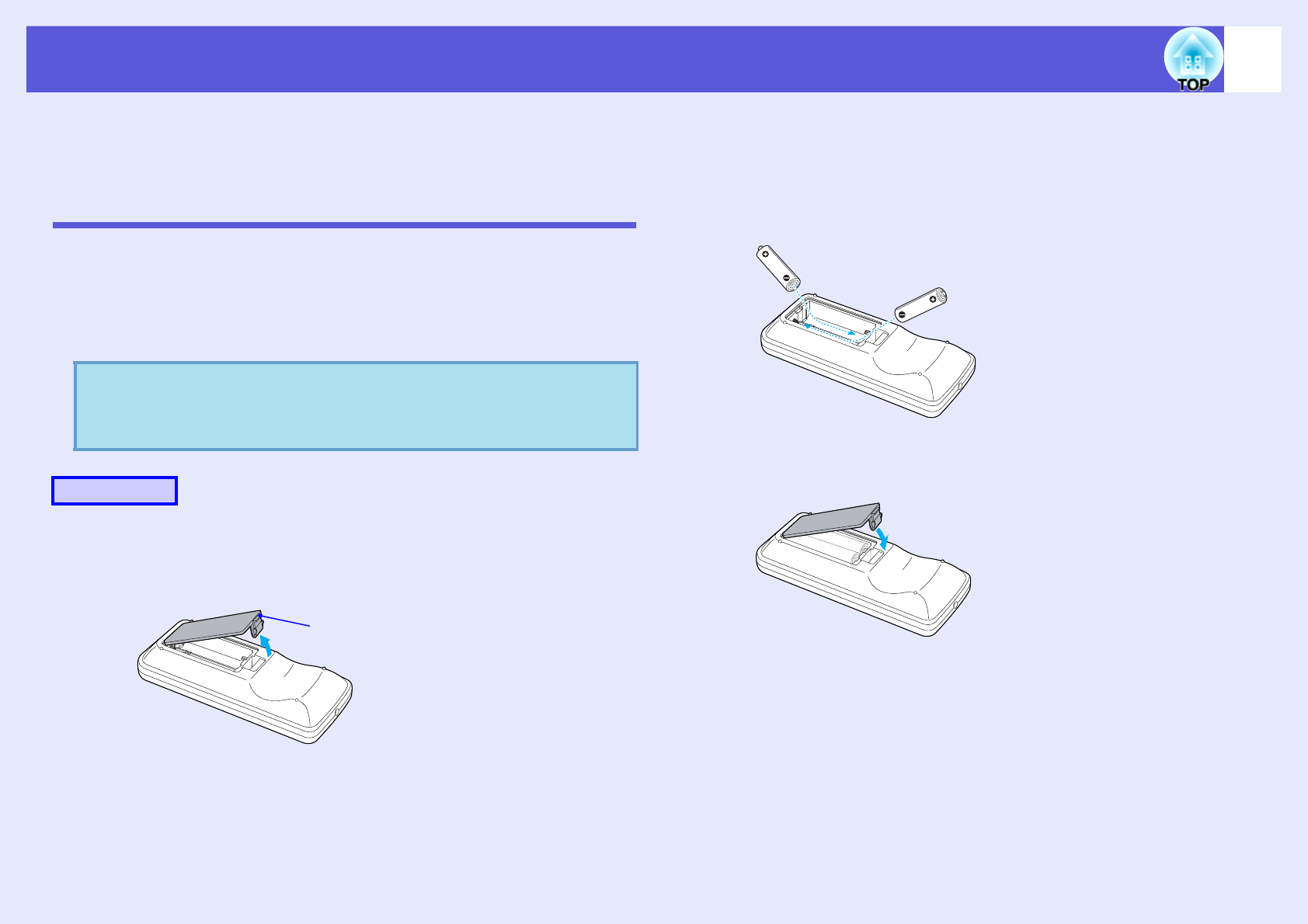
55
Replacing Consumables
This section explains how to replace the remote control batteries, the
lamp, and the air filter.
Replacing the Remote Control Batteries
If delays in the responsiveness of the remote control occur or if it does not
operate after it has been used for some time, it probably means that the
batteries are becoming flat. When this happens, replace them with new
batteries. Have two spare AAA-size alkali batteries ready to use when
required.
ARemove the battery cover.
While pushing the battery compartment cover catch, lift the cover
up.
BReplace the old batteries with new batteries.
Attention
Check the positions of the (+) and (-) marks inside the battery
holder to ensure the batteries are inserted the correct way.
CReplace the battery cover.
Press the battery compartment cover until it clicks into place.
Attention
Make sure you read the Safety Instructions/World-Wide Warranty
Terms before handling the batteries.
s
Safety Instructions
Procedure
Catch
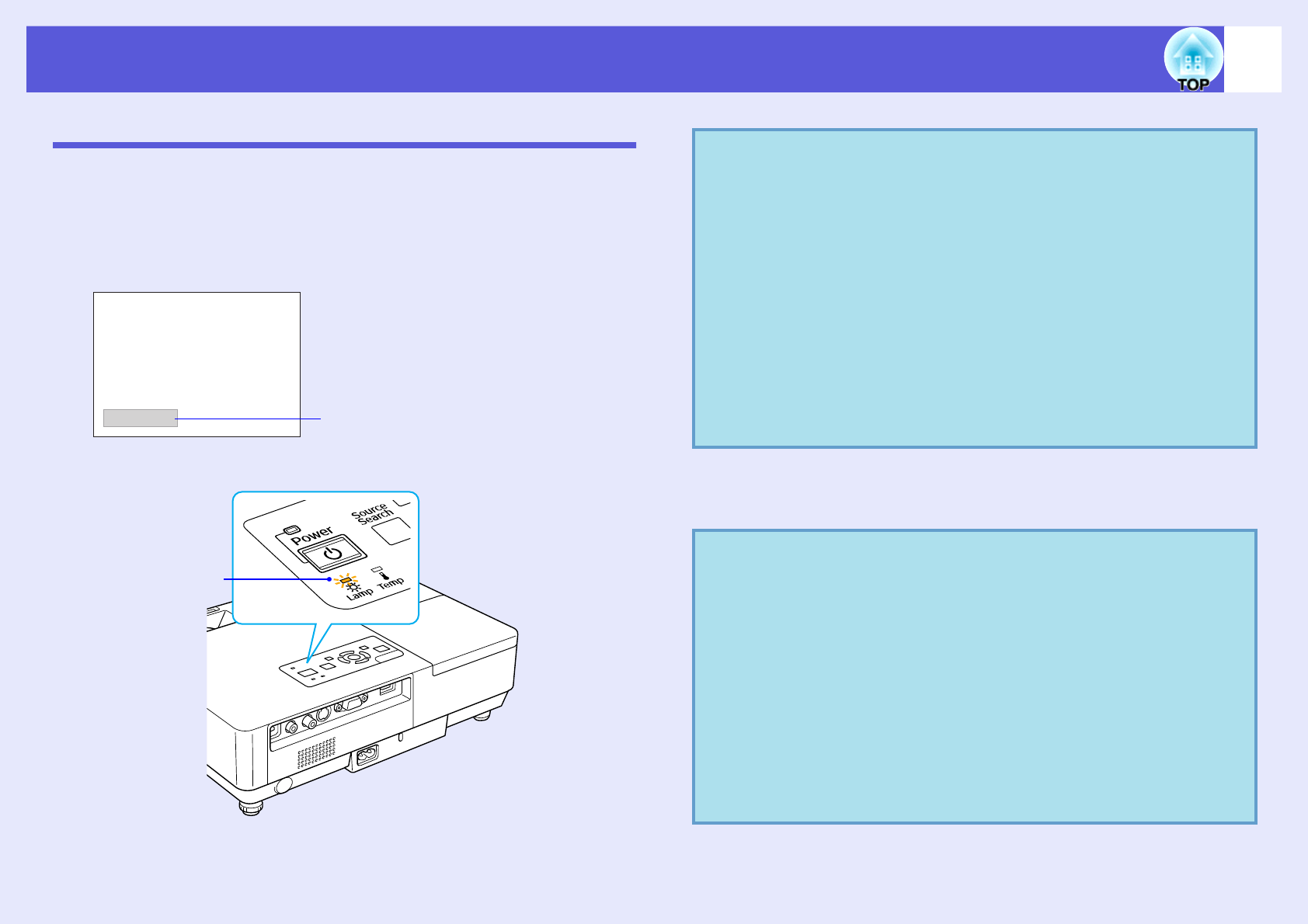
Replacing Consumables 56
Replacing the Lamp
fLamp replacement period
It is time to replace the lamp when:
• The message "Replace the lamp." is displayed when you start
projecting.
• The lamp indicator flashes orange.
• The projected image gets darker or starts to deteriorate.
fHow to replace the lamp
A message is displayed.
Flashing orange
Attention
• The lamp replacement message is set to appear after the following
time periods in order to maintain the initial brightness and quality
of the projected images.
s
"Brightness Control" p.34
·When used continually at high brightness: About 1900 hours
·When used continually at low brightness: About 2900 hours
• If you continue to use the lamp after the replacement period has
passed, the possibility that the lamp may explode increases. When
the lamp replacement message appears, replace the lamp with a
new one as soon as possible, even if it is still working.
• Depending on the characteristics of the lamp and the way it has
been used, the lamp may become darker or stop working before
the lamp warning message appears. You should always have a
spare lamp ready incase it is needed.
Attention
• When replacing the lamp because it has stopped illuminating,
there is a possibility that the lamp may be broken.
If replacing the lamp of a projector which has been installed on
the ceiling, you should always assume that the lamp is broken,
and you should stand to the side of the lamp cover, not underneath
it. Remove the lamp cover gently. Small pieces of glass may fall
out when the lamp cover is opened. If pieces of glass get into your
eyes or mouth, seek medical advice immediately.
• Wait until the lamp has cooled down sufficiently before removing
the lamp cover. If the lamp is still hot, burns or other injuries may
result. It takes about one hour after the power has been turned off
for the lamp to be cool enough.
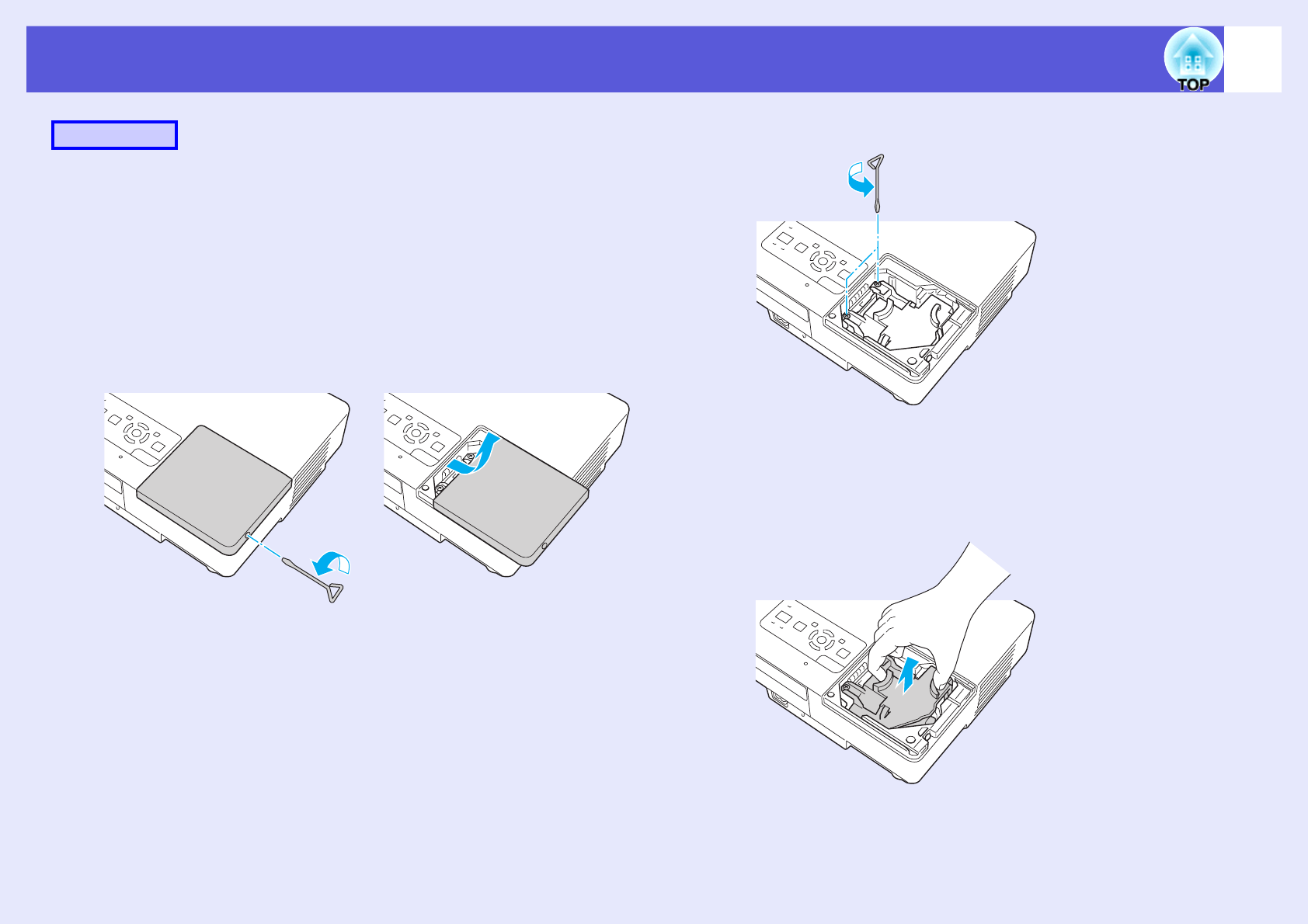
Replacing Consumables 57
AAfter you turn off the projector's power and the
confirmation buzzer beeps twice, disconnect the
power cable.
BWait until the lamp has cooled down, then remove
the lamp cover.
Loosen the lamp cover fixing screw with the screwdriver supplied
with the new lamp or a + head screwdriver. Then slide the lamp
cover straight forward and lift it to remove.
CLoosen the two lamp fixing screws.
DTake out the old lamp.
If the lamp is cracked, replace it with a new lamp, or contact your
local dealer for further advice. If replacing the lamp yourself, be
careful to avoid pieces of broken glass.
Procedure
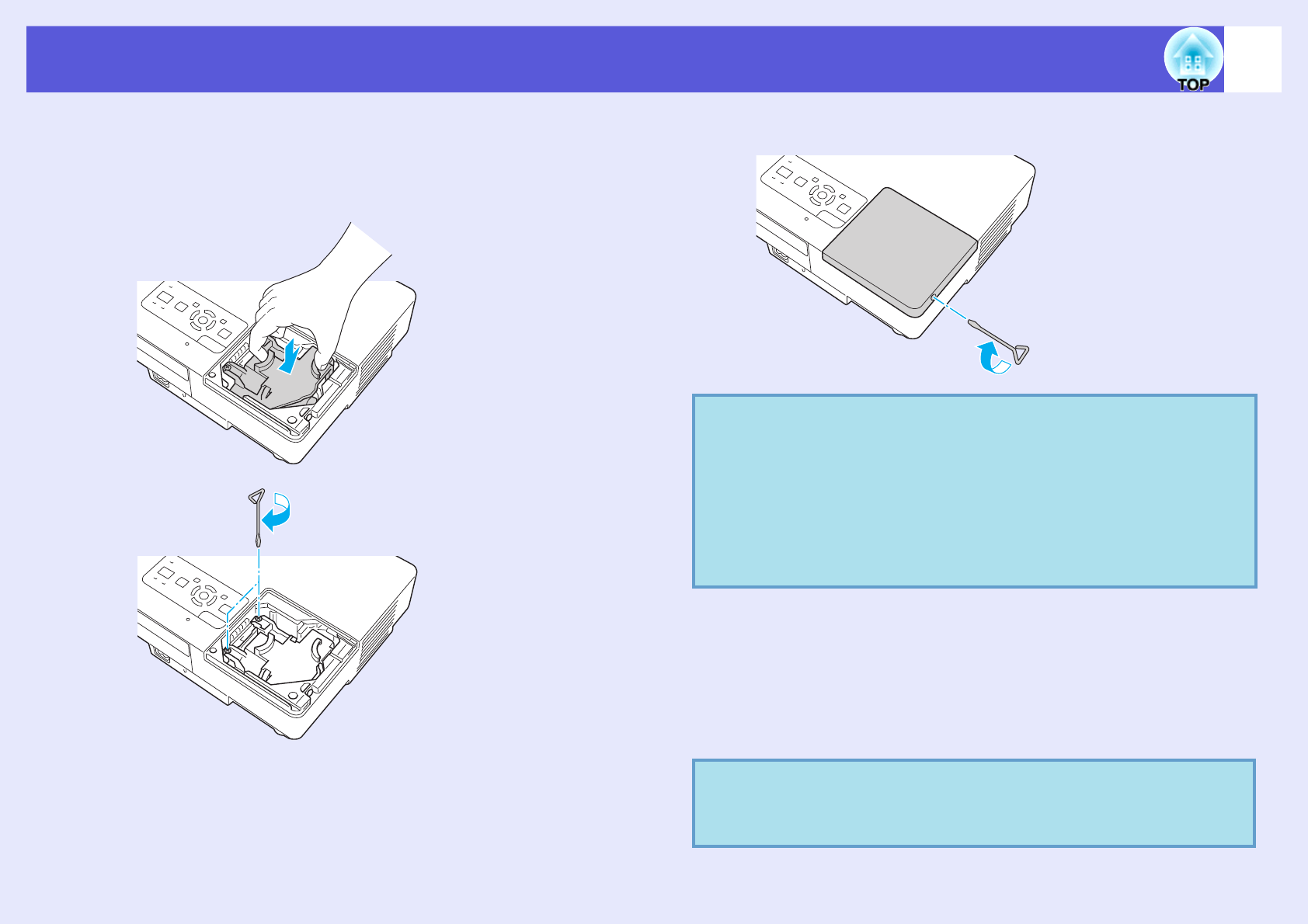
Replacing Consumables 58
EInstall the new lamp.
Insert the new lamp along the guide rail in the correct direction so
that it fits in place and push down on the area marked "PUSH",
once it is fully inserted tighten the two screws.
FReplace the lamp cover.
fResetting the lamp operating time
The projector records how long the lamp is turned on and a message and
indicator notify you when it is time to replace the lamp. After replacing
the lamp, make sure you reset the lamp hours from the configuration
menu. sp.39
Attention
• Make sure you install the lamp securely. If the lamp cover is
removed, the lamp turns off automatically as a safety precaution.
If the lamp or the lamp cover is not installed correctly, the lamp
does not turn on.
• This product includes a lamp component that contains mercury
(Hg). Please consult your local regulations regarding disposal or
recycling. Do not dispose of it with normal waste.
qOnly reset the lamp operating time after the lamp has been
replaced, otherwise the lamp replacement period is not
indicated correctly.
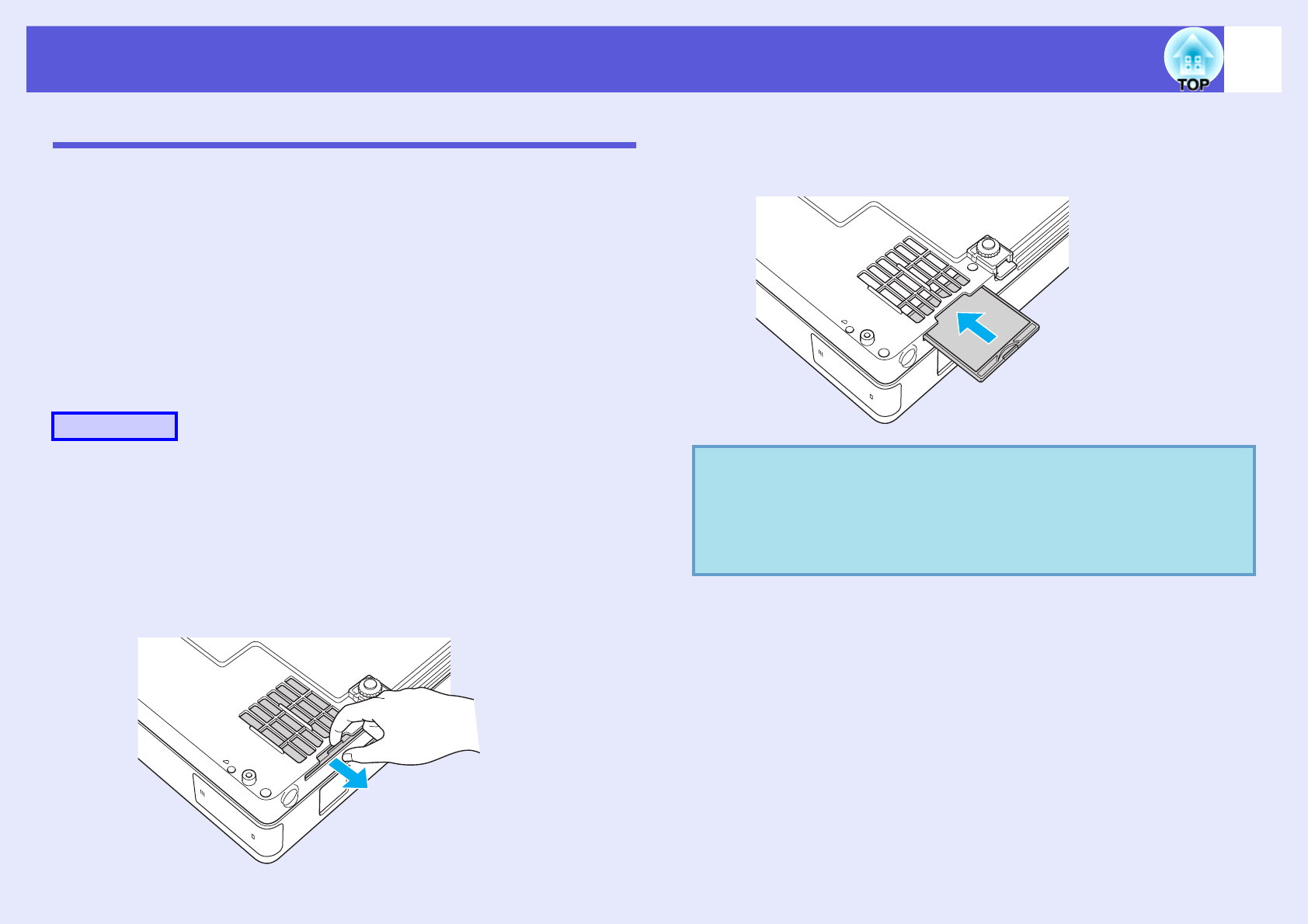
Replacing Consumables 59
Replacing the Air Filter
fAir filter replacement period
It is time to replace the air filter when:
• The air filter is ripped.
• When the message "The projector is overheating. Make sure
nothing is blocking the air vent, and clean or replace the air filter."
is displayed even though the air filter has been cleaned.
fHow to replace the air filter
The air filter can be replaced even when the projector is suspended from a
ceiling.
AAfter you turn off the projector's power and the
confirmation buzzer beeps twice, disconnect the
power cable.
BRemove the air filter.
Put your finger into the recess of the air filter and slide it forward to
remove it.
CInstall the new air filter.
Slide the air filter in from the outside and push until it clicks into
place.
Procedure
qDispose of used air filters properly in accordance with your
local regulations.
Material quality of the frame section: Polycarbonate, ABS
resin
Material quality of the filter section: Polyurethane form
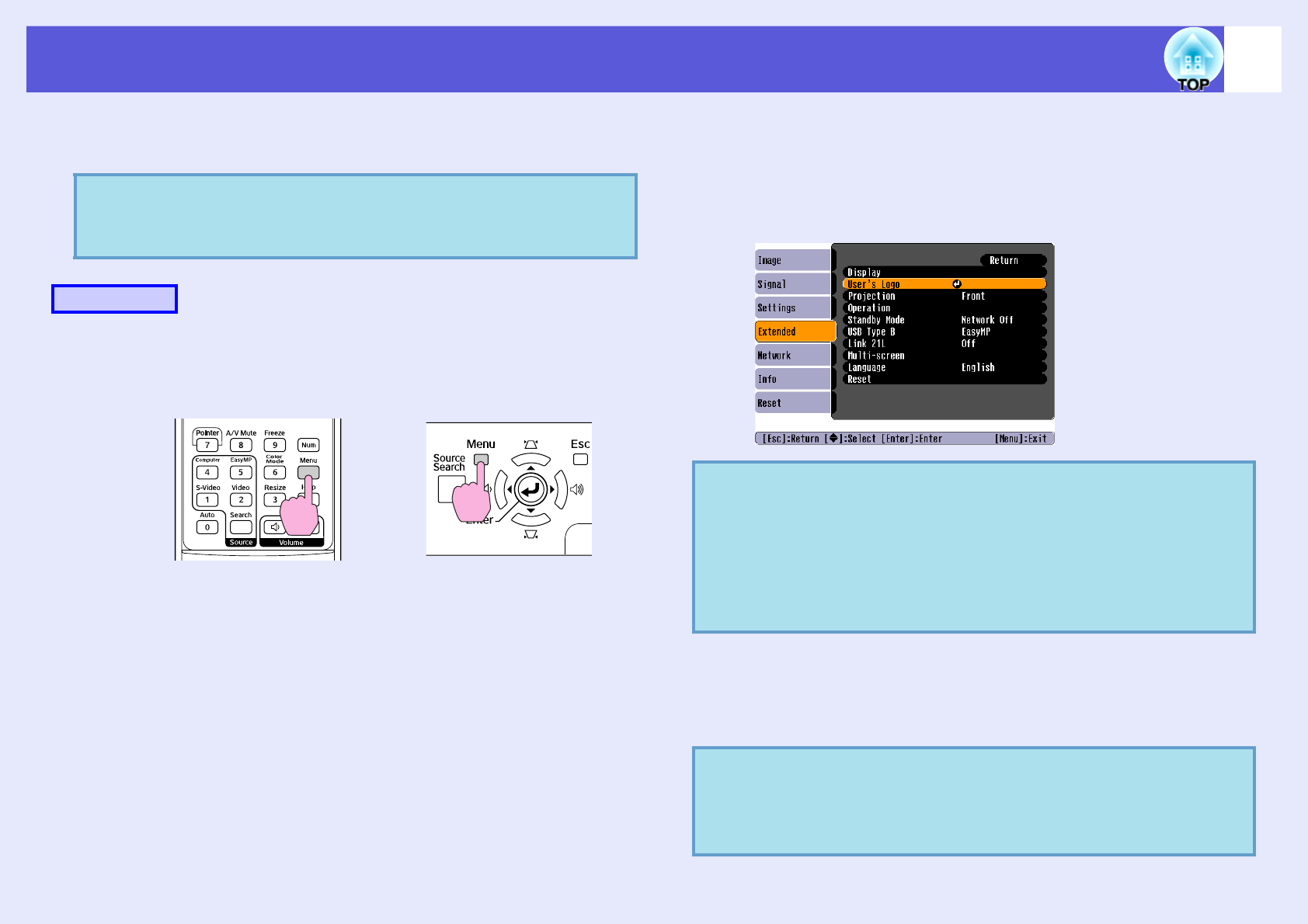
60
Saving a User’s Logo
You can save the image that is currently being projected as a user's
logo.
AProject the image you want to use as the user's
logo, and then press the [Menu] button.
BFrom the configuration menu, select "Extended" -
"User's Logo". s"Using the Configuration Menu"
p.31
Check the buttons you can use and the operations they perform in
the guide under the menu.
CWhen "Choose this image as the User's Logo?" is
displayed, select "Yes".
qWhen a user's logo is saved, the previous user's logo is
erased.
Procedure
Using the remote control Using the control panel
q• If "User's Logo Protect" from "Password Protect" is set
to "On", a message is displayed and the user's logo
cannot be changed. You can make changes after setting
"User's Logo Protect" to "Off".
s
p.27
• If "User's Logo" is selected when Keystone, E-Zoom,
Resize, or Progressive are being performed, the function
currently being performed is cancelled.
qWhen you press the [Enter] button on the remote control or
the control panel, the screen size may change according to
the signal as it changes to the resolution of the image
signal.
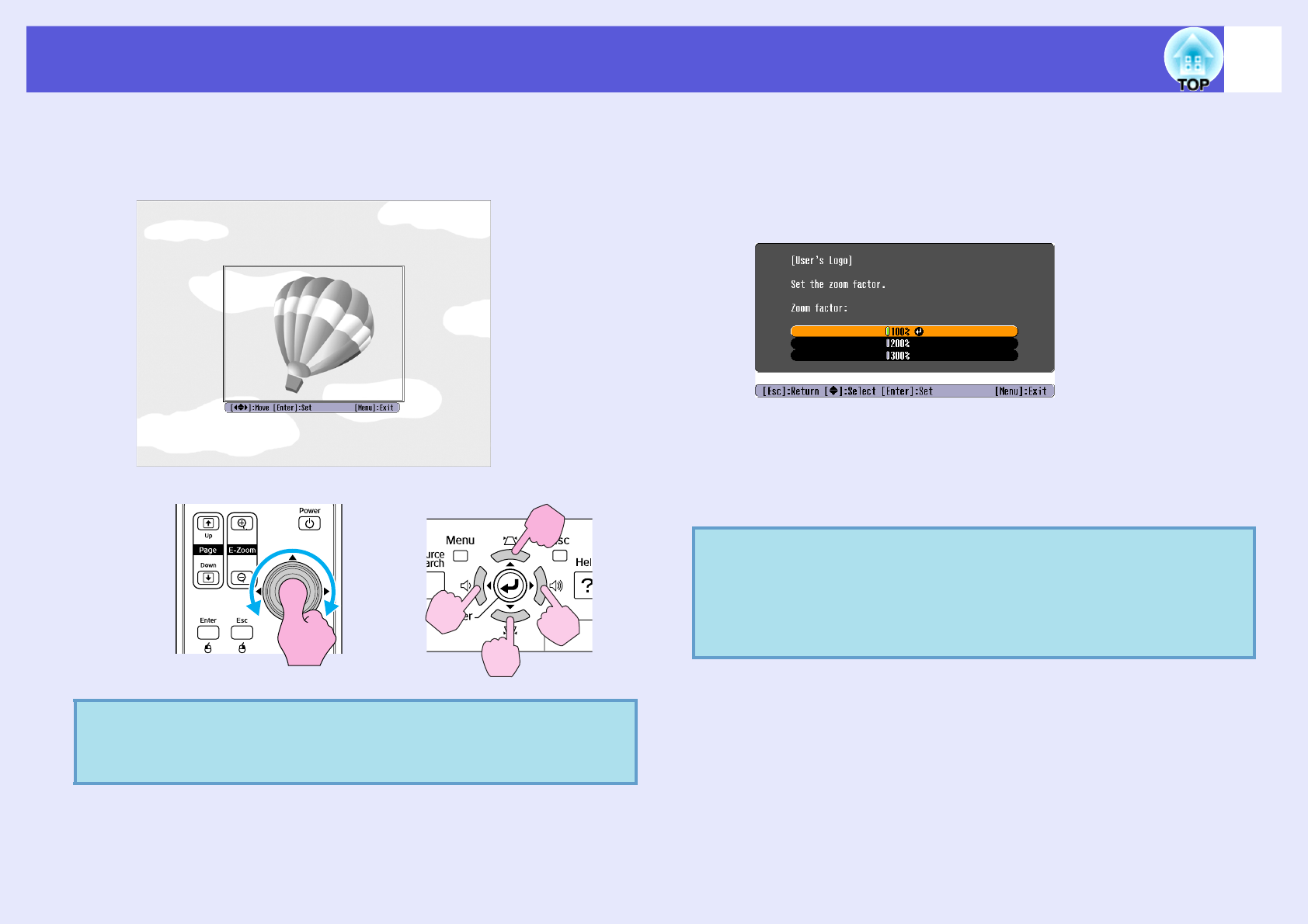
Saving a User’s Logo 61
DThe image is recorded and a selection marquee box
is displayed. Move the box to select the part of the
image to use as the user's logo.
EWhen "Select this image?" is displayed, select
"Yes".
FSelect the zoom factor from the zoom setting
screen.
GWhen the message "Save this image as the User's
Logo?" is displayed, select "Yes".
The image is saved. After the image has been saved, the message
"Completed." is displayed.
qYou can save at up to 400
^
300 dots in size.
Using the remote control Using the control panel
q• Saving the user's logo may take about 15 seconds. Do not
use the projector or any connected equipment while it is
saving, otherwise malfunctions may occur.
• Once a user's logo has been saved, the logo cannot be
returned to the factory default.
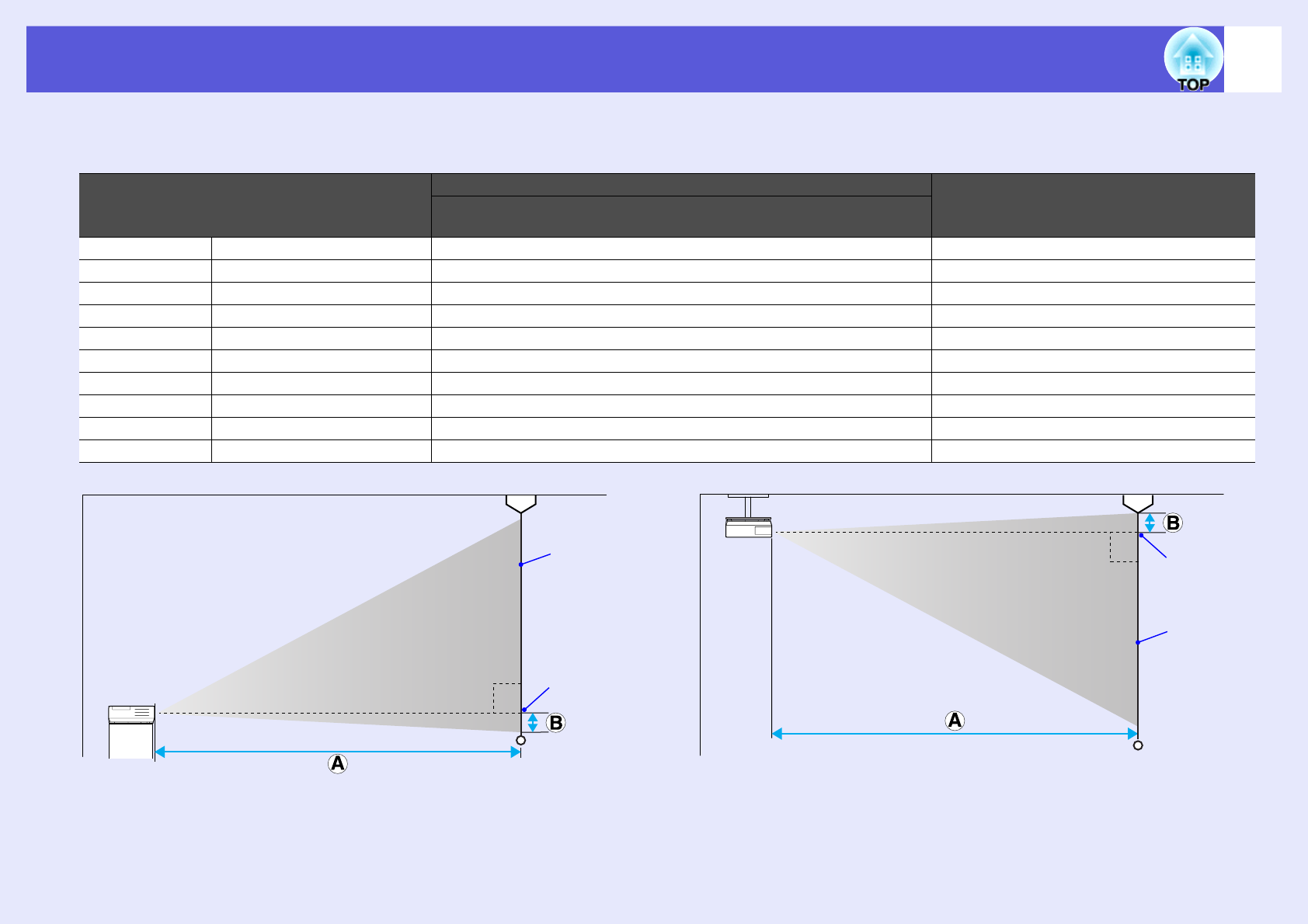
62
Screen Size and Distance
See the following table to choose the best position for your projector. The values are only a guide.
Units: cm (in.) Units: cm (ft) Units: cm (in.)
4:3 Screen Size
Projection Distance UDistance from the Centre of the Lens
to the Base of the Screen V
Minimum Maximum
(Zoom Adjustment Wide) to (Zoom Adjustment Tele)
30" 61 ^ 46 (24.0 ^ 18.1) 99 to 119 (3.2 to 3.9) 7 (2.6)
40" 81 ^ 61 (31.9 ^ 24.0) 133 to 160 (4.4 to 5.2) 9 (3.4)
50" 100 ^ 76 (39.4 ^ 30.0) 166 to 200 (5.5 to 6.6) 11 (4.3)
60" 120 ^ 90 (47.2 ^ 35.4) 200 to 240 (6.6 to 7.9) 13 (5.1)
80" 160 ^ 120 (63.0 ^ 47.2) 267 to 321 (8.8 to 10.5) 17 (6.9)
100" 200 ^ 150 (78.7 ^ 59.1) 335 to 402 (11.0 to 13.2) 22 (8.6)
120" 240 ^ 180 (94.4 ^ 70.8) 402 to 483 (13.2 to 15.9) 26 (10.3)
150" 300 ^ 230 (118.1 ^ 90.6) 503 to 605 (16.5 to 19.8) 33 (12.9)
200" 410 ^ 300 (161.4 ^ 118.1) 672 to 807 (22.0 to 26.5) 44 (17.1)
300" 610 ^ 460 (240.2 ^ 181.1) 1009 to 1211 (33.1 to 39.7) 65 (25.7)
Screen
Centre of
lens
90°
90° Centre of
lens
Screen
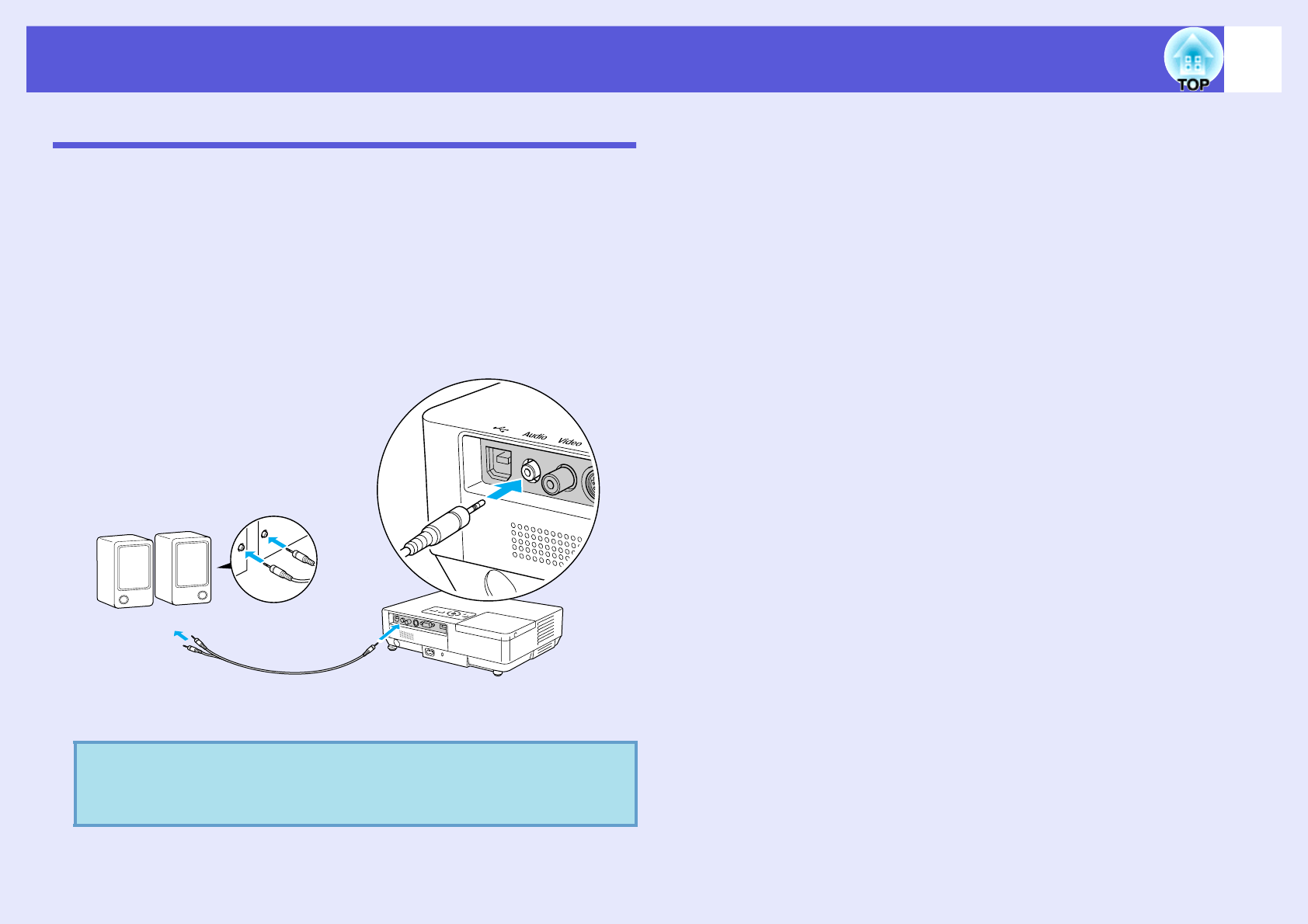
63
Connecting to External Equipment
Connecting to External Speakers
You can output the audio for images being projected with the PC Free of
EasyMP to external speakers.
When "External" is set as the "EasyMP Audio Out" setting from the
configuration menu, and the projector's audio in port is joined with an
external amplifier's built-in speaker, you can enjoy a richer, more
powerful sound.
Connect with a commercially available audio cable (pin plug W 3.5 mm
stereo mini plug and so on). Use an audio cable compatible with the
connector on the external speakers.
qWhen projecting images using an EasyMP LAN
connection, audio cannot be output from the projector.
To external speakers
To Audio in port
Audio cable
(commercially available)
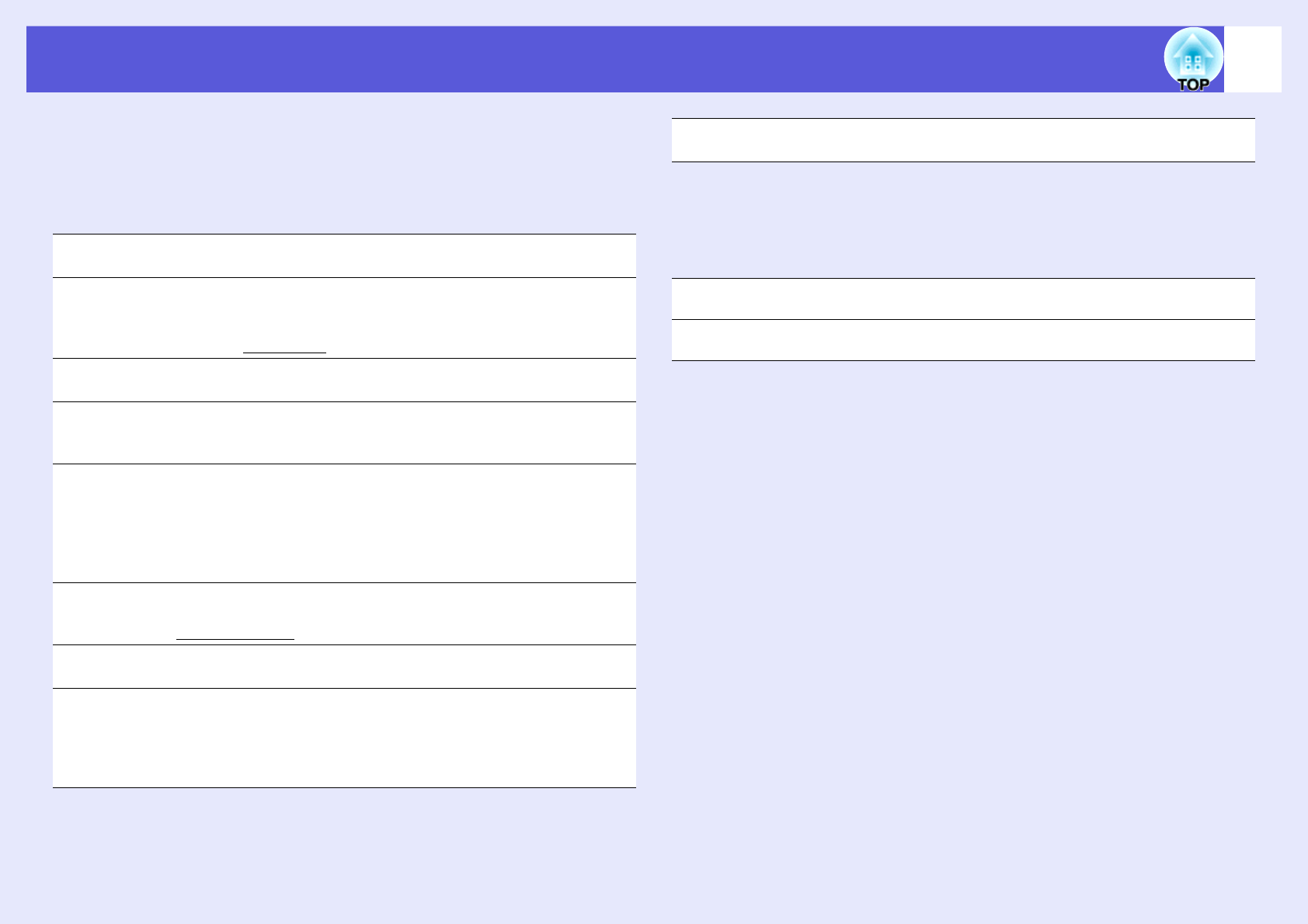
64
Optional Accessories and Consumables
The following list of optional accessories is current as of July, 2006.
Details of accessories are subject to change without notice and
availability may vary depending on the country of purchase.
fOptional accessories
* A special method of installation is required to suspend the projector from a
ceiling. Contact your dealer or the nearest address provided in the World-Wide
Warranty Terms if you want to use this installation method. sInquiries
fConsumables
Soft carrying case ELPKS16B
Use this case if you need to travel with the projector.
60" portable screen ELPSC07
80" portable screen ELPSC08
100" screen ELPSC10
Portable roll-type screens (Aspect ratiog 4:3)
50" portable screen ELPSC06
A compact screen that can be carried easily. (Aspect ratio 4:3)
HD-15 cable ELPKC02
(1.8 m - for mini D-Sub15-pin/mini D-Sub 15pin)
This is the same as the computer cable supplied with the projector.
HD-15 cable ELPKC09
(3 m - for mini D-Sub15-pin/mini D-Sub 15pin)
HD-15 PC cable ELPKC10
(20 m - for mini D-Sub15-pin/mini D-Sub 15pin)
Use one of these longer cables if the computer cable supplied with the projector is
too short.
Component video cable ELPKC19
(3 m - for mini D-Sub 15-pin/RCA male^3)
Use to connect a component videog source
Ethernet unit ELPAP02
Use this when connecting to a network by using a LAN cable.
Ceiling plate* ELPFC03
Ceiling pipe (370 mm (14.57 in.)/silver)* ELPFP04
Ceiling pipe (570 mm (22.44 in.)/silver)* ELPFP05
Ceiling pipe (770 mm (30.31 in.)/silver)* ELPFP06
Use when installing the projector on a high ceiling.
Ceiling mount* ELPMB18
Use when installing the projector on a ceiling.
Lamp unit ELPLP38
Use as a replacement for used lamps.
Air filter (by 2) ELPAF08
Use as a replacement for used air filters.
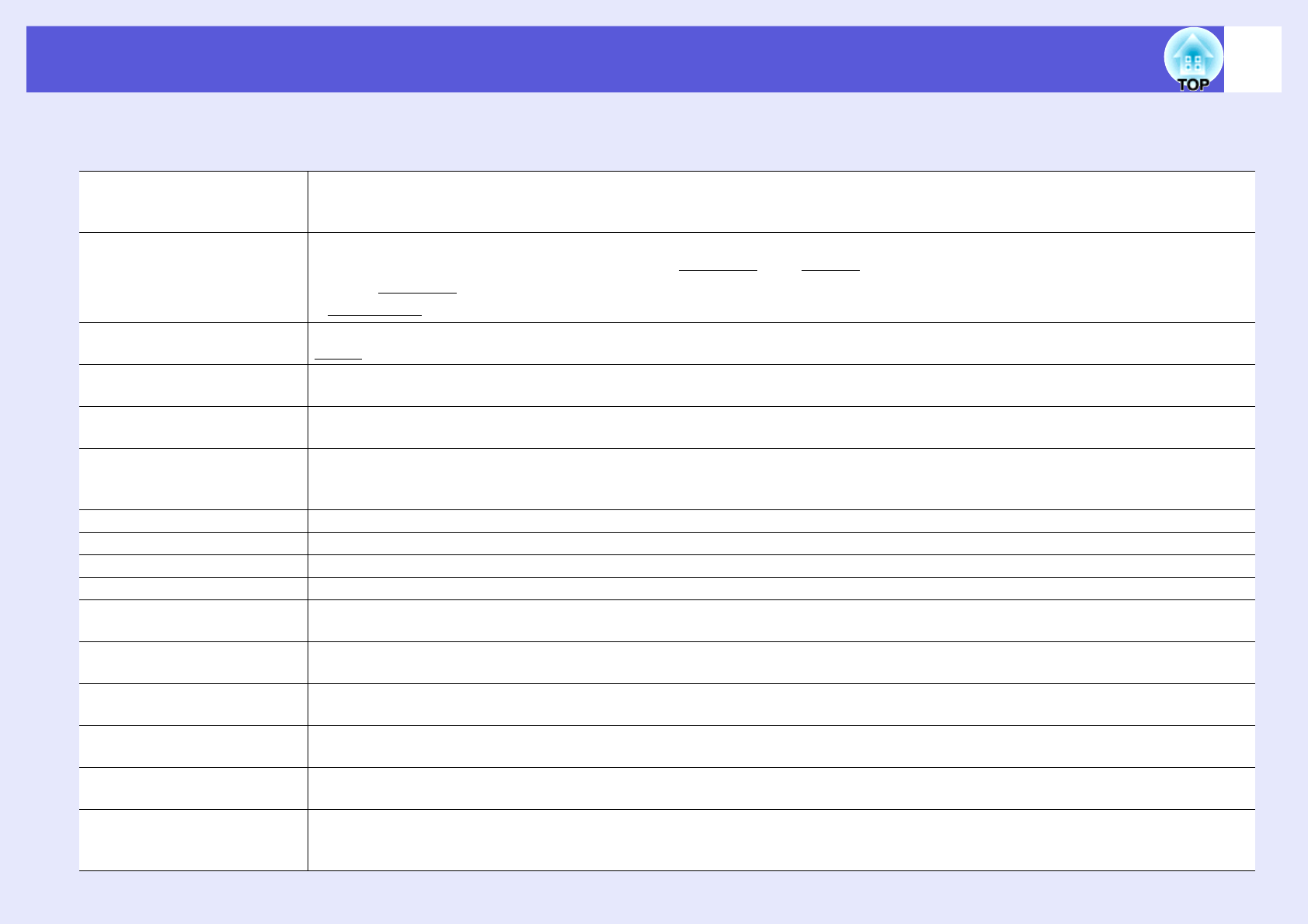
65
Glossary
This section explains easily terms that are used with the projector and difficult terms that are not explained in the text of this guide. For details,
refer to other commercially available publications.
EMP Link21L A utility software program that allows the projector to be connected to a computer so that the computer can be used to control the
projector. For details on acquiring the software and for instructions on using the software and compatible projector models, go to http://
www.epson.com and select the support section of your local Epson Web site.
HDTV An abbreviation for High-Definition Television that refers to high-definition systems which satisfy the following conditions.
• Vertical resolution of 750p or 1125i or greater (p = progressiveg, i = interlaceg)
• Screen aspect ratiog of 16:9
• Dolby Digitalg audio reception and playback (or output)
SDTV An abbreviation for Standard Definition Television that refers to standard television systems which do not satisfy the conditions for
HDTVg High-Definition Television.
SNMP An abbreviation for Simple Network Management Protocol, which is the protocol for monitoring and controlling devices such as routers
and computers connected to a TCP/IP network.
S-video A video signal which has the luminance component and colour component separated to provide better image quality.
Refers to images that consist of two independent signals: Y (luminance signal) and C (colour signal).
sRGB An international standard for colour intervals that was formulated so that colours that are reproduced by video equipment can be handled
easily by computer operating systems (OS) and the Internet. If the connected source has an sRGB mode, set both the projector and the
connected signal source to sRGB.
SVGA A type of video signal with a resolution of 800 (horizontal) ^ 600 (vertical) dots that is used by IBM PC/AT-compatible computers.
SXGA A type of video signal with a resolution of 1280 (horizontal) ^ 1024 (vertical) dots that is used by IBM PC/AT-compatible computers.
VGA A type of video signal with a resolution of 640 (horizontal) ^ 480 (vertical) dots that is used by IBM PC/AT-compatible computers.
XGA A type of video signal with a resolution of 1024 (horizontal) ^ 768 (vertical) dots that is used by IBM PC/AT-compatible computers.
Aspect ratio The ratio between an image's length and its height. HDTV images have an aspect ratio of 16:9 and appear elongated. The aspect ratio for
standard images is 4:3.
Interlace A method of image scanning whereby the image data is divided into fine horizontal lines that are displayed in sequence starting from left
to right and then from top to bottom. The even-numbered lines and odd-numbered lines are displayed alternately.
Contrast The relative brightness of the light and dark areas of an image can be increased or decreased to make text and graphics stand out more
clearly, or to make them appear softer. Adjusting this particular property of an image is called "contrast adjustment".
Component video A video signal which has the luminance component and colour component separated to provide better image quality.
Refers to images that consist of three independent signals: Y (luminance signal), Pb and Pr (colour difference signals).
Composite video Video signals that have the video brightness signals and colour signals mixed together. The type of signals commonly used by household
video equipment (NTSC, NTSC4.43, PAL, M-PAL, N-PAL, PAL60, and SECAM formats).
Squeeze mode In this mode, wide-screen images in 16:9 mode are compressed in the horizontal direction so that they are stored on the recording
medium as 4:3 images.
When these images are played back by the projector in squeeze mode, they are restored to their original 16:9 format.
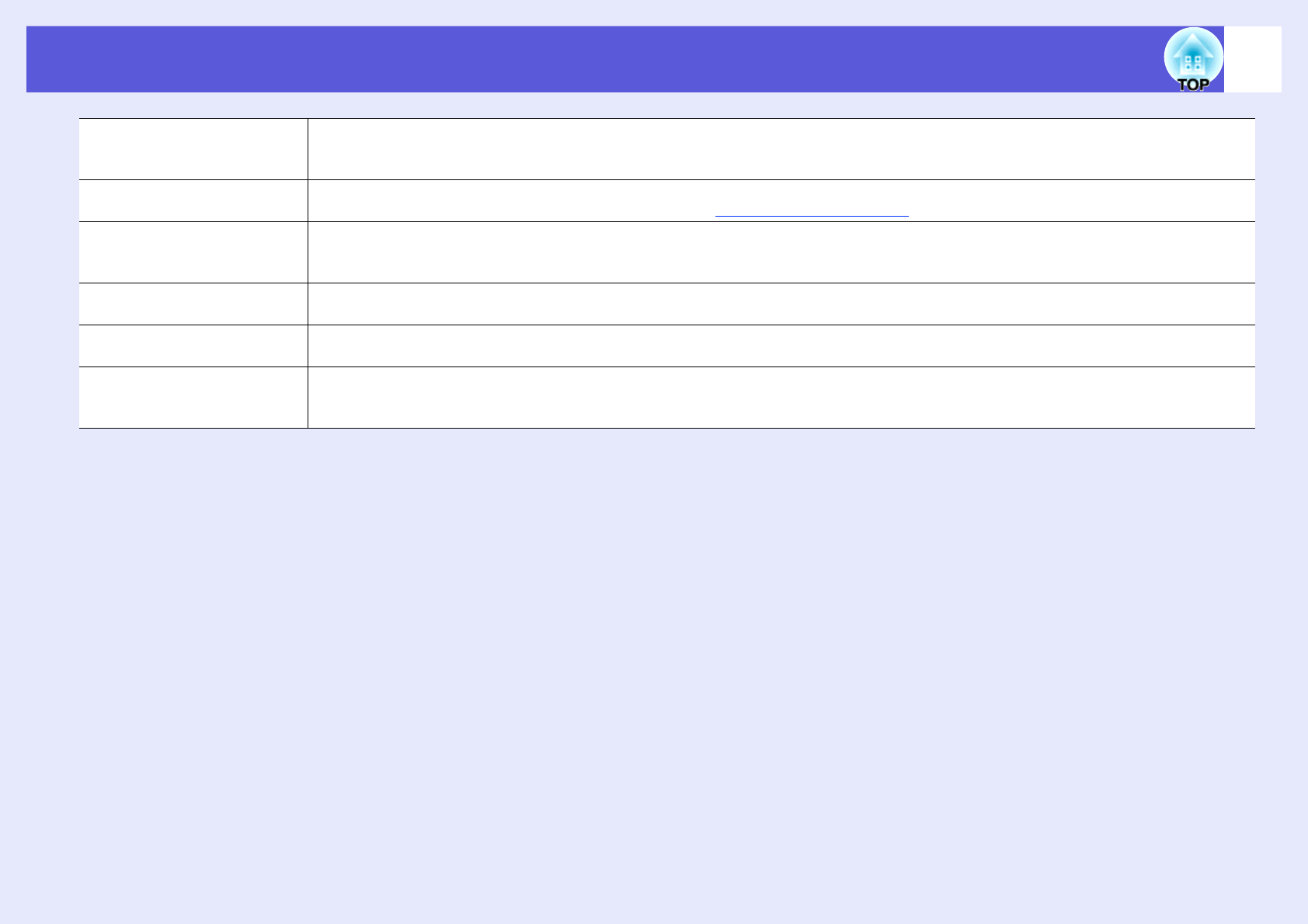
Glossary 66
Synchronization The signals output from computers have a specific frequency. If the projector frequency does not match this frequency, the resulting
images are not of a good quality. The process of matching the phases of these signals (the relative position of the crests and the troughs in
the signal) is called Synchronization. If the signals are not synchronized, flickering, blurriness, and horizontal interference occur.
Security slot The security slot is compatible with the Microsaver Security System manufactured by Kensington. You can find details about the
Microsaver Security System on the Kensington homepage http://www.kensington.com/.
Tracking The signals output from computers have a specific frequency. If the projector frequency does not match this frequency, the resulting
images are not of a good quality. The process of matching the frequency of these signals (the number of crests in the signal) is called
Tracking. If tracking is not carried out correctly, wide vertical stripes appear in the signal.
Dolby Digital A sound format developed by Dolby Laboratories. Normal stereo is a 2-channel format that uses two speakers. Dolby Digital is a 6-
channel (5.1-channel) system which adds to this a centre speaker, two rear speakers, and a sub-woofer.
Progressive A method of image scanning whereby the image data from a single image is scanned sequentially from top to bottom to create a single
image.
Refresh rate The light-emitting element of a display maintains the same luminosity and colour for an extremely short time. Because of this, the image
must be scanned many times per second to refresh the light-emitting element. The number of refresh operations per second is called the
Refresh rate and is expressed in hertz (Hz).
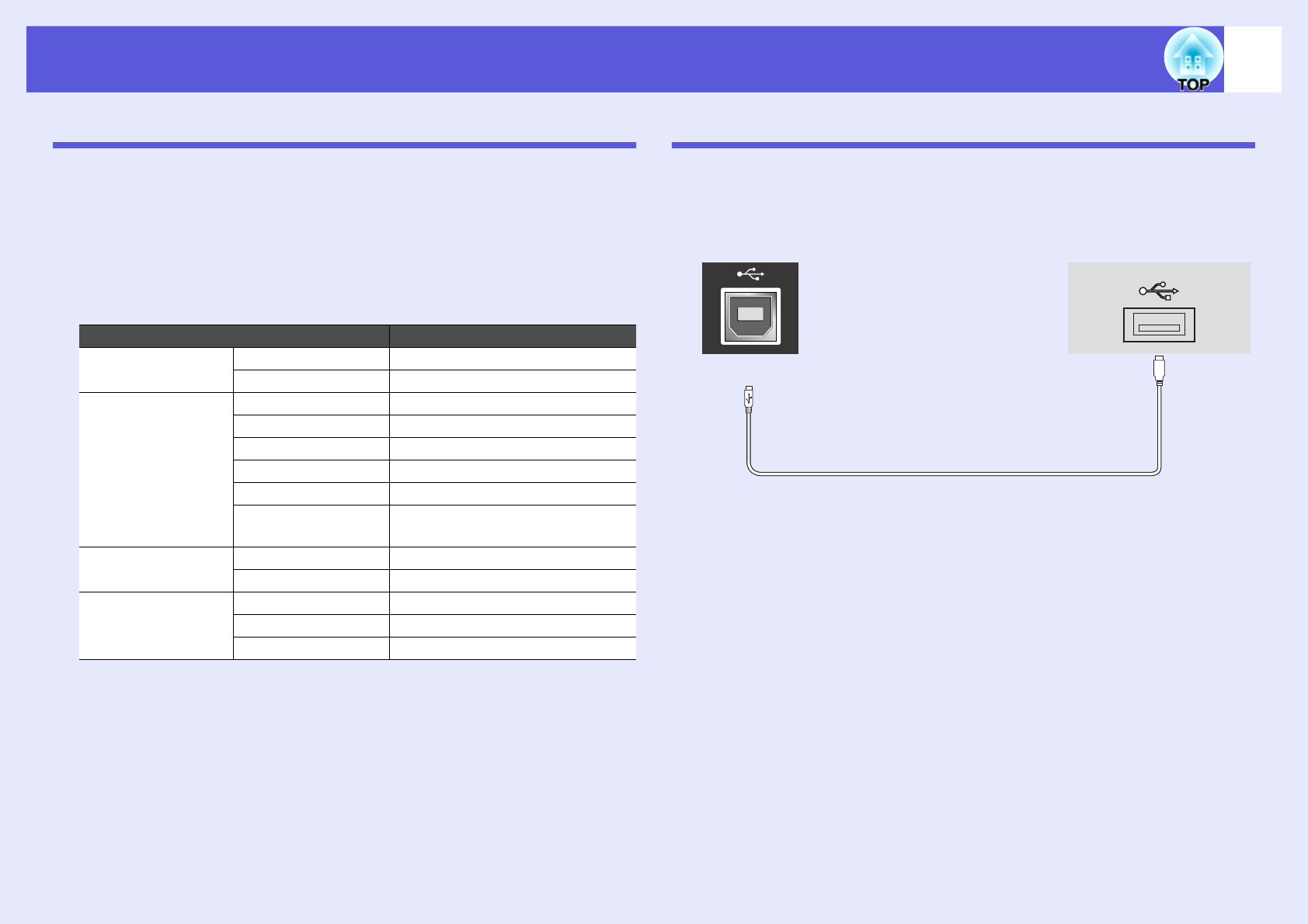
67
List of ESC/VP21 Commands
Command List
When the power ON command is transmitted to the projector, the power
turns on and it enters warm-up mode. When the projector's power has
turned on, a colon ":" (3Ah) is returned.
When a command is input, the projector executes the command and
returns a ":", and then accepts the next command.
If the command being processed terminates abnormally, an error message
is output and a ":" is returned.
* Add a Carriage Return (CR) code (0Dh) to the end of each command and
transmit.
Cable Layouts
fUSB connection
Connector shape: USB (Type B)
* You cannot use the USB Type A port (EMP-1715/1705 only) as a USB
hub.
Item Command
Power ON/OFF ON PWR ON
OFF PWR OFF
Signal selection Computer (auto) SOURCE 1F
Computer SOURCE 11
Component video SOURCE 14
Video SOURCE 41
S-video SOURCE 42
EasyMP (EMP-
1715/1705 only)
SOURCE 50
A/V Mute ON/OFF ON MUTE ON
OFF MUTE OFF
A/V Mute selection Black MSEL 00
Blue MSEL 01
Logo MSEL 02
<At the projector> <At the computer>
(Type B)

List of ESC/VP21 Commands 68
USB Connection Setup
To control the projector using ESC/VP21 commands via a USB
connection, the following preparations must be carried out.
ADownload the USB driver (USB-COM Driver) from
the Epson Web site to your computer.
Go to http://www.epson.com and select the support section of your
local Epson Web site.
BInstall the downloaded USB driver onto your
computer.
Read the instructions displayed on the download screen.
CSet "Extended" - "Link 21L" to "On" from the
projector's configuration menu.
For the EMP-1715/1705
Set "Link 21L" to "On" after setting "Extended" - "USB Type B" to
"Link 21L" from the projector's configuration menu.
Procedure

69
PJLink (EMP-1715/1705 only)
PJLink Class 1 was established by the JBMIA (Japan Business
Machine and Information System Industries Association) as a standard
protocol for controlling network-compatible projector's as part of their
efforts to standardize projector control protocols.
The projector complies with the PJLink Class 1 standard established
by the JBMIA.
It complies with all commands except for the following commands
defined by PJLink Class 1, and agreement was confirmed by the
PJLink standard adaptability verification.
Non-compatible commands
Input names defined by PJLink and corresponding projector
connectors
Manufacturer name displayed for "Manufacture name information
query"
EPSON
Model name displayed for "Product name information query"
EMP-1715/1705
Function PJLink Command
Mute settings Image muting set AV M T 1 1
Image muting cancel AV M T 1 0
Audio muting set AV M T 2 1
Audio muting cancel AV M T 2 0
Input Connector PJLink Command
Computer INPT 11
Video INPT 21
S-Video INPT 22
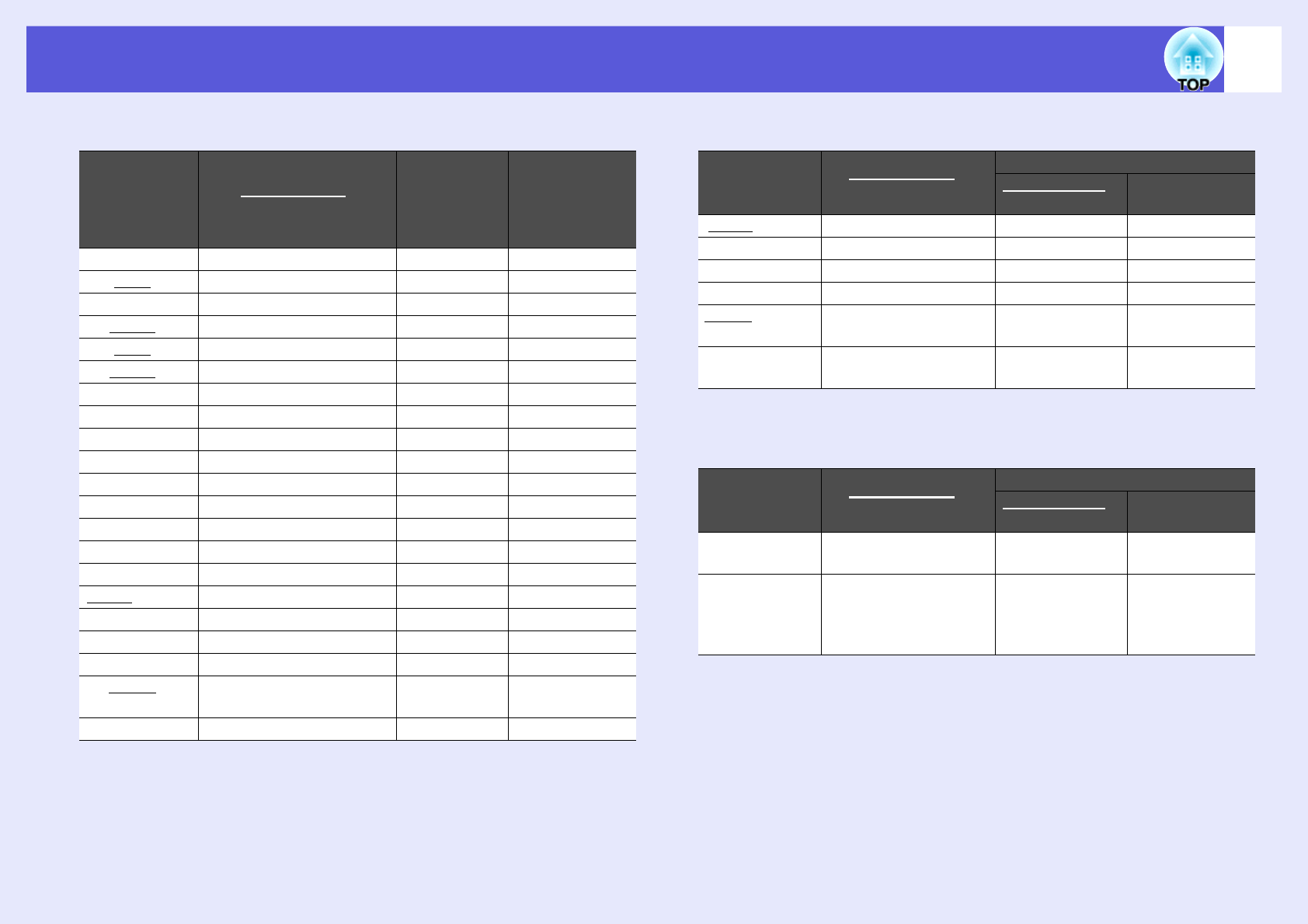
70
List of Supported Monitor Displays
fComputer image
* Connection is not possible if the equipment does not have a VGA output port.
Even when signals other than those mentioned above are input, it is likely that
the image can be projected.
However, not all functions may be supported.
fComponent video
fComposite video/S-video
Signal Refresh Rateg
(Hz)
Resolution
(dots)
Number of
Pixels Used
When Display
is Resized
(dots)
VGAEGA 640 ^ 350 1024 ^ 560
VGAg60, iMac*640 ^ 480 1024 ^ 768
VESA 72/75/85 640 ^ 480 1024 ^ 768
SVGAg56/60/72/75/85, iMac*800 ^ 600 1024 ^ 768
XGAg60/70/75/85, iMac*1024 ^ 768 1024 ^ 768
SXGAg70/75/85 1152 ^ 864 1024 ^ 768
SXGA 60/75/85 1280 ^ 960 1024 ^ 768
SXGA 60/75/85 1280 ^ 1024 960 ^ 768
SXGA+60/75/85 1400 ^ 1050 1024 ^ 768
UXGA 60 1600 ^ 1200 1024 ^ 768
MAC13" 640 ^ 480 1024 ^ 768
MAC16" 832 ^ 624 1024 ^ 768
MAC19" 1024 ^ 768 1024 ^ 768
MAC19" 60 1024 ^ 768 1024 ^ 768
MAC21" 1152 ^ 870 1016 ^ 768
SDTVg (525i) 60 720 ^ 480 1024 ^ 768
SDTV (625i) 50 720 ^ 576 1024 ^ 768
SDTV (525p) 60 720 ^ 480 1024 ^ 768
SDTV (625p) 50 720 ^ 576 1024 ^ 768
HDTVg
(750p) 50/60 1280 ^ 720 1024 ^ 576
HDTV (1125i) 50/60 1920 ^ 1080 1024 ^ 576
Signal Refresh Rateg
(Hz)
Resolutions (dots)
Aspect Ratiog
4:3
Aspect Ratio
16:9
SDTVg (525i) 60 1024 ^ 768 1024 ^ 576
SDTV (625i) 50 1024 ^ 768 1024 ^ 576
SDTV (525p) 60 1024 ^ 768 1024 ^ 576
SDTV (625p) 50 1024 ^ 768 1024 ^ 576
HDTVg (750p)
16:9 50/60 1024 ^ 768 1024 ^ 576
HDTV (1125i)
16:9 50/60 1024 ^ 768 1024 ^ 576
Signal Refresh Rateg
(Hz)
Resolutions (dots)
Aspect Ratiog
4:3
Aspect Ratio
16:9
TV (NTSC,
NTSC4.43) 60 1024 ^ 768 1024 ^ 576
TV (PAL,
M-PAL, N-
PAL, PAL60,
SECAM)
50 1024 ^ 768 1024 ^ 576
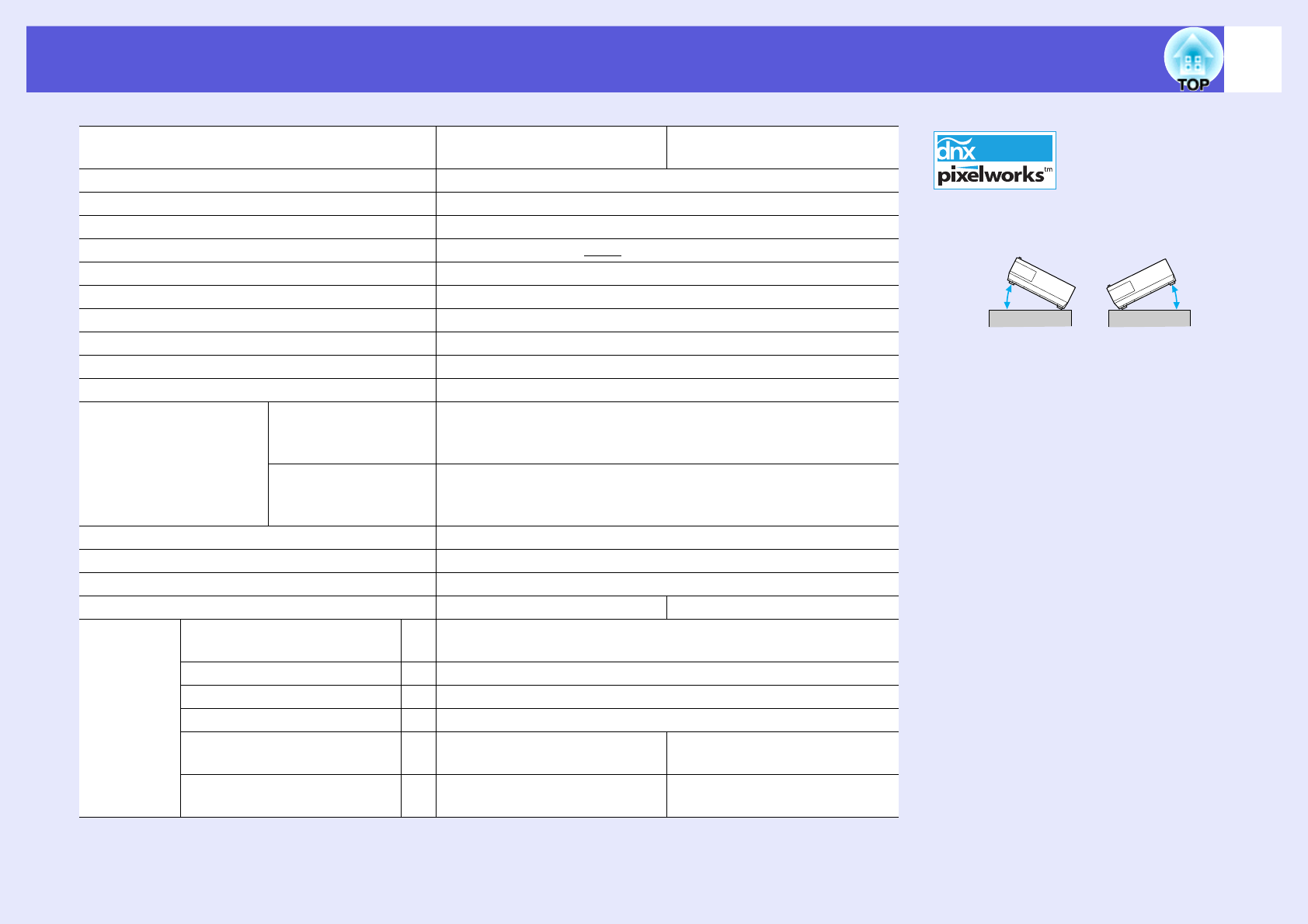
71
Specifications
Product name Multimedia Projector
EMP-1715/1705
Multimedia Projector
EMP-1710/1700 Pixelworks DNXTM ICs
are used in this projector.
Angle of tilt
If you use the projector tilted at an angle of
more than 30° it could be damaged and cause
an accident.
Dimensions 273 (W) ^ 68 (H) ^ 193 (D) mm (not including protruding parts)
Panel size 0.7"
Display method Polysilicon TFT active matrix
Resolution 786432 pixels XGAg (1,024 (W) ^ 768 (H) dots) ^ 3
Focus adjustment Manual
Zoom adjustment Manual (about 1 to 1.2)
Lamp UHE lamp, 170 W, Model No.: ELPLP38
Max. audio output 1 W monaural
Speaker 1
Power supply 100 to 200 V AC ±10%, 50/60 Hz AC 2.7 to 1.2 A
Power consumption 100 to 120 V area Operating: 244 W
Standby power consumption (network invalid): 3.8 W
Standby power consumption (network valid): 18 W
200 to 240 V area Operating: 228 W
Standby power consumption (network invalid): 5.1 W
Standby power consumption (network valid): 18 W
Operating altitude Altitude 0 to 2286 m (0 to 7500 ft)
Operating temperature 5 to 35°C (No condensation)
Storage temperature -10 to +60°C (No condensation)
Weight Approx 1.7 Kg Approx 1.6 Kg
Connectors Computer (Component Video)
port
1Mini D-Sub15-pin (female) blue
Audio port 1Stereo mini jack
S-Video port 1Mini DIN 4-pin
Video port 1RCA pin jack
USB port*1 1USB connector (Type A)
USB connector (Type B) USB connector (Type B)
USB port (exclusive wireless/
cable LAN unit)*2 1USB connector (Type A) -
*1 The USB port is not a guarantee that all USB equipment is compatible.
*2 The exclusive wireless LAN unit supplied with the projector or the optional cable LAN unit.
0° to 30°0° to 30°

Specifications 72
Safety standards
USA
UL60950-1
Canada
CSA C22.2 No.60950-1
EU
The Low Voltage Directive
(73/23/EEC)
IEC/EN60950-1
EMC standards
USA
FCC Part 15B Class B (DoC)
Canada
ICES-003 Class B
EU
The EMC Directive
(89/336/EEC)
EN55022, Class B
EN55024
IEC/EN61000-3-2
IEC/EN61000-3-3
Australia/New Zealand
AS/NZS CISPR 22:2002 Class B

Specifications 73
We : Epson America, Inc.
Located at : 3840 Kilroy Airport Way
MS: 3-13
Long Beach, CA 90806
Tel : 562-290-5254
Declare under sole responsibility that the product identified herein,
complies with 47CFR Part 2 and 15 of the FCC rules as a Class B digital
device. Each product marketed, is identical to the representative unit
tested and found to be compliant with the standards. Records maintained
continue to reflect the equipment being produced can be expected to be
within the variation accepted, due to quantity production and testing on a
statistical basis as required by 47CFR 2.909. Operation is subject to the
following two conditions :
Trade Name : EPSON
Type of Product : Projector
Model : EMP-1715/EMP-1710
EMP-1705/EMP-1700
FCC Compliance Statement
For United States Users
This equipment has been tested and found to comply with the limits for a
Class B digital device, pursuant to Part 15 of the FCC Rules. These limits are
designed to provide reasonable protection against harmful interference in a
residential installation. This equipment generates, uses, and can radiate
radio frequency energy and, if not installed and used in accordance with the
instructions, may cause harmful interference to radio or television reception.
However, there is no guarantee that interference will not occur in a particular
installation. If this equipment does cause interference to radio and television
reception, which can be determined by turning the equipment off and on, the
user is encouraged to try to correct the interference by one or more of the
following measures.
• Reorient or relocate the receiving antenna.
• Increase the separation between the equipment and receiver.
• Connect the equipment into an outlet on a circuit different from that to
which the receiver is connected.
• Consult the dealer or an experienced radio/TV technician for help.
WARNING
The connection of a non-shielded equipment interface cable to this
equipment will invalidate the FCC Certification or Declaration of this device
and may cause interference levels which exceed the limits established by the
FCC for this equipment. It is the responsibility of the user to obtain and use a
shielded equipment interface cable with this device. If this equipment has
more than one interface connector, do not leave cables connected to unused
interfaces. Changes or modifications not expressly approved by the
manufacturer could void the userís authority to operate the equipment.
FCC Radiation Exposure Statement:
The wireless LAN 802.11a/b/g adapter Model: WN6501CEP complies with
FCC radiation exposure limits set forth for an uncontrolled environment. This
device should be installed and operated with minimum distance 20 cm
between the radiator and your body.
DECLARATION of CONFORMITY
According to 47CFR, Part 2 and 15
Class B Personal Computers and Peripherals; and/or
CPU Boards and Power Supplies used with Class B
Personal Computers
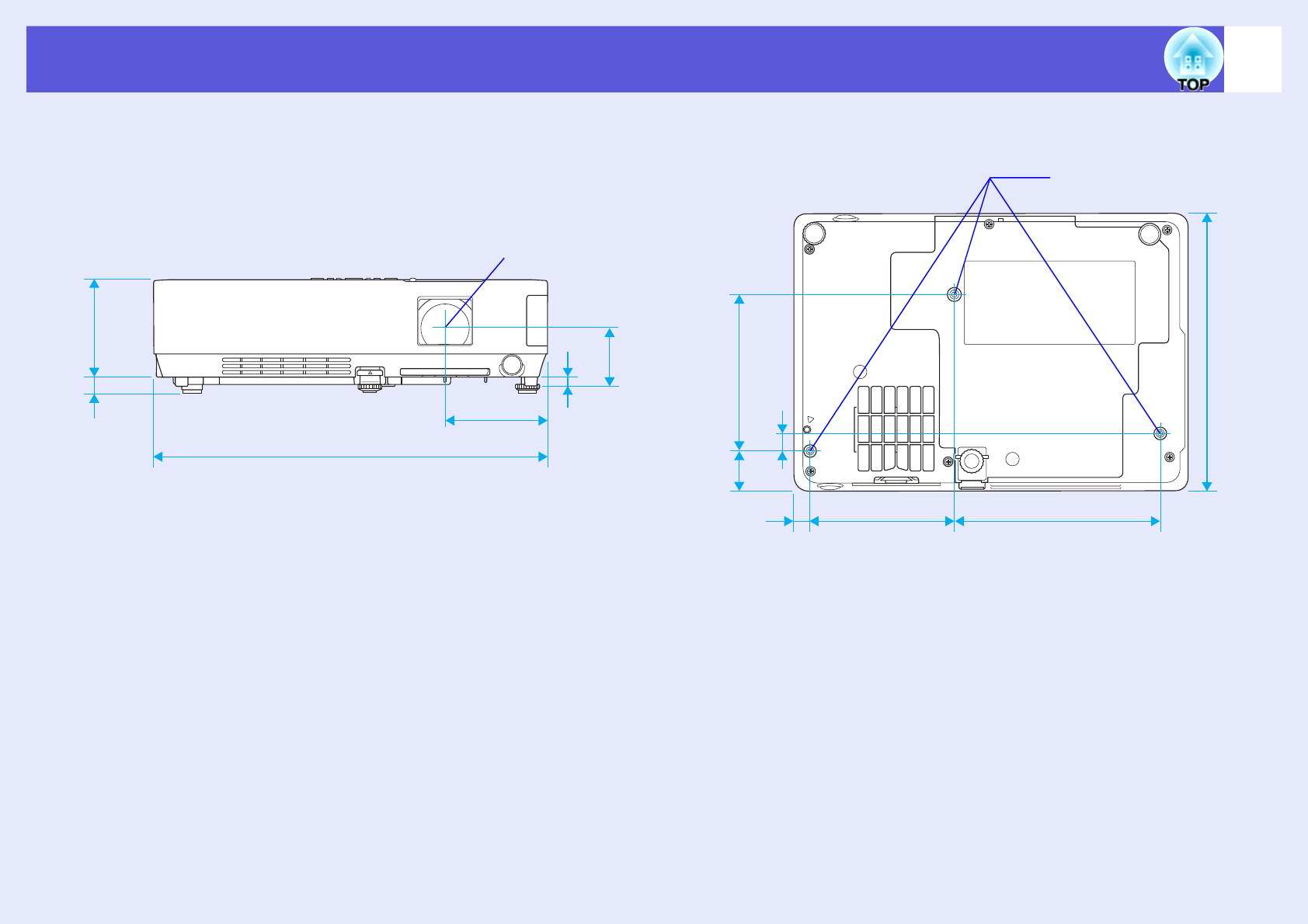
74
Appearance
Units: mm
273
39.4*
68
99.6
12
107.5
142.4
71
Centre of lens
11 6
28.5
193
11.4
* Distance from centre of lens to suspension bracket fixing point
3-M4^9

75
Index
A
A/V mute ............................................................. 16
A/V mute slide ....................................................... 6
Air exhaust vent .................................................... 6
Air filter .................................................................. 9
Air filter replacement period ................................ 59
Air intake vent ....................................................... 9
Angle of tilt .......................................................... 71
Aspect ratio ......................................................... 17
Audio port .............................................................. 8
Auto setup ........................................................... 33
B
Blackboard .......................................................... 15
Brightness ........................................................... 32
Brightness control ............................................... 34
C
Cleaning the air filter and air intake vent ............. 54
Cleaning the projector's surface .......................... 54
Color adjustment ................................................. 32
Color mode .................................................... 15, 32
Color saturation ................................................... 32
Computer input .................................................... 33
Computer port ....................................................... 8
Configuration menu ............................................. 31
Consumables ...................................................... 64
Contrast ............................................................... 32
Control panel ......................................................... 7
Cross ................................................................... 20
D
Direct power on ................................................... 36
Display ................................................................ 35
Display background ............................................. 35
E
ESC/VP21 ...........................................................67
Extended menu ...................................................35
E-zoom ................................................................19
F
Focus ring ..............................................................6
Freeze .................................................................17
Front adjustable foot ..............................................6
G
Game ...................................................................15
Glossary ..............................................................65
H
HDTV ...................................................................70
Help function ........................................................41
High altitude mode: ..............................................36
How to replace the air filter ..................................59
How to replace the lamp ......................................56
I
Image menu .........................................................32
Indicators .............................................................42
Info menu .............................................................38
Input signal ..........................................................38
K
Keystone ..............................................................34
L
Lamp cover ............................................................6
Lamp hours ......................................................... 38
Lamp indicator .................................................... 42
Lamp replacement period ................................... 56
Language ............................................................ 36
Low brightness .................................................... 34
M
Menu ................................................................... 31
Messages ............................................................ 35
Mouse pointer ..................................................... 21
N
Numeric buttons .................................................. 11
O
Operating temperature ........................................ 71
Operation ............................................................ 36
Operation lock ............................................... 29, 34
Optional accessories ........................................... 64
Overheating ........................................................ 43
P
Part names and functions ..................................... 6
Password protect ................................................ 26
Password protect sticker ..................................... 27
Photo ................................................................... 15
Pointer ................................................................. 18
Pointer shape ...................................................... 34
Position ............................................................... 33
Power indicator ................................................... 42
Power inlet ............................................................ 8
Power on protect ................................................. 26
Presentation ........................................................ 15
Problem solving .................................................. 42
Progressive ......................................................... 33
Projection ............................................................ 35

Index 76
R
Rear foot ............................................................... 9
Rear screen ......................................................... 53
Refresh rate ........................................................ 38
Remote control .............................................. 10, 20
Remote control light-emitting area ...................... 11
Remote receiver ................................................ 6, 8
Replacing batteries ............................................. 55
Request code ...................................................... 28
Reset all .............................................................. 39
Reset menu ......................................................... 39
Resetting the lamp operating time ................ 39, 58
Resize display ..................................................... 70
Resolution ..................................................... 38, 70
S
Settings menu ..................................................... 34
Sharpness ........................................................... 32
Signal menu ........................................................ 33
Sleep mode ......................................................... 36
Source ................................................................. 38
Source search ........................................... 7, 11, 13
Speaker ........................................................... 8, 63
Specifications ...................................................... 71
Sports .................................................................. 15
sRGB ................................................................... 15
Standby mode ..................................................... 36
Startup screen ..................................................... 35
Storage temperature ........................................... 71
Sub menu ............................................................ 31
Supported monitor displays ................................. 70
Suspension bracket fixing points ..................... 9, 74
S-video port ........................................................... 8
Sync info ............................................................. 38
Synchronization ................................................... 33
T
Temp indicator .....................................................42
Theatre ................................................................15
Tint .......................................................................32
Top menu ............................................................31
Tracking ...............................................................33
U
USB port ................................................................8
User's logo ...........................................................60
User's logo protect ...............................................26
V
Video port ..............................................................8
Video signal ...................................................33, 38
Volume ................................................................34
W
Wide-screen projection ........................................17
Wireless mouse ...................................................20
Z
Zoom ring ..............................................................6

77
All rights reserved. No part of this publication may be reproduced, stored
in a retrieval system, or transmitted in any form or by any means,
electronic, mechanical, photocopying, recording, or otherwise, without the
prior written permission of Seiko Epson Corporation. No patent liability is
assumed with respect to the use of the information contained herein.
Neither is any liability assumed for damages resulting from the use of the
information contained herein.
Neither Seiko Epson Corporation nor its affiliates shall be liable to the
purchaser of this product or third parties for damages, losses, costs, or
expenses incurred by the purchaser or third parties as a result of: accident,
misuse, or abuse of this product or unauthorized modifications, repairs, or
alterations to this product, or (excluding the U.S.) failure to strictly
comply with Seiko Epson Corporation's operating and maintenance
instructions.
Seiko Epson Corporation shall not be liable against any damages or
problems arising from the use of any options or any consumable products
other than those designated as Original Epson Products or Epson
Approved Products by Seiko Epson Corporation.
The contents of this guide may be changed or updated without further
notice.
Illustrations in this guide and the actual projector may differ.
General Notice:
Macintosh, Mac, and iMac are registered trademarks of Apple Computer,
Inc.
IBM is a registered trademark of International Business Machines
Corporation.
Windows, Windows NT and VGA are trademarks or registered
trademarks of Microsoft Corporation in the United States of America.
Dolby is a trademark of Dolby Laboratories.
Pixelworks and DNX are trademarks of Pixelworks, Inc.
Other product names used herein are also for identification purposes only
and may be trademarks of their respective owners. Epson disclaims any
and all rights in those marks.
This product uses open source software.
ZSEIKO EPSON CORPORATION 2006. All rights reserved.